Archives of Kissing Books
Kissing Books: Something out of the ordinary
Every month, Olivia Waite pulls back the covers, revealing the very best in new, and classic, romance. We're extending a hand to you. Won't you take it? And if you're still not sated, there's always the archives.
Holidays are points on the timeline where the ordinary world cracks open a little and something numinous filters through. In the Catholic calendar I was raised with the weeks leading up to Christmas are called Advent, which (like Lent in the spring) is officially, theologically different from the long stretch of green-robed months labeled Ordinary Time. Holidays were by definition extraordinary times.
Some holidays we fixate on more than others, as a culture. Some of those timeline cracks we take a narrative crowbar to, prying the opening wide to get more of the magic out. Christmas, for example, is always being worked at, even in tales that never breathe the name Jesus. There’s a kind of secular magic that turns up, though centering it on a Christian holiday still puts a great deal of pressure on people of other faiths. I think it’s telling that we classify Christmas stories as general fiction, even though they often feature clearly speculative elements. Mortals encounter ghosts or angels or spirits; magical objects change the course of a character’s life; supernatural agents work secretly for the betterment of all. A Christmas Carol is a time-travel book and a ghost story, though people look at you funny if you recommend it as such.
This year, heading into the darkest months, it feels like we need that magic more than usual. We need the oil to last longer than it‘s supposed to; we need ghosts to take gloomy mercy on our errors; we need a kindly supernatural hand to guide us toward a better, happier future. Maybe it’s that vast yearning that cracks open the world in the first place — you can’t make changes without first desiring change. And stories are how we come to understand what we want to be different. So many of those magical stories always seem to come back to very real, very human goodness: generosity, kindness, charity, hope, and love. It has to be more than coincidence.
There’s a scene in A Christmas Carol that almost never makes it into the adaptations: Marley, after confronting Scrooge, directs him to look out the window, where the London streets are teeming with guilty ghosts burdened by chains of greed and selfishness. They wail and weep among the homeless and hungry, and Dickens makes it clear: “The misery with them all was, clearly, that they sought to interfere, for good, in human matters, and had lost the power for ever.” The wish-fulfillment angle of this scene is not ghosts are real. It’s not even you can save yourself, chosen human. The wish-fulfillment is people can help one another in the real world.
Romance author Mary Buckell once said "if you’re writing literary fiction, you believe that people cannot change." Commercial fiction means you believe that people can change.” Half the time I believe this sentiment; half the time I want to challenge it to rapiers at dawn. But I do believe that a happy ending requires transformation. And transformations are hard. We humans are prone to entropy and sluggishness. We want to keep our compass steady, we want to stay where we’re comfortable, we want tomorrow to be predictable because then we know what to expect. We know, deep down, that to make a lasting change to habit or habitat requires more than the usual amount of motivation.
It requires, in fact, a little magic. Something out of the ordinary — an angel, a ghost, a magical Advent calendar in a TV movie. Something to help us do what we fear we’d never succeed at on our own. So we pick a date and pick up the crowbar — or a holiday story — and work to let a little more light shine through.
Recent Romances:
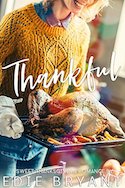
Thankful by Edie Bryant (contemporary f/bi f):
I must be honest: this book leaned a little too heavily on the misunderstandings for my taste. Don’t be an idiot! I was forced to yell silently, at more than one plot point. But allowances must be made for youth, and sometimes the perspective of thirty-seven years only weighs me down like the wettest of blankets. This book is the quintessential New Adult romance, which often feels as if the author and not only the characters are trying to find their voice. It is over-dramatic and prone to impulsive mistakes but also chock-full of what we Olds call potential — I have the oddest feeling that if I just leave this book alone to make its own choices it will grow up into something truly special.
It can’t. Because it’s a book, not a person. But I kind of wish it could.
Maybe it’s just the premise, which is so perfectly suited to my taste that it dwarfed every other objection. Heroine Danielle has had a strained relationship with her parents since leaving home (and coming out), so this year she decides to surprise them by showing up again on their doorstep in her hometown. Only they’ve moved. Out of state. Two years ago. Without telling her. And they wouldn’t have wanted her anyway, because their new condo is a bit too small for guests. It’s the absolute last straw in a long line of parental disinterest, and honestly when Danielle sat down to have a good cry on the porch it seemed like the most human thing she could have done.
But she isn’t crying long, because her former best friend Elise — who lives just across the street, with a houseful of happy extended family — finds her and demands she stay with them for the long holiday weekend. Danielle is nervous, because she always had a hopeless crush on her straight friend. Elise is nervous, because in the years since they drifted apart she’s come out as bisexual, but she’s never found anyone else who she loves as much as she loved Danielle. I’d have liked to have seen a few more scenes of our heroines interacting without the drama — the focused nature of novellas mean we’re in crisis mode most of the time, when I wanted to know how they would treat one another in, as it were, ordinary time. Holidays and family crises are states of heightened reality, which don’t always reflect someone’s daily state of being. But, on the whole, this sweet and earnest little f/f is doing okay, even if it hasn’t mastered adulting quite yet.
I’d met some great people with great qualities who, theoretically, I should have really been into. But I never was. There was never that chemistry that I desperately desired. I wanted to be with someone I loved. I wanted to be thrilled to wake up to someone in the morning and go to bed with them at night. I wanted happiness like I’d never felt it before.

A Wedding One Christmas by Therese Beharrie Carina Press: contemporary m/f):
This South African-set book is an absolute confection, but there’s a surprisingly rich and satisfying center beneath all the froth and frosting on top. Beharrie begins with a classic romance set-up: two strangers meet by chance at a wedding they have complicated feelings about. Angie is a romance writer still working through her grief about her father’s death years ago (just @ me next time, why don’t you) and Ezra is a newly heartbroken women’s studies professor (who never mansplains feminism to the heroine, thankfully) struggling to get perspective on the mistakes of relationships past. They are two people running headlong from their own pain and vulnerabilities, all of which get knotted up when they crash into one another. Like Christmas lights in a box in the garage. By the time they untangle all the separate strings, they’ve had time to start to heal and get their souls in order. And also experience the sheer, breathtaking horror conjured up by the phrase volunteer ad-libbed Nativity play.
Reader, it was appalling and hilarious and absolutely delicious.
Therese Beharrie’s buoyant voice moves like quicksilver, trading flirty banter for sharp, painful flashes of realization in an instant. It keeps the reader feeling comfortingly weightless even as she lands on truly profound questions: where is the line between independence and loneliness? Between wants and needs? How do you give yourself up to passion and generosity without sacrificing too much or leaving yourself hollow and empty? These are not problems quickly solved, as the book well knows. The story takes place in a single day but gives our hero and heroine plenty of scope for chemistry, for confrontation, and for communication. Like a stage play — or a ghostly holiday tale — where the emotional ground covered is far more extensive than the chronological space would appear to allow. Sure, it’s been one day in book time — but we’ve been there with these two for all of it. We know who they are by now, so it’s natural to believe they know each other well enough to fall a little bit in love. Sweet but not saccharine, heavy on the romance but super-light on the sex, this is one thoughtful holiday romance you won’t want to miss.
The real problem was that he wanted her. It was that plain, that simple. It had nothing to do with him going home. Or with what he’d face at home. It had everything to do with the falling. That after a day in her presence, he knew he was falling, and could only imagine what another day — a week, a month, a year — would do. He didn’t want to have to imagine. He wanted to live it. He didn’t want to say goodbye.
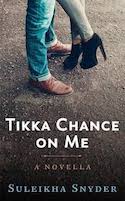
Tikka Chance on Me by Suleikha Snyder (self-published: contemporary m/f):
The power of the good girl/bad boy trope is this: the good girls are never as good as people think, and the bad boys are always secretly better than anyone gives them credit for. It’s about truth versus reputation; rumors, secrets, and hidden hopes all balled up together and heated up by conflict and chemistry.
That’s never been truer than in this sleek and perfect novella from Suleikha Snyder. Pinky Grover dropped out of grad school to help out when her mom got sick, and now slings plates in her family’s Indian restaurant, as though she never dreamed of traveling the world and studying unique cultures. Trucker Carlson was a fuck-up as a kid and now does worse as a member of the Eagles biker gang — a violent, gun-running, white supremacist outfit — but despite his poor taste in friends, Trucker can’t stay away from Mrs. Grover’s amazing samosas. Or from the daughter who serves them up. The two have no business hooking up, none at all. But months of silent eye-banging and one cheesy pickup line in a Walmart parking lot are all it takes to turn sparks into supernovas — and lord, did this book knock me down. Snyder has a way of taking two characters who are plenty interesting on their own, and making them sparkle even more brilliantly as a couple. Her sex scenes just feel like so much fun: banter and teasing and laughter, along with feelings and revelations and high-quality orgasms. It makes the breakneck pace of the romance completely plausible. “We can’t be in love this quickly,” the characters say, and the reader cries back that of course you can! Look at how good you are together!
It’s a roller coaster, with all the stomach drops and rushing adrenaline. We fall fast and hard and I for one wouldn’t have it any other way.
He wore his Eagles leathers — there was probably some kind of rule that he couldn’t take them off — but the faded T-shirt that hugged his chest sported Captain America’s shield. It seemed a little off-brand, given his choice of vocation and the company he kept.

Cinder Ella by S.T. Lynn (LoveLight Press: trans f/f):
Cinderella variants are my absolute catnip in romance — historical, fantasy, or contemporary, I like the classic shape as much as I like the twists, and I never seem to get tired of them no matter how many I read. The heart of the story is not about the prince, or not simply about the prince: it’s about a true and hopeful soul finding recognition of worth after having persevered through trials and suffering, and in spite of poverty and powerlessness. How could such a dream ever get old?
S.T. Lynn’s variant gives us a black trans heroine, making the question of recognition all the more vital. Ella has lost her mother and her father, and her social climbing stepmother insists on referring to her as Cole, her late father’s son, so Ella has to keep her true self carefully hidden unless she’s alone. Despite all the grief and heartache in her life, though, Ella is still a dreamer, still determined to find good where she can (the days she tends the gardens, pamphlets of designer dresses, her dog Lady). When she is invited to attend the ball and dance with the princess, it’s more than she ever dared hope for. This is a wide-open wish-fulfillment story, not subtle in the least and very YA-inflected, but Ella is so warmly charming that you stay with her even though you can see the strings moving, narratively speaking. The secondary characters are equally lovely, from the mischievous lady-in-waiting in love with the prince, to the small-town cheese maker and goatherd who helps Ella get back on her feet in the second act. It gave me serious nostalgia for all the semi-modern fairy-tale retellings I loved best growing up: Patricia Wrede’s Enchanted Forest Chronicles, M. M. Kaye’s The Ordinary Princess, the gorgeous film adaptation of Rogers and Hammerstein’s Cinderella starring Brandy as the lead. Sometimes you need to watch nice things happen to nice people, in spite of all the villains in the world.
Ella wasn’t sure if a woman could fall in love talking over dogs and gardening, two songs and a single kiss, but her heart was giving it a good try.
This Month’s Cult Classic

A Christmas Gone Perfectly Wrong by Cecilia Grant (self-published: historical m/f):
I love the Blackshear trilogy but until recently had let prequel novella A Christmas Gone Perfectly Wrong slip through the cracks. Turns out it’s my absolute favorite kind of Christmas story: a lonely, lovely misadventure with unexpected snow, stern souls learning to unbend, and finding warmth in places you least expect it. Eldest Blackshear sibling and general stick-in-the-mud Andrew has ventured out to the country to purchase a falcon for his soon-to-be-married sister. The falcons are trained by Baron Sharp and his daughter Lucy, who’s led a lonely if brilliantly educated life with her father for company — reading Hume, having philosophical debates, and training birds. Andrew puts the demands of family and duty above all else. Lucy yearns to know more of the world, but her father is set in his ways and doesn’t budge from his comfortable home. She has a chance to attend her first Christmas party in society, with people her own age and potential husbands — but to get there, she has to convince prim and prudish Andrew to throw propriety to the wind and drive her to her aunt’s house unchaperoned. It should be a short and simple trip, after which they will part as strangers forever.
Of course it all goes, as the title says, perfectly wrong.
There are more than a few romance authors whose status in the genre is partly due to sheer accumulation. Nora Roberts has written over two hundred titles and counting. The Romance Writers of America give their Centennial Award to members who’ve published one hundred books, and the list of names is both illustrious (shoutout to Brenda Jackson and Jayne Ann Krentz/Amanda Quick!) and surprisingly lengthy.
And then there’s Cecilia Grant.
There’s a much-mangled quote about the Velvet Underground: that they didn’t sell many records, but that every single person who bought one went out and started a band. Since her debut in 2012 Cecilia Grant has published three novels and a holiday novella — certainly not nothing, but quantifiably on the low end by romance’s ravenous standards. Yet those four stories inevitably crop up on best-of lists, in Twitter recommendation threads, and in conversations at conventions and Instagram feeds. People will occasionally ask each other if she’s still writing — because even nearly five years after her final novella appeared, they’re still hungry for more of her stories, more of her characters. She’s one of the rare authors who works both for longtime romance readers and for people brand new to the genre. If there is such a thing as a romance cult author, Cecilia Grant is it.
Trouble found him, in torrents that put the winter squall to shame.
Kissing Books: Romancelandia
Every month, Olivia Waite pulls back the covers, revealing the very best in new, and classic, romance. We're extending a hand to you. Won't you take it? And if you're still not sated, there's always the archives.
Writers like to say say there are only so many basic plots in the world. (The exact number varies depending on who you ask.) It can be illuminating to consider these broad categories, imperfect though they may be. Especially when we pair them with equally broad categories of setting. Sometimes when you’re trying to trace romance taxonomy you have to step back and squint a little at the outlines.
London-set romances are frequently Person Versus Person: they turn on questions of inheritance, alliance, status, power, and secrets. Ballrooms and bedrooms figure so prominently because they’re where people come together for social and sexual intercourse — but even those rare and refreshing stories that center lower- and working-class Londoners as well as the upper crust (recent reviews of KJ Charles, Cat Sebastian, and Jude Lucens come to mind) have a distinctly societal bent. These books are about people as a super-organism, as busy and interdependent as a hive of bees in honey season. They ask how we exist in relationship to one another. Duty, honor, and obligation, all social forces, crop up like caltrops in the path of true love.
Historical romances in the American West, on the other hand, are commonly more concerned with Person Versus Environment: turning a piece of land into a town, mining precious metals, raising cattle, eradicating the natives (who are not given room to exist as People in many of these stories). We see towns and cities but as newborn ideas, sketches of the maps we know — these places are works in progress, mere gestures waving at the future inhabited by the reader. Most Westerns these days show up in inspirational romance, though there’s a stubborn, inclusive streak of queer and race-aware historicals that I for one would love to see explored more often. Especially since the environment in America is so often hostile to marginalized folks — and this can be a satisfying framework for a romance. For example: Sharon Cullars’ Gold Mountain and Backwards to Oregon by Jae, or one of Beverly Jenkins’ small town Western settings (have you read Forbidden yet??? it is perfection).
And then we turn to New York. And things get complicated.
Though there are standout historical gems to be found in this setting (Joanna Shupe, of course, and the EE Ottoman novella reviewed below) New York-set romances are largely contemporaries: the Harlequin Presents-type billionaire bent on revenging himself on his ex-business partner’s daughter, the secretly kinky CEO whose polished exterior hides a messy, wounded Dom, the sweet but ambitious heroine determined to make it in the hustle of America’s largest and most quintessentially American city. At first you might think that geography aside there’s little common ground between sweet Sarah Morgan rom-coms, the acid-tongued chick-lit trend of the 90s, and the seemingly endless wave of erotic or New Adult romances with dramatically lit covers and miles of tortured backstory — but then you look past the differences in tone, and you realize that all these arcs are very much the epitome of the plot known as Person Versus Self. It’s a story about recognizing and reconciling identities. Who are you really? Who do you want to be? There’s a Surface New York, a mythical place developed in a thousand books and films and tv shows, that presents the city as a canvas against which individual characters prove their greatness. (This is by no means limited to the romance genre: looking at you, every Great American Novelist.) The soaring, populous, silver-glass skyline becomes a mirror in which our main characters learn to better see their own outlines. Even in romances that take care to push past that shiny surface, the core arc is preserved — such as in Alyssa Cole’s A Princess in Theory, which presents us a much more nuanced glimpse into the city’s real-life demographics. Ledi and Thabiso/Jamal both have to alter their conceptions of who they essentially are before they can truly open their hearts to one another.
And of course, true to Romancelandia, as soon as we try to establish a rule we find plenty of exceptions that shatter it. This month’s books include a historical New York-set novella, a Regency that explores some of what it means to be black among the British aristocracy, a bicoastal f/f romance, a British small-town paranormal, and a Cornwall Regency miss who’s taken up smuggling for all the right reasons, naturally. Because even in romance, where setting looms large, geography is not entirely destiny.
Recent Romances:

The Craft of Love by EE Ottoman (self-published: trans m/bi f):
A trans silversmith and a heartbroken quiltmaker meet and fall in love in Gilded Age New York. They admire one another’s work and designs. They admire one another’s kindness and intellectual pursuits. The merest brush of hands makes their hearts flutter and gazes grow intense. Eventually, they confess their feelings. On paper it sounds like there’s not enough conflict to sustain even so short a story as this one. In practice, though, it’s as wildly engrossing and terrifying as the first time you look at someone and wonder: She’s so amazing—what could she possibly see in me?
Silversmith Benjamin Lewis is on the mend from a long illness, itching to get back to his smithy. While puttering about the house he discovers a cache of dresses made for him by his late mother: beautiful embroidery, but made for a person who Benjamin never truly was meant to be. But the fabric is valuable and the embroidery truly spectacular, so his sister encourages him to have the dresses turned into a quilt of some kind. She believes this could help Ben come to terms a little with his complicated feelings about his mother and their fraught relationship.
Quiltmaker Remembrance Quincy (oh, such a name!) has kept her heart guarded ever since her friend and beloved Hope abandoned her. She is drawn to Mr. Lewis’ gentle nature and warm regard — and figures out the truth of his particular identity without having to be told — but she is not sure if she wants to risk her heart again, when it was such a painful experience the first time. The two talk, and go on walks, and meet one another’s families, and their feelings blossom little by little. All while we catch glimpses of the early labor movement, Abolitionist debate, and the switch from sail power to steam. It’s a narrow window, but a lovely view.
This novella is as slender and delicate as a line of feather stitch in linen thread — and is just as quietly strong. It has the careful, deliberate kindness of voice I have come to associate with trans romances from authors like Austin Chant and RoAnn Sylver — though admittedly self-selection might be responsible for what looks like a trait of the subgenre. It’s not only that I’ve grown tired of grimdark, and misery for misery’s sake, in my fictional worlds. Reader praise of a book so often sounds like violence: we talk about our hearts being wrecked, about stories that kill us, about sadistic authors who torture and murder us as well as their characters. And that can often be quite fun! But it’s just as important to have something sweet, something kind, something healing to read when we’re sick down to our souls. This book will not hurt you. It will not tax you. This book is a warm cup of cider to soothe your aching hands, as you gently blow the steam away over the rim. Perfect for the cold days and busy holidays to come.
When she thought of him as he had been the night he’d walked her home, it made her heart quicken. There was a sweetness to him, a gentle patience that made her want to make him smile, to say clever things that would make his eyes shine. When she remembered their walk together and his visit to her workshop, she couldn’t help thinking of the movement of his strong hands, the shape of his mouth, and the long lines of his body. She wanted to see him relaxed and comfortable in shirtsleeves and with tousled hair, watch him play with his little nephew, and hear him laugh.
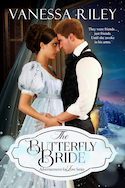
The Butterfly Bride by Vanessa Riley (Entangled: historical m/f):
To read Vanessa Riley is to feel the drape of lace against your wrists, as the rich scent of antique perfume fills the air. It’s transportive, is what I’m saying, over and above the usual. It’s a rare author who can write books that feel properly vintage without being stuffy, and it was terribly easy to lose myself in the author’s poetic, crystalline cadences.
Miss Frederica Burghley is the biracial bastard daughter of a notorious courtesan and a duke; she is illegitimate but acknowledged, a privileged but precarious position. Jasper is Viscount Hartwell, a widower still devastated by the loss of his beloved first wife, and burdened by three unruly daughters who are the terror of their many governesses. Jasper and Frederica wake up in bed together, fuzzy-headed, the day after Frederica’s father’s wedding. They have no memory of how they wound up there — except Frederica’s horrified recollection of bits and pieces of the night before: a hand breaking through her window, a whispered threat, a stolen jewel-box, and the ruins of a wardrobe viciously slashed to pieces. The duke and his new duchess will not put off their honeymoon, so the duke asks Hartwell to protect his daughter while he’s gone. Meanwhile Frederica plans to get herself quickly and properly married so the possessive thief will stop threatening her dearest friends and relations. Hartwell thinks this is a terrible idea — he’s not wrong. Frederica thinks Hartwell’s still too much in love with his first wife to give his heart easily — she’s right. There are weddings and suitors and a lot of meaningful piano playing, and (small content note) an emphasis on the dangers of historical childbirth that is both stark and refreshing in a genre that so often presents pregnancy as a wondrous miracle and gift, rather than the hugely risky undertaking it was in the days before ultrasounds, antibiotics, and regular hand-washing.
So yes, this book has a lot going on — but it feels deliberately layered, baroque rather than busy. And a soupçon of Grand Guignol at the end, to make the reader’s heart lurch with fear. This is the kind of romance plot where people stick stubbornly to painful decisions even after their hearts have realized the anguished truth; you kind of want to shake them, but in a good way. I was frequently reduced to keeling over on the couch and yelling argh out of sheer enjoyable frustration. Frederica in particular is a heartbreaker: lonely and fiercely brilliant but unsure of her place in the world, thanks to a rather unfeeling father and an awareness of how thin the ice she skates on truly is. She deserves every care and attention and it was a delight watching Hartwell slowly come to the same conclusion. This is surely a book to savor with a glass of fine brandy and a snowy window view; and how decadent that there are two prior books in the series for when you happily sigh and set this one aside!
Their gazes locked. He was on his knees, her hand pressed to his. If the carriage stopped, people would get the wrong idea. The question was, would he care?
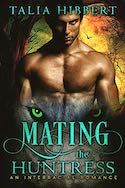
Mating the Huntress by Talia Hibbert (self-published: paranormal m/f):
It’s the spooky season! I have to review at least one paranormal! But I am extremely picky about my paranormals, especially where shifters and fated mate tropes are concerned. Thankfully, Talia Hibbert (with whom I now share an agent, full disclosure) surprised us with a silly, sexy little paranormal and as always it’s a damn delight.
Luke is a Werewolf. A slavering, ravening monster, designed to prowl the night and tear the throats out of unwary humans. He’s strong. He’s fast. He’s nearly impossible to kill. Any reasonable woman would run screaming rather than follow him back to his cabin in the middle of a dark and lonely wood. But Chastity Adorno is no ordinary woman. She’s a huntress — well, she would be, if her family would let her join them on their killing nights. Something about a prophecy at her birth has left them a little overprotective. It grates on her nerves. So when a Werewolf starts showing up at her coffee shop, looking all human and sexy and shy despite being a monster, she thinks it’s her chance to finally get a kill and take her proper place among her sisters. She agrees to a date, and straps a silver dagger to her thigh.
Any romance reader steeples her fingers at this point and waits for it all to go beautifully, wonderfully wrong.
Paranormal romances trade in power metaphors — so most of the time most of the power ends up with the hero. (At least in het romances: I don’t have a strong sense yet of similar patterns in queer romance. But I’m working on it!) He’s often rich and immortal as well as super-strong both physically and magically. But I find I’m happier with paranormals that Take care to even the scales: Isabel Cooper’s dragons (both heroes and heroines), Shelly Laurenston’s alpha shifter heroines (just as murderous and horny as the dudes, and so fucking funny), and Alisha Rai’s witty, wicked Persephone retelling Hot as Hades. And we can definitely add Mating the Huntress to the list, because our huge, lurking, slavering, unkillable Were is almost instantly revealed to also be a comforting, attentive, eager-to-please bundle of joy. Who loves how tough and grumpy and violent the heroine is. There’s a particular type of hero I’ve come to call the Sex Puppy: hot, cheerful, usually funny but not too bright, and absolutely here for the heroine’s pleasure and happiness, exactly as she wants it, no more, no less. It’s a fun, comforting archetype, and this Werewolf is the Sex Puppiest shifter of them all. This book is a piece of pure paranormal candy, and I for one am here for any other glimpses into this world.
Christ, she wasn’t shy at all, was she? The hesitation, the demure smiles and lowered lashes — it had all been a trap. She wasn’t sweet or gentle or biddable. She was a bloodthirsty fucking murderer.
His heart sang.
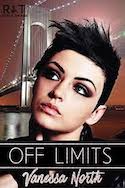
Off Limits by Vanessa North (self-published: bi f/pan f):
I can scoff about Romancelandia dukes and billionaires all day, but you wave a half-glam, half-punk queer romance at me and all my capitalist criticisms go right out the window. Charity balls, sweaty concerts in dive bars, Hollywood celebrity exes, a glitzy and gay New York: I was totally in. This book is the first of a multi-author series set in two high-class queer women’s clubs: the Thorns in New York, and the Rose in LA. It’s stylish and sexy and sharp as all hell. I positively reveled in it.
Natalie is both a buttoned-up concierge for the Thorns and, as Nat, the lead singer of a sexy, angry, queer-as-hell punk band with a standing gig at a pub called the Bridgewater. Rebecca Horvath is a trust-fund kid, the child of Hollywood royalty — and, as a club member at Thorns, completely off-limits for Nat. (Hey, that’s the book title!) But sizzling chemistry, a criminal scheme, and Bex’s dad’s rush wedding conspire to throw them together over and over, and it’s no surprise when they give in and tumble into bed together. Nat is all edges and anxiety beneath her mask of control, and Bex is delicate as spun glass beneath her rich-girl polish, so their romance is less of a climb and more of a roller coaster as they try to find their footing in a world that honestly feels like near-chaos at all times. It left me breathless. The plot is full-throttle drama, every scene risking something or tightening a different piece of the tension — strong content note for a secondary character’s fairly intense suicide attempt — and I absolutely burned through the pages before I knew it. My one quibble is that after all the agony, the ending felt just a shade too easy. If you’ve enjoyed Anna Zabo’s queer rock romances, this is for sure the next thing you’ll want to pick up.
At the club, she’s invisible. On stage, she’s a giant. At home — mine or hers — she’s the light in every room and the warmth in the radiators. Without her, the bed is cold and the rooms are lonely, and I feel the weight of her uncle’s disapproval every time I glance at the photos on the walls.
This Month’s Historical Heroine Who Resorts to Smuggling for All the Noblest Reasons, Obviously:

Counting on a Countess by Eva Leigh (Avon Books: historical m/f):
I am shamefully behind in my collection of Eva Leigh books, but I buy every one as soon as I can because I’ve been reading her for a decade and there’s just something about the way she structures her plots that slips under my skin and gets my mental wheels turning every time. Continuing the trend, Counting on a Countess is a romantic meditation on the relationship between any individual and the state’s legal code. In particular, this romance uses the weight and weirdness of British law to anchor a fictive argument about the difference between laws-as-rules, and laws-as-social-obligations. Like my current favorite sitcom The Good Place, this book asks what we owe to each other while taking a blunt, critical look at a legal system that is both unyieldingly powerful and cruelly capricious.
We first meet our hero, Waterloo veteran and newly minted earl Kit Ellingsworth, cheerfully drunk and about to bang two — yup, two! — very willing opera-dancers. Kit has vague plans of building a pleasure-garden to chase away the shadowy memories of war, so he is first elated and then appalled to learn he will inherit his late commander’s fortune — but only if he marries within the next thirty days. At once we shift to our heroine Tamsyn Pearce, a bold Cornish smuggler who‘s wondering whether or not her new fence might want to kill her. Tamsyn took up smuggling to help her struggling hometown survive in the harsh economy of the Napoleonic Wars — but now her jerk uncle is planning to sell the manor house where they hide the French lace and brandy, and all her usual partners have bowed out for fear of discovery. She’s come to London to try and find a new buyer for the latest shipment, but when she’s turned down yet again she comes up with a new plan: she’ll marry a man with money.
Both Kit and Tamsyn have run afoul of the law, but with different intentions and with vastly different stakes. Kit is dismayed by the conditions of the will but the money is not a matter of life or death for him. Tamsyn, on the other hand, is fighting to keep her townsfolk from starving: the fishing hauls have been terrible and the post-war taxes burdensome. She fears being killed by the criminals she works with, but also knows that the law does not ensure her survival. This profound mismatch between Kit and Tamsyn creates friction, which keeps the plot engine turning — especially once the lawyers reveal a codicil to the will that makes all Kit’s financial decisions subject to Tamsyn’s approval. Which of course is something a wife is expected to endure, but which as a husband Kit finds deeply unjust, so now we have another layer poking at the relationship between doing what’s lawful and doing what’s right. It gave my brain plenty of fodder for analysis, just when I needed it. There are a few quibbles I had with the book by the end, but listing those would feel like pointing out that you don’t really like the floral print on this amazingly well-sprung and comfortable armchair. Sometimes a well-designed structure trumps everything.
“I’m … more wild than tame. If I had to choose between a ballroom and the prow of a fishing boat, I’d take the fishing boat every time.”
And because the author name-checked Penzance once and my brain took the reference and ran with it:
Kit is the very model of a romance hero veteran
He wants to build a pleasure garden that he can feel better in
He has to marry quickly to ensure financial solvency
But debutantes are wary of his rampant alcoholency.
Our Tamsyn is a country girl who cares about her neighborhood
She knows that smuggling earns her more than honest, legal labor would
She needs to buy a manor house to hide her lace and brandy in
Which leaves her little left to spend on Kit’s unending dandyin’
They marry for the money but that’s not the only thing they spend
There’s quite a lot of angsty plot before they reach the happy end
In short when he decides that love there’s really nothing better than
Kit is the very model of a romance hero veteran.
Kissing Books: Emotional nutrition and narrative sustenance
Every month, Olivia Waite pulls back the covers, revealing the very best in new, and classic, romance. We're extending a hand to you. Won't you take it? And if you're still not sated, there's always the archives.
The difficulty with writing happy endings these days isn’t just that it takes more effort to imagine happiness. The challenge is that all of this feels so endless.
I write this at the height of the Kavanaugh nomination and its procedural chaos — but by the time you read it there will undoubtedly have been another crisis, another tipping point that has us shivering and shaking and shouting into our phones. Humans are a narrative species, and we use stories to make sense of what we see happening around us. Dr. Ford tearfully recalling the worst experience of her life — while dozens of white, old, thin-lipped men sat by unmoved — looked like the climactic setpiece from any courtroom procedural of the past thirty years, or the Dolores Umbridge/Ministry of Magic scenes from Harry Potter. Kavanaugh’s self-aggrieved tantrum was a high school thespian’s reenactment of Nicholson’s rage-induced breakdown in A Few Good Men. It is not that we reach for fiction because we are incapable of facing reality on its own terms: we look for these parallels because we desperately need to know what might happen next. So we can prepare for it.
But this administration gives us no respite and no resolution. Everything is nonsense; causes don’t recognize their effects. Kavanaugh was voted forward — or not? Pending an FBI investigation? — and it may have been something we helped make happen? Or not? Is Jeff Flake just three Ouija boards stacked in a trenchcoat, or has something meaningful been done to steer this travesty from its worst outcome? Meanwhile hundreds of immigrant children have yet to be returned to their anxious parents, Flint still doesn’t have clean water, gerrymandering and voter suppression are denying civil rights to millions, Puerto Rico still struggles to recover from last year’s hurricane, regulation rollbacks open parks to drilling and remove safety standards from the food chain, disability and medical bills bankrupt more people, police brutality against black Americans continues unchecked, the ACA is under open threat, the Mueller investigation is doing whatever it is the Mueller investigation is doing, the new federal budget slashes millions from Medicaid and Medicare, and so on and so on and so on. There are stories I’m forgetting or that I’ve missed. We can’t get a handle on everything because it’s too much, and we can’t disengage because so much of it is quite literally life or death stakes. It is a viral attack on the public consciousness, with intent to disarm and overwhelm.
The idea that a crisis could actually just be over feels like an old-fashioned luxury. They are using our capacity to care about one another as a weapon against us. It’s evil. I am so constantly furious about this it’s a wonder my hair has not turned into a tangle of hissing snakes.
Assailed by too many competing stories, we select narratives in self-defense. Women and survivors across my timelines are posting shots of Judith and Holofernes, Wonder Woman, Xena. We are going over the movies and media we watched in our youth — Sixteen Candles and Revenge of the Nerds have been name-checked time and again — to offer concrete, pre-understood examples of what we’ve experienced. We’re searching for better stories, for comfort: the number of posts I’ve seen asking for f/f romance recs has trebled, at least. I believe this is no small part of the momentum behind the new wave of romantic comedies we’re seeing across film and streaming services. People are looking for better answers at the same time as they’re looking for ways of feeling less hopeless, exhausted, and confused.
Romance novels bring moral clarity and resolution like it’s going out of style. Here are our heroes and heroines: they may not be the best people right now, but they’re going to get better. And then they’ll be rewarded. Their struggles will cease. We can and will argue all day about what kind of character can legitimately be set up as a hero or heroine (some authors just cannot resist a Nazi redemption arc, ugh) but we can’t argue about the skeleton underneath. At this point picking up a romance doesn’t feel escapist anymore — or else it’s escapist the way that it would be escapist to consume coleslaw or citrus on a long sea voyage to keep scurvy at bay. More than anything, romance novels make it safe and rewarding to care about the characters you meet. Emotional nutrition. Narrative sustenance. There is something we need to thrive, and the cultural environment is deliberately denying it: we have to look for it elsewhere. Even the dinosaurs in Jurassic Park found ways to get around the lysine contingency meant to keep them captive. (You can picture me as a Velociraptor sniffing at the door, tapping my talons thoughtfully as I stalk the shadowed aisles of an industrial kitchen.)
This month’s column brings you two queer romances, two feminist historical novellas, a Miami-set contemporary, and a creepy little masterpiece where a Victorian magician falls in love with a futuristic assassin of eldritch horrors. Pick your poison. Take your medicine. Rest a little, then get back up and show these fuckers how strong we really are.
Recent Romances:
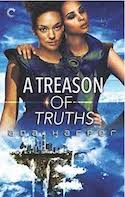
A Treason of Truths by Ada Harper (Carina Press: science fiction f/f)
Sci-fi romance is one of the hardest genre blends to get right. It requires the emotional arc between the protagonists to be as fully fleshed-out as the speculative twists of the plot. But when it’s done well it feels more complete than either genre alone: richer than technofiction, and more transportive than real-world romance. I’ve seen it done well before, but I’ve rarely seen it done this well, and damn if I’m not a little awed. A Treason of Truths is the sequel to the complex and gripping A Conspiracy of Whispers, and unlike most romance series these should definitely be read in proper order. The first book sets up the players and politics of Harper’s futuristic post-Crisis world — while giving us a sizzling romance between an Imperial prince and a prickly assassin from the dystopia next door — and this second book comes along to revel in the consequences. The fun of high-tech espionage, shady moral politics, and one of the best takes I’ve seen on the Fated Mates trope make these books an experience that shouldn’t be missed.
Empires live and die on the trading of secrets, and the family-bloodline-focused, gilt-plated Quillian Empire’s greatest spy is Lyre (aka the Liar, if you’re nasty). But Lyre has unsuspected secrets of her own: one, that she’s a rogue runaway from the floating Cloud Vault, a city-sized hoard of pre-Crisis knowledge and self-appointed technocrats who mostly steer clear of earthbound politics; two, that she’s helplessly, painfully, and irrevocably in love with the empress she serves.
Empress Sabine lost an eye in a failed coup attempt supported by a rival government — um, spoilers for book one — but it doesn’t take two eyes to see a trap when the Cloud Vault unusually offers to host peace negotiations. What follows is a stunning series of threats, rescues, escapes, betrayals, and revelations aboard a shining, tarnished and utterly creepy floating ship-city. Nanobots poison the bloodstream and turn people’s own bodies against them, mechanical moths scan every pipeline and passage for runaways, and eerie nightsbane-wolf crosses lurk in the shadows of the city’s forgotten underworld. All this plus a brutal, angst-filled, heart-twisting romance between two stubborn, wary, complicated women who can deceive everyone but one another.
If there is a book three someday I will shout my delight to the heavens.
A declaration — of need, of more than a need, of feeling — no, that was never supposed to be in the cards, but Lyre was a professional. She could cut her heart out for the game. She’d done it before. Working in intelligence meant carrying your own homeland inside you, soil to absorb it all until you could bleed in private. She’d thought she could control the reaction.
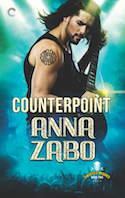
Counterpoint by Anna Zabo (Carina Press: contemporary m/pan m):
The real fantasy in romance is someone who sees you, and wants you, and loves you as you are. This fantasy has double the power in queer romance, which because of our culture has to traffic in a certain amount of invisibility. KJ Charles and Cat Sebastian’s m/m historicals make clear the risk a hero takes even in expressing interest in another man. Making queer desire visible can be fatal. Mx Zabo’s contemporaries deal in other kinds of erasure, within modern queer culture as well as around it: mental illness, kink and queer stereotypes, asexuality, public versus private personas. They have a glorious way of bringing to life the delicate give and take of a good seduction. Everything is carefully, thoughtfully, beautifully done — and all the hotter because of that. Of course, it helps that this series’ brand of kink is the cerebral, generous, ropes-and-leather command-and-obey kind (my favorite!) rather than the sadistic dungeon-full-of-spikes-and-whips kind. Give me a caring top who can dominate in a daytime hipster café with nothing but a piece of lemon meringue on a fork, and I’m one happy camper.
Domino Grinder is the guitarist for Twisted Wishes, a rock band on the upswing after an eventful whirlwind tour (shown in Mx Zabo’s excellent Syncopation). He curates the tattooed, spike-collared, bad-boy image carefully to protect his other self: shy, bookish, and submissive Dominic Bradley, who likes to put on bow ties and sweater-vests and cruise for handsome intellectual types. Such a man is pansexual programmer Adrian Doran, who knows lovely, expressive, wide-eyed, tie-me-up-please Dominic is just the kind of man he could fall for, and hard. But Dom is profoundly hesitant to reveal his other existence as Domino: not only because it’s a closely-guarded secret he fears will be leaked to the media, and not only because he thinks dommy Adrian would have no interest in brash, cocky, surly Domino (wrong! the reader wails internally). Mostly because Dom doesn’t know whether Dominic or Domino is the real one, his authentic self. For his part Adrian is dealing with being undermined and having his work essentially stolen by a newer, bro-ier programmer, and is in really no place to navigate a lover keeping a very big, very hurtful secret. This is the story of two complicated men who want and need each other desperately, and who are painfully careful and anxious about taking each step forward. Watching all the internal and external threads unspool, knots together, and ultimately release is an absolute pleasure.
“I’m in way over my head.”
“Shh.”
Adrian’s brow furrowed.
“So am I.” Dom closed his eyes. Oh fucking hell. He was gonna fall in love with Adrian. After two damn dates. That wasn’t safe and it wasn’t fair at all.

Miss Brodie’s Academy for Exceptional Young Ladies by Theresa Romain and Shana Galen (self-published: two historical m/f novellas):
Second-chance romance is a tricksy thing at novella length. On the one hand it lets us skip all the problem parts of the relationship and get right to the reconciliation. On the other hand…it lets us skip all the problem parts of the relationship, which is often where a lot of the tension and drama and heart-twisting feelings are generated. This volume features a pair of novellas in the quintessential modern Regency style, where a strong woman has carved out a feminist space within an overtly patriarchal world. Both are connected to the worlds of each author’s existing series — but only one left me wanting to explore more.
Shana Galen’s “Counterfeit Scandal” is a spy story without any spying, whose plot shows us neither counterfeiting nor a scandal. Hero Caleb worked for the Foreign Office during the Napoleonic Wars, embedded in a high position with the French army. He wreaked so much havoc that there is still a price on his head, so he lives quietly in a boarding-house in London. Heroine Bridget learned she was pregnant (!), married someone else (!!), and ended up in debtor’s prison (!!!) after the Foreign Office told her Caleb had died abroad (!!!!). Now she teaches art and forgery at an exclusive and very unusual academy. The two reunite by happenstance as Bridget searches for their son, who is somewhere in one of London’s many orphanages. Unfortunately, it’s clear we are watching this couple most closely at the least eventful part of their lives. Both the earlier Napoleon-and-debtor’s-prison sections or the reunited family’s sailing voyage to Canada seem like they’d have been stronger story fodder. (Imagine being on a long sailing voyage with your ex who you thought was dead, and the young son who only barely remembers you. And you have to pretend to be a happy family!) It made me wonder if there were just things I’d missed as someone who hasn’t read the author’s other books: there was a ghostly sense of weights and meanings that I ought to have felt in certain scenes, like hearing an inside joke where you don’t understand the reference.
Perhaps the unreality if the second story wouldn’t have felt so jarring if the first story hadn’t been so inviting and grounded and vivid. Theresa Romain’s “The Way to a Gentleman’s Heart” features academy cook Marianne Redfern as a heroine, and we’re treated to a bevy of concrete, anchoring details about recipes, cooking prep, budgeting, grocery shopping, and staffing issues. The crisis of how to plan a banquet when you’re understaffed feels more urgent than any of the vague espionage of the second novella. Food is one of the most irresistible things in fiction; it always means something culturally or emotionally or politically, so this story feels full of hooks that snag the heart. At one point hero Jack Grahame scours London’s markets to bring Marianne fresh honeycomb, just like they used to share as country lovers in years past. I just about swooned myself into a puddle on the floor, and it’s a great example of using a shorter story to give new readers a view into an established world. I wanted to move in at once, and order dinner.
He’d always liked her eyes. In a face as calm as any cameo painting, her changeable eyes had betrayed her true feelings. If he read their green depths correctly now, he’d caught her by surprise, and she wanted to flay him alive.
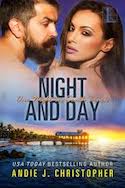
Night and Day by Andie J Christopher (Lyrical Press: contemporary m/f):
After the uncommon stress of the past few weeks, who’d have thought I’d enjoy a romance so much when it steers hard into questions of workplace affairs, abusive parents, and domestic violence? But such is the magic of a talented author: I was entranced.
Letty Gonzalez is hurt, angry, and desperate for a job: her art-festival-running ex dumped her and fired her when it turned out he couldn’t use her to access the family fortune. He also told her she was too fat for him to love, which tied in horribly to her issues with her fat-shaming mom and supermodel sister. Max Delgado is a grumpy sculptor with a simmering temper always on the verge of boiling over. He’s closed himself off for fear of becoming too much like his abusive father, and he’s only really able to express himself by heating and bending metal into abstract shapes. He also has a meddlesome, delightfully frank matchmaking grandma who I loved to pieces: Grandma Lola has decided Letty and Max would suit perfectly, so she fakes an email from Max hiring Letty as an assistant.
Letty shows up on the day Max is expecting a model for a sitting, so first thing right off the bat he demands she remove her clothes. And we’re off!
So many things in this book are messy: anger, pain, lust, fear, dysfunctional families. Letty’s wary of getting involved with another one of her bosses. Max is wary of losing control and hurting a woman he cares about. But the chemistry is stupid hot — and very palpable in the text, so it feels like a real problem and not a plot excuse — so even when both characters are just balls of electric insecurities, you’re rooting for them to figure it out and get back into bed already. Letty deserves orgasms! Max is ready to provide! She desperately needs to take care of someone, and he very much needs caring for! And the sexy bits are some of the most glorious filth I’ve read in a while: juicy, bawdy, slippery good fun. At the same time, the book puts the consent-and-power-dynamics questions of workplace harassment front and center, which is to say: how do you trust this motherfucker not to turn into a motherfucker like the last one? Consent is negotiated, offered, and withdrawn; boundaries are crossed, rethought, and reestablished. At the end of the book, after so many huge feelings and fuck-ups, I felt cleansed, wrung out, and excited about where our couple ended up. This was my first Andie J Christopher, but I promise you it’s not going to be my last.
When she brought the cups into the living room, she caught the tail end of Lola saying something like, “I didn’t come all the way over to Coconut Grove to watch you fuck this up.”
This Month’s Time-Travelling, Eldritch Horror-Slaying Heroine With A Gun Fueled by Her Own Blood And Incandescent Rage
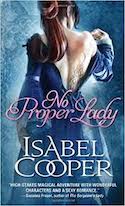
No Proper Lady by Isabel Cooper (Sourcebooks: historical paranormal m/f):
This book was once pitched to me as Terminator meets My Fair Lady, and if you’re not already leaping for the buy button I don’t even know what we’re doing here.
Listen, there are just times when the most relatable heroine around is a gritty, wounded, half-starved, relentless assassin who has given up everything to come back in time and kill history’s greatest villain. Joan, daughter of Arthur and Leia, is humankind’s last hope. She has been sent back from the year 2188, a time when amorphous tentacular demons have taken over the earth and humanity’s remnants cower underground in the hope of surviving just one more muddy, miserable, sunless day. The man who started this all is Alex Reynell, a Victorian-era magician who possessed a book that let him open the doors to the demon world, destroying Earth and nearly everyone on it.
Joan of course has come to kill him. But first she has to find him.
She lands on the estate of magician Simon Grenville, who offers her shelter after she saves his life. Simon happens to be a former friend of Reynell, at least until Reynell started studying some of the really icky dark magics, so as Simon comes to believe Joan’s outlandish tale the two try to come up with ways to get Joan near Alex. Reynell moves in the highest circles of society — so naturally Joan has to learn to blend in with the aristocrats, which is where the My Fair Lady bit comes in. Meanwhile Joan is having a hard time adjusting to a world where gender roles are rigid but there is a shocking abundance of food and air and sunlight; she also painfully mourns the loss of her family, since it will be impossible for her to return to the future. Assuming it even exists once she’s done her job, that she doesn’t just wink out of existence as the last scrap of paradox. This book is darkly hopeful. This book is eerie. This book is one of the best fantasy romances I’ve ever read, and I cannot recommend it highly enough this Halloween season.
“Women are people,” she said calmly and cheerfully. “People are bastards. And someone who’s caged — no matter how pretty the bars are — is going to get bored and restless and go for the only entertainment she can. Even if that’s catching men.”
Kissing Books: judging the book by its...
Every month, Olivia Waite pulls back the covers, revealing the very best in new, and classic, romance. We're extending a hand to you. Won't you take it? And if you're still not sated, there's always the archives.
A romance cover is not an image, it is a language.
Some years back, fellow author and friend Rose Lerner noticed that the Goodreads page for Cecilia Grant’s awkward-sex masterpiece A Lady Awakened had the wrong cover image attached — instead of teal satin and tumbling auburn locks, it showed a book on medieval history. In Polish. With an Extremely Serious Academic Cover. Delighted, Rose started building academic-style versions of her own book covers; a lot of other authors joined the fun, and the glorious results can be found on this Pinterest board."
The reason this was fun was that academic book covers are in many ways meant to communicate the exact opposite of what you want in a romance. They are meant to look serious, detached, and bear the weight of cultural authority. Romance, of course, is accorded none of those descriptors. It’s not news that women’s books in all genres are more likely to have feminine-coded covers no matter what the text inside says, and romance novels are the most feminized end of the cover-design spectrum. They are notoriously prone to excess: big hair, big muscles, orgasmic expressions, swooning bodies barely draped in clothing that appears to be doing a lot of swooning of its own. Unsubstantiated legend holds that the Technicolor bodice-ripper covers of the 1970s onward were designed to appeal to the men who bought titles for the big paperback distributor networks — which might explain the preponderance of mullets — but that readers came to associate the lurid covers with their romantic content and they bought so many that a marketing feedback loop was thus enshrined. In other words, they learned to read a romance cover.
But no marketing loop stays static forever, and there are now quite a few established genres of romance cover art: classic clinch covers, the headless heroine, the shirtless hero (whose pants often give a clue to his profession, like sports or soldiering), the ballgown that’s almost falling down, the long legs in stiletto heels, the hero holding babies, the tattooed leather-pants-wearing paranormal romance/urban fantasy heroine, and of course that brief wild time in the late 2000s when Fifty Shades-style covers tried to make any black-and-white image look dangerous and sexy and kinky. Tomorrow’s bestsellers will bring new trends, some of which will become fixtures and some of which will fade into history alongside colored page edges and stepbacks.
But aside from the scammers and coat tail-riders the tendency for romance covers to resemble one another is not about confusing readers, it’s about communicating with them. Cover similarities are a promise that the books will contain similar themes, or have a similar emotional impact. Harlequin made its name famous not just by publishing fast, frequent romances but by being absolutely ruthless about cover design — you can spot one from a mile away, and what’s more you know exactly what that design is offering you as a reader. Avon is subtler but no less clear: the first time I saw a Cat Sebastian m/m cover I got excited about two heroes being pictured together, then laughed because I thought some self-publisher or small digital press had borrowed Avon’s cover font (when in fact I hadn’t realized it was an Avon book, their first queer historical). Certain poses convey a great deal of information to a reader: a hero grasping the heroine’s arm from behind, for example, tells you there’s going to be a somewhat fiery, antagonistic dynamic, while two foreheads bumping gently together says the book will skew more sweet and tender in tone.
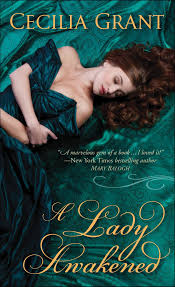
Let’s look at the cover for A Lady Awakened again, which is both utterly gorgeous and unique and a perfect example of my thesis. First, a description of what we're trying to package. The book is about a widowed country heroine who’s trying to get impregnated quickly so her terrible cousin doesn’t inherit the estate and terrorize the staff (primogeniture is a shit system). She bribes a hot rakish neighbor dude for the procreative sex, because this is a historical and sperm banks haven’t been invented yet. The early sex scenes are famously excruciating: the heroine doesn’t enjoy them in any way, and the hero’s illusions of his own prowess are somewhat painfully shattered. Eventually they fall in love and the sex turns great, but it’s a long, long haul before they get there. So this book cover has a careful line to walk: it has to suggest historical romance to appeal to the market, while warning the reader that it’s going to take a while before we get to the steamy stuff they’re looking for (because otherwise the reader will feel betrayed and this will be reflected in reviews).
We start with swathes of teal satin, hugely improbable in terms of the kind of sheets a country widow would use, but very effective in signaling “historical romance” to a modern reader. The use of teal here is brilliant, because it’s eye-catching but cool — the absence of anything resembling fuchsia is always a strong statement on a historical romance cover. The heroine is lovely, her auburn locks spread out, but notice how her arms are wrapped tightly around herself, and there is no sign of the hero? Notice as well how the colors of the cover shade into almost black, as the heroine keeps her eyes downcast and her expression wary, almost pained. She might as well have EMOTIONALLY CLOSED OFF stamped upon her forehead. This is a long and anxious journey, this cover says, and a keen-eyed reader is thus forewarned when they start the story.
You might think I’m reading into this, or reading this from the perspective of an author and a critic and not a plain reader — except that covers are always part of the conversation in romance. Cover contests and cover reveals are popular forms of promotion. Author Brenda Jackson had readers submit photos they felt would best embody one much-loved character, then tracked down the model depicted and hired him for the shoot. Most of us grew up in times and places when romance wasn’t something we could openly ask for (for safety or shame’s sake), so we learned to scrutinize cover images and cover copy closely for hints, like a hunter looking for deer tracks in the woods. (A word like “destiny” was usually a reliable sign that romance was afoot; “coming-of-age” was invariably a bad sign.) Metadata has made a lot of this easier, but it cannot sufficiently replace the visceral visual impact of a clinch or a clenching set of abs.
The saying that you should never judge a book by its cover hearkens back to George Eliot, and therefore to the days when a shelf of books were all specially bound to match one another so your aristocratic library looked nice and tidy. It's become a sort of rhetorical hammer, banging back the reality that a cover exsists as a way of speaking to the reader outside the bounds of the text. Many moralists don't want readers making choices based on personal inclination, and many authors don't want to think about their communication with the reader as something that's mediated. But when you buy a book you are often trusting it will fulfill the promises the cover has made. When you avoid a book because of the cover, it is often because you don't believe or don't want what the book cover is promising (see: every text-heavy thriller cover that hints at an unreliable narrator, shocking betrayal, and murder).
What readers do when they evaluate a book cover is not judging — it is gambling. So go on. Take the risk.
Recent Romances:
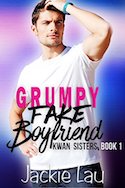
Grumpy Fake Boyfriend by Jackie Lau (self-published: contemporary m/f):
You gotta love titles that do just what they say on the tin. The greatest of these will always be Pregnesia — a book about a heroine who is pregnant and has amnesia — but Grumpy Fake Boyfriend is top-tier in the honesty department. The title makes a promise, and good Lord does the book deliver.
Grumpiness is not something I enjoy in real life, but in fiction some alchemy transmutes it into pure delight. Maybe it adds tension, as the character attempts to resist the joyful arc the book dragoons them into. Maybe it’s because grumpy characters are often blunt, and bluntness is so invigorating in narration. This book has a frank, punchy voice that had me gasping and giggling and screenshotting quotes to send to friends. Will Stafford, the titular grump, is just the right amount grouchy without tipping over into unlikeable asshole territory. He’s hermitish and reluctant and closed-off, though it’s apparent from the start that one reason he keeps those walls in place is because once someone’s on the inside of his heart he has a loyal, caring, generous streak a mile wide. His best friend Jeremy’s one of the ones on the inside, so Will can’t bring himself to say no when Jeremy asks him to attend a weekend lake house party as the fake boyfriend and buffer for his bubbly, bouncy, talkative younger sister Naomi. Whom Jeremy naturally forbids Will from sleeping with. Will doesn’t do relationships — his introversion doesn’t play well with others — so he doesn’t foresee this being a problem. Reader, I snickered, because Will is fucked.
Naomi Kwan is still reeling from a recent breakup and definitely not excited to spend a weekend in the woods with two other couples, including her ex and his brand-new girlfriend. A fake boyfriend is a ridiculous solution — unless the fake boyfriend is Will, who she’s had a crush on forever and who might be fun to take to bed. The arc here is just the right speed for a novella: light bickering leads to a little making out, which leads to a lot more than that, and bam before you know it everyone’s in their feelings. The side characters add just the right amount of drama and keep the world feeling populated. This book is a bubbly, sunny iced drink on a hot day, refreshing and tart and sweet all at once and I’m already halfway through the sequel.
I kiss her again. I softly brush my lips over hers and bring one hand up to cup her cheek, and then I’m kissing her more deeply. Showing her that yes, I do find her attractive. Very much so. She arches against me; she must be able to feel that I’m getting hard. I use tongue this time, too. More than before. “I’m practicing for our act,” I say.
She shoves my shoulder, a smile on her face. “You’re full of shit.”
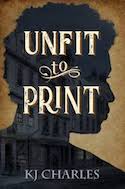
Unfit to Print by KJ Charles (self-published: historical romantic suspense m/m):
They say that every generation believes it has invented sex. Certainly every generation believe it has invented new types of sex — new debaucheries, new kinks, new ways of getting off. But it just isn’t true. Humans have always been horny, ever since the days our ancestors were slapping handprints and genitalia on cave walls. So when I learned that the latest from author KJ Charles (with whom I now share an agent) was a historical suspense where one hero runs a pornographic bookshop in Victorian London, I was all in.
Men loving men was illegal in Victorian England, you’ll recall, so it’s a perfect milieu for a pair of amateur detectives. One of the challenges in mystery writing is explaining why the police aren’t the ones solving the crime: sometimes it’s because the police are unavailable (every murder mystery that takes place on an isolated island or boat or country house), but other times it’s because the police are not as interested in real justice as the amateur sleuth is (Phryne Fisher is a great example of this). Here, because the crime takes place in the context of gay sex and sex work, contacting the police is riskier than trying to solve the case. Gilbert Lawless is our bookseller, a bastard son whose half-siblings cast him out of the family after their father’s death; Vikram Pandey is a well-heeled lawyer whose upright principles and fierce morality compel him to help other Indian nationals living in London, but also tie him in absolute knots trying to cope with his own desires for men. A disappeared boy and a connection with a murder start the mystery running, and the emotional revelations quickly pile up as the plot forces the two men back into proximity after decades apart. Gil, whose past includes a stint in sex work and who’s always been better at taking pleasure while there’s pleasure to be taken, can’t understand why Vik gets so intense about their past and their entangled present; Vik can’t understand why Gil acts like what they do with one another doesn’t mean anything, and why he shrugs off chances to help other people of their ethnic background. The two have a way of just opening each other up — they are so different, and yet so entwined, and they get to the heart of the conflict so directly. Plus a view into the working-class Victorian world we don’t see often enough in romance. It’s lonely and lovely and a very little bit foxed at the edges, just like a good vintage dirty book ought to be.
Bonus points for a few slang sex terms I haven’t encountered before, but which I’m now going to drop on Twitter at the very next opportunity.
“But one can’t simply say, ‘Fancy sucking’ — you know.”
“One bloody can, in the right company. And yes, since you ask, I do.” Gil gave him an evil grin. “If you can get the words out. I’m not ‘embarking on negotiations pertaining to fellatio’ or whatever, so don’t even try.”
“Proper terminology is important,” Vikram said. “I may have to work up to it.”
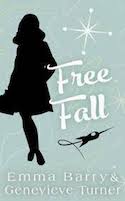
Free Fall by Emma Barry and Genevieve Turner (self-published: historical m/f):
In my quest to be the World’s Greatest Expert on Astronaut Romance Novels I have developed a few working theories. For instance: astronaut romances have to emphasize the value of domestic earthbound life, to give the spacefaring hero or heroine something to come back to after the glory and risk of exploration and space travel. I don’t think this is limited to romances, either: Apollo 13, Interstellar, Gravity, and The Martian all hinge plots on whether or not an astronaut can be brought back to loved ones on earth. In earlier books of this excellent series we’ve seen a wary divorcée heroine, an astronaut’s hyper-organized wife, and an admiral’s proper daughter: in Free Fall heroine Vivian Muller is a sorority girl and the cosseted heiress of her defense contractor daddy. Vivy is a different flavor of domestic than we’ve seen before: loud, stubborn, deliberately tacky, funny, and unstoppable. A pistol, one might say, or a real piece of work if one wanted to disapprove. She had no intention of settling down — she only took astronaut Dean Garland to bed for a bit of rebellion and fun. But she ends up pregnant, her dad insists on the marriage to better his chances at landing contracts with the American Space Department (fictional NASA), and next thing you know we have the chattiest, sexpottiest, winged-eyeliner-iest heroine ever hitched to a silent, stoic, unfeeling-but-handsome-about-it astronaut who wants to go to space because it’s the farthest away you can get from another human being. They are incredibly different, drawn to each other because of it, and really, truly terrible at being in a relationship together. Watching them work it out — with strategic lingerie, home telescopes, burned dinner experiments, a puppy, and a heartrending letter at just the right moment — had me sobbing into my sleeve. This is my favorite historical series in romance right now, and we’re about to head into the back half of the series with the moon missions and the lunar lander so now is a great time to get started, if you’re new to the books. I cannot wait.
They’d gone from probably never seeing each other again to being married. The significance of the shift sat between them like a sunning walrus.

From Scratch by Katrina Jackson (self-published: contemporary pan m/bi m/f):
I am sorry I did not see this book when it was hot off the presses last December, but better late than never because this one is really something special. Inclusive ménage romance set in a small town, where all the drama comes from the careful navigation of personal relationships and intimacy? Smoking hot sex scenes, caring hearts, and baked goods? This is someone’s Absolute Catnip and I want them to have the chance to hear about it.
They say time is a river, and this book believes it: the voice is loose and conversational and flows backward and forward from one moment to an earlier then on to the next. We start with curvy heroine Mary, who’s just lost her hateful academic job and decided what the hell, starting over as a baker in a small town looking for a population boost might be a much better fit. She brings donuts to the Sea Port police chief — Miguel Santos, ex-Marine, principled, hot — while he’s having coffee with his best friend the fire chief — Billy Knox, ex-Marine Sergeant, abusive family, uses humor like a shield, also hot. The chemistry of these three was enough to fry an egg on my e-reader. Their attraction to Mary helps reveal the two men’s long-simmering, equally long-hidden attraction to one another, and when Mary confesses that for a solid week she’s been dreaming of having both of them, with her, together — well, it is, as the kiddos say, on. The sex is frank and filthy and sweet all at once, and the emotions are rich and layered and well worth watching. It is just such a damn comfort sometimes to have romance characters who act like adults, even when it’s difficult, even when feeling out a new relationship that the culture doesn’t really have a blueprint for. This book is incredibly light on the conflict — but in a way that feels like a kindness to the reader, which is something I have come to cherish in these trying times. There will always be room in my heart (and in this column!) for pure fluff, served piping hot.
Santos wasn’t an idiot. He knew she wasn’t just talking about Knox, but he needed to hear her say it, because none of this made sense. This was not what good, straight-laced cops and bakers did. Right?
This Month’s Hardcore Historical Who’s Having None Of Your Shit Colonialism:
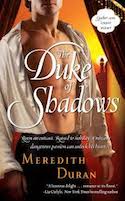
Duke of Shadows by Meredith Duran (Pocket Star: historical m/f):
Another thing this column always has room for: romances that stare unflinchingly into the void. Because hardened survivor souls need love as much as the tender, trembling ones.
Author Suleikha Snyder has said more than once that this book is one of the best historicals she’s seen set for depictions of British India, and on its ten-year anniversary its power remains intense. It is too vivid a mirror at this moment to read about an angry country at the boiling point, with a terrible event looming in the very near future. Heiress and artist Emmaline Martin survives the shipwreck that kills her family on the way to Delhi only to learn her colonel betrothed is already cheating on her with other officers’ wives. She takes refuge in the garden at a party and meets part-Indian, part-English Julian, Marquess of Holdermann and future duke. Both are frustrated, hurting, and angry, so their flirtation is born as much out of that as out of their undeniable attraction — and they barely have a moment to reflect on what they’re feeling before the Indian Mutiny hits and things go absolutely to eight kinds of hell. What follows is absolutely horrifying, a nightmare of near escapes, murder, sexual assault, mutilation, guilt, and betrayal. We resurface in London: Emma is broken and only barely holding onto her sanity, compulsively painting her worst memories of her escape. Julian thinks she’s dead, until he comes face to face with her at an art exhibition — and realizes her paintings hold a terrible secret. It takes them the rest of the book to work out what they’ve gone through, what they’ve done, and what they mean to one another. My soul bled for them the whole time — especially Emma, whose self-isolation by trauma is one of the most devastating things I’ve ever read in a romance. As for Julian, caught between two cultures violently opposed to one another, he has turned code-switching into a whimsical kind of bitterness that both unsettles and fascinates. Their banter is often uneasy and cutting, but it’s abundantly clear that nobody will ever understand them better than they understand one another. They’re never going to be light-hearted, but they’re so damn strong, and they value each other so deeply, that the HEA is totally, utterly convincing. This is one of those romances that leans into the darkness rather than shutting it out, and is all the better for it — much like the characters it brings to life.
The ocean waited too. It sulked sluggishly beneath the tropical sun; slipping into it would not be so hard. The heat felt like a warm hand pressing on her back, urging her down and away. No trace of the great ship remained; no one surveying these flat, empty waters would suspect what had passed here. No one was coming for her. But her hands would not let go.
Kissing Books: punched by the lowest point
Every month, Olivia Waite pulls back the covers, revealing the very best in new, and classic, romance. We're extending a hand to you. Won't you take it? And if you're still not sated, there's always the archives.
In romance circles, there is a thing known as the Black Moment.
Here is how it goes: you have your two protagonists, who we’ll call H1 and H2. For most of the book they have been drawn closer and closer together — maybe they’ve been having sex, maybe they’ve been forced to marry, maybe they’re working together to eradicate space pirates from the newly colonized Argyle Nebula. They’re on the verge of something big, a life-changing realization that they love one another, that they could spend the rest of their lives together, that everything they want is right there in front of them. But first! The author must take all their old fears, all the old problems, all the long-burning fuses of catastrophe that have been set alight over the course of the plot (“And no one will ever find out…”= someone’s definitely gonna find out), throw everything at our lovers, and set their entire world on fire. Maybe H1 learns that H2 was only sleeping with them to win a bet. Maybe H2 learns tht H1 has been captaining the space pirates all along. The specifics vary but the effect is the same: the H1-H2 relationship, once so shiny and promising, shatters.
That is your Black Moment. It is when H1 and H2 believe they’ve ruined everything.
The reader feels all that pain along with them. Because of course we read romance to feel things. A romance is the emotional equivalent of a roller coaster, and the Black Moment is the spot where the train has cranked up to the highest point, and you take one breath, and then you plunge down into the depths at speeds that no human should rightly survive. A good Black Moment lands in the body in an intensely physical way. It is not an intellectual experience, some distant and voyeuristic Goodness, whatever shall they do? A well-crafted Black Moment should feel like you’ve been gut-punched.
And you like it. It’s safe to like it. Because it’s going to be all right in the end.
This is the intellectual part: despite what you feel, despite the pain and the anguish and yes, the rage at seeing someone self-destruct, at seeing two people who care about each other just royally tearing one another’s hearts to shreds, you can be absolutely certain that they will get over this, because if they do not, then the novel has failed.
No matter how many times I see it happen, I always am a little awed. If a romance novel makes you feel that everything’s lost, and you do not feel things are right again at the end, it is considered the book’s fault and not the reader’s. We warn each other against insufficient Black Moments: “He doesn’t grovel enough,” we’ll say, because that’s the most common way a book can fail this test. (There’s a Goodreads list about this, can you believe it? And yes, Kristin Ashley is on it. Twice.)
Building such a subjective experience must be done carefully. H1 can’t say, “Aha! I have been the space pirate captain all along!” and then blast H2’s ship to pieces with a laser cannon while shouting about how terrible all the sex secretly was. The Black Moment is not solely a plot twist. It is not simply about surprising the reader (though while I have you here, plot twists aren’t simply about surprising the reader either, you hacks). To take an example from literature, the Black Moment in Jane Eyre is not the part where Jane learns Rochester’s been hiding a wife in the attic. It’s not even the moment where Jane thinks Rochester has died in the fire that burned Thornfield to the ground. Those are points in the plot. The Black Moment in Jane Eyre is the part where Jane almost agrees to marry St. John Rivers to go work herself usefully but unhappily to death as a colonial missionary. Not just because marrying St. John (a priggish and emotionally abusive megalomaniac) would be The Absolute Worst, but because it is the moment where Jane comes closest to losing the most vital parts of herself. It is the highest crisis, the greatest risk, the profoundest moment of dread for the reader. It encompasses everything that has come before — in fact, it depends on it. Losing Jane only matters if we know who Jane truly is.
The Black Moment is the part that makes the Happily Ever After mean something. The old clichés are sometimes cliché for a reason: boy meets girl, boy loses girl, boy wins girl back. The losing isn’t something you can lightly skip. The losing glues the other parts together.
Of course, the cultural habit of associating blackness with pain and despair is something we'll need a whole other book to unpack, but use of this term, thankfully, doesn’t seem to be racially loaded.
This month’s books all feature exquisite Black Moments. One of them was so horrifying I honestly nearly put the book down out of self-defense; one of them has a grovel scene that was so outrageous and bold it made me want to laugh and cheer and shout to the heavens. All of them landed square in my gut and knocked the wind right out of me. May everything we read leave us so pleasurably breathless.
Recent Romances:

A Gentleman Never Keeps Score by Cat Sebastian (Avon Impulse: historical m/m):
I keep picking up Cat Sebastian’s romances on account of irresistible paradox: they are always profoundly surprising in some way, and at the same time they are consistently, reliably excellent. They stick in the mind: Ruin of a Rake’s intricate social balancing act, It Takes Two to Tumble’s sparkly quasi-supernatural tone, The Lawrence Browne Affair’s Gothic indulgences. And now her latest book, the second about the ramshackle Sedgwick siblings, pairs black boxer-turned-pub owner Samuel Fox with disgraced semi-aristocrat Hartley Sedgwick, as they plot to discover and steal a set of scandalous paintings owned by Harley’s dead benefactor.
You’d think it’s a heist book. But it turns out to be more like a not-heist book — because of course in real life heists are usually an absolutely terrible idea. They’re precisely the kind of terrible idea a person would have if, like Hart, they were trying desperately to feel something other than traumatized by someone they’d trusted who’d hurt them enormously, and whom death had put beyond the reach of any actual punishment or revenge. And if you’re a decent, strong, caretaking type like Sam Fox, carrying around a lot of guilt about the people you’d lost before, you’d go to great lengths to keep someone like Hart from getting hurt any worse than he clearly already had been. You might even, say, help him break into a neglected house where some of that trauma took place, if Hart thought the paintings might be there, and it might help to find them. But mostly you’d do other, ordinary things: bring food, pour a drink, offer an understanding ear. Tell Hart he’s beautiful, make him feel safe.
Somehow, all the not-heisting turns out to be as engaging as a heist would have been. Hart and Sam are amazing on their own but absolute dynamite together: the scene where they meet may be one of my new favorite scenes in all of romance. There’s a lot about sex work and social stigma, racism and homophobia and snobbery and hypocrisy. It’s quite dark, at times, but there’s moments of absolute glory. Occasional romances deal earnestly and deeply with healing the damage left by sexual assault and rape; Courtney Milan’s The Governess Affair, for example. This book gives us a pair of heroes who know what it means to put their bodies and selves at risk for family. It makes it all the sweeter when they finally find each other.
Hartley broke the kiss and buried his face in Sam’s coat, but Sam could tell Hartley was smiling. God, it was a rare gift to have this man in his arms. It made Sam feel like he had been given care of something unspeakably precious and fragile.
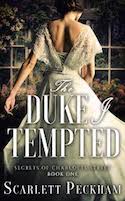
The Duke I Tempted by Scarlett Peckham (NYLA: historical m/f):
I have never read a romance so reluctant to give up its secrets. Everyone is suffering and trying to hide it, from themselves as much as from the reader. And the few who aren’t suffering are up to something. It makes for a somewhat stony beginning — but as soon as one crack appears in the façade, the book becomes irresistible, like watching a ghost-riddled manor catch fire and burn to ash. You fly through the pages as the clock strikes ten, eleven, midnight — and then the book rips away the veil and you whisper holy shit against the darkness.
There was once a flourishing Gothic branch of romance, where women with voluminous nightgowns and voluminous hair fled sinister houses and sinister men by moonlight. Battered paperbacks embossed with names like Victoria Holt and V. C. Andrews were passed around from friend to friend, lurked briefly on the shelves of used bookstores, and then vanished seemingly into the ether. Then all at once the Gothic trend withered on the vine. Nobody quite knows why, and scholars who wish to study this question have trouble tracking down copies. The details of these half-remembered tales glimmer gemlike in memory: a secret room with a dead wife’s corpse locked inside, a peacock feather fan whose ribs are tipped with poison, an unlucky Australian opal that decimates an equally unlucky family. I devoured these books by the bagful, and none of the brooding vampires or burly werewolves of modern paranormal romance can pose a threat half as viscerally terrifying as They say he killed his first wife and now he’s asking me to marry him.
Oh, they’ll tell you this Scarlett Peckham novel is femdom, and it is — once it gets around to it — but in the excitement about that underexplored trope they won’t tell you about all the rest: the fire, the other fire, the secret marriage, the opium, the ballroom that becomes a forest, the iron key our hero wears around his neck, the child with a shock of white-gold hair who bears an uncanny resemblance to another child long dead. It was bone-chillingly spooky and when I wasn’t reading I was laughing with sheer delight.
Gothic romances are tempestuous by definition, but this one is dramatic even by those heightened standards: Archer and Poppy each say and do several things in the course of their marriage that would be unforgivable in a less turbulent book. We’re talking Heathcliff and Cathy levels of mutual desire and damage. If you want characters whose emotional compasses you trust not to lead them too far astray into frank rage and despair, well, you’re going to want to give this a miss. But if you want something to speed your heart and stop your breath as you read beneath the covers, with only the meager flashlight beam warding off the enveloping night — then you have a rare treat in store. Enjoy.
There was a piercing kind of emptiness in being cold to someone who was trying to be kind to you. She had thought it would be satisfying to trouble him but it only made her feel more bereft.
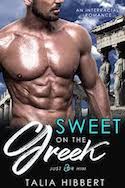
Sweet on the Greek by Talia Hibbert (Nixon House: contemporary bi m/f):
Nik, the Greek pro soccer player hero of Talia Hibbert’s latest contemporary gem, is not terribly bright. He hasn’t had to be: family wealth, stunning good looks, and athletic talent have given him everything he’s wanted. But now an injury means his career is behind him, and the future is a total blank. Nik may not be bright, but he is good, and he wants to do something meaningful, something to help the world.
But first he has to get the love of his life to like him, just a little bit. Just for a little while — say, the rest of their lives. And he has no idea how to go about it. Hence: fake relationship! It’s sure to backfire, and Nik’s just bright enough to know it, but he’s got no better ideas so hey, I’ll pay you to pretend to be my girlfriend at a month-long house party with my twenty best friends! He’s a hero of the type I think of as a Sex Puppy, muscular and rambunctious but inherently sweet and affectionate, like Chris Hemsworth’s Thor or Big Dick Richie from modern cinematic masterpiece Magic Mike XXL. Protective, but not prideful or authoritative — and gosh, doesn’t that feel refreshing in a world that sometimes feels stuffed to the gills with brooding alphas.
Heroine Aria Granger has good reason to be wary of brooding men: her last ex turned out to be someone stalking and trying to murder her best friend. Not a big surprise that she has serious trust issues! She’s questioning everything about herself — her instincts, her intelligence, her worth as a person. To Nik, though, she’s everything: sexy and witty and strong and brilliant and generous. Her deep uncertainty mixed with Nik’s absolute conviction is like nitroglycerin for the heart. This book is a Molotov, this book is a firework, this book will make you want to run around and dance and shout out of sheer joy. It’s funny, it’s filthy, and it’s sharp enough to cut. Run, don’t walk, et cetera.
He slid a hand under her head, cradling her skull, holding her to him as he kissed her again. He couldn’t speak. If he did, she’d hear the truth in his voice, hear the fact that he loved her in every crack and waver. So, instead, he kissed her, and hoped she wouldn’t taste it on his tongue.
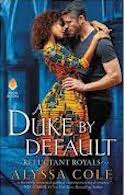
A Duke by Default by Alyssa Cole (Avon: contemporary m/f):
Every now and then a heroine comes along who’s so engaging and so flawed and so marvelous all at once that you wish she was real so you could hang out and tell her how wonderful you think she is. Related: let’s never stop talking about Portia from A Duke by Default.
We first met Portia Hobbs as the hot mess best friend in book one of the Reluctant Royals series: she was funny and brilliant but she drank way too much and hooked up constantly and nearly messed everything up when she found out Thabiso was a prince. Now she’s landed a swordsmithing apprenticeship at a Scottish armory, as part of what she calls Project: New Portia, which is all about giving up booze and men and trying to figure out what the hell she’s going to do with the rest of her life. Her parents are driven and wealthy real estate tycoons, her twin sister Reggie runs a geek media empire from her custom-designed wheelchair, but Portia…Portia, according to her mother, is a “Jill of all trades, master of none.” The family dynamics here are so realistically painful that I had to read these scenes with my hands half over my eyes, cringing with the best kind of shared agony. If you know what it feels like to disappoint someone you love even though you’re trying your hardest, Portia’s your girl. I cried for her. I raged for her. And I loved her with my whole heart.
In a desperate effort to prove her competence, Portia pours herself into the armory, beefing up their social media and redesigning the website and oh yes, unearthing the fact that her boss (and our hero) is really the long-lost illegitimate heir of a royal duke. Tavish “Here’s My Eighteen-Inch Length of Steel” McKenzie is a silver fox Scottish-Chilean swordsmith who’s happiest in the shadows, so the title upends everything comfortable and familiar in his life, even as it gives him position and power enough to have real influence to make changes for good in the world. It’s tough on everyone, and the drama is riveting. This is a long, tense, slow burn of a romance: I almost worried — almost! — that they weren’t going to make it in time. We were racing toward the end of the book, and they still had not gotten their shit together! And Tavish was going to be meeting the Queen! And then the Queen was there and and and — and it’s a moment so spectacular, so jaw-dropping, so Peak Romance, such a gift to those who love this genre that I can’t even tell you what happens. You’re just gonna have to read it for yourself.
Now that she was here, the entire plan seemed ridiculous.
- Go to Scotland.
- Make swords.
- …?
- Prosper?
This Month’s Hot, Savory Romance to Make Your Mouth Water
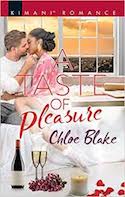
This Month’s Hot, Savory Romance to Make Your Mouth Water: A Taste of Pleasure by Chloe Blake (Harlequin Kimani: contemporary m/f):
As you value your life and your reason, stay away from this book when you’re hungry. Genre fans know the secret: many of romance’s most decadent moments aren’t about sex at all. They’re about food. Many authors who write sex scenes with plain language and precise choreography will drop all realism and restraint to lavish hyperbole on an entree or a dessert or a glass of good wine. Food, like sex, is an ephemeral art form: you shop, you prep, you enjoy it — and then it’s gone. Category romances are a little ephemeral, too: short, swift stories designed to pack the maximum amount of punch into the minimum amount of book. Most of them are potato chips, briefly savory as they melt away, then you’re reaching for the next one. This slender little masterpiece, though, is lush and rich and complicated and memorable. Full of places and people and meals and wine. Bigger on the inside. It’s like a top chef’s best amuse-bouche, and I couldn’t have loved it more.
Toni is a perfectly cromulent hero — hot Italian winemaker with a troubled teen daughter and a troublemaking ex — but what I loved most about him was how completely he was into our heroine from the moment they met. Because Dani, our curvy black chef heroine with a temper and a weakness for terrible men, is an absolute marvel. She’s been working as a ghost chef, earning Michelin stars while her truly shitty on-again, off-again boyfriend claims all the credit for her work. Some sterner readers might be put off that she semi-cheats on him with the hero at the start of the book, but Andre so deserves cheating on, and Toni is so clearly a Fun Time Ready to Go, that I found myself actively rooting for Dani to let her guard down and just hit that already. In addition to the solid chemistry and great banter, we have a whole bundle of complex and beautifully rendered secondary characters (Dani’s driven, regal supermodel mom being a particular favorite) who help make this book feel like a complete world, briefly glimpsed. Good news: it’s a series!
Men, she thought. Watch, he is going to eat my whole dinner. Toni reached for a little plate and loaded it up with portions from each dish, taking care to select the best cuts, just as she would. Then he held it out for her to take.
Kissing Books: The Niceness Industrial Complex
Every month, Olivia Waite pulls back the covers, revealing the very best in new, and classic, romance. We're extending a hand to you. Won't you take it? And if you're still not sated, there's always the archives.
The more people there are around you, the easier it is to disappear.
You can be anonymous in a city, if you want: travel to a new neighborhood, or try a new restaurant, and you encounter a whole different circle of strangers. But in a small town, everyone knows who you are. Everyone’s always watching, judging, gossiping about the ups and downs of everyone else’s life. No wonder so many romance novels and series take place in small towns: a small town makes everything significant, and a romance novel is all about the life-changing significance of ordinary things. A ring, a letter, three small and well-worn words.
For a long time I was grappling with why small-town romances felt like historicals to me — but it’s only very recently that I stumbled over part of the answer. Author Jennifer Hallock’s presentation for this year’s IASPR conference (that’s the International Association for the Study of Popular Romance — they have a wonderful journal!) introduced me to the delightful term chronotope, which is a shorter, fancier way of saying the way in which fiction represents time and space. Hallock’s work looks at the Regency/Victorian chronotope in romance to explore why there are more fictional dukes than real ones, and the shocking reason why none of them are afflicted with historically accurate syphilis (spoiler: it’s because syphilis isn’t sexy).
If we can consider the historical romance as establishing a chronotope primarily of time, then I think there’s a case to be made for the small-town romance subgenre as maintaining a chronotope of space. There is often a faint sense that these places are somewhat set apart from the wider world, like Brigadoon or Camelot. So many of these towns are not meant to be real so much as they’re meant to be Nice: idyllic Main Streets lined with non-franchise diners and art galleries and cupcake bakeries, near some pristine body of salt- or fresh water. They often have cutesy or openly symbolic names: Virgin River, Lucky Harbor, Sweetwater Springs. They promise comfort in turning away from the troubles of the real world. I don’t mean this as a blanket dismissal of the form: legion are the readers who pick up a small-town romance in the hospital, or when grieving a loss, because they need to find one small place in which nothing truly bad can happen. We need books that soothe as much as we need books that startle. Done well, these comfort reads can be engrossing, dreamlike, and restorative.
Unfortunately in this world some people’s comfort counts more than others’ — and as Sondheim says, Nice is different than Good. Some authors, in attempting to write something Nice, choose to erase entire groups of people from their fictional landscapes. Some kinds of bigotry don’t depend on malice: they depend only on your willingness to believe that, say, race or queerness only belongs in certain kinds of stories. This is the stunted logic that says queer people shouldn’t appear in sweet or cozy stories, because queer people signify sex — and people of color shouldn’t appear in stories that aren’t about race, because people of color produce racism out of thin air simply by showing up. So you get fictional rural towns full of lily-white, stick-straight characters. And then you label these places “safe,” in ways that books with non-default characters aren’t. Next thing you know you’re using “urban” to describe a character when what you mean to say is “black” — because you’ve internalized the rural=white myth and you think describing someone’s skin color is rude. Because you think it’s like pointing out something that’s wrong with them. And that’s not a Nice thing to do.
Do you see how you’ve just shored up white supremacy a little bit more? Do you see how you’ve erased queer people from your make-believe corner of the nation? If you let yourself believe queer people shouldn’t exist somewhere, it’s a very short leap to believing they shouldn’t exist anywhere. In trying to keep your story Nice, you’ve fertilized the pernicious lie that small towns are naturally white, straight, and conservative — when in fact, in the real world, many of those places systematically drove out the queer folks and people of color who did live there by legislative discrimination, redlining, and sheer brutal violence. Your attempts to be Nice have made straight white people’s comfort a higher priority than people of color and/or queer people’s right to exist. You’ve bought into what Ijeoma Oluo describes as the promise of racism: you will get more because they will get less.
This whole tangle, which I’ve started referring to as the Niceness Industrial Complex, put me off a lot of small-town romance for a long time — until I found that it doesn’t have to be this way. Whiteness/straightness is not actually a genre requirement. There are other series that use the small town’s set-apart quality to foster a less narrow, or even subversive space: Lydia San Andres’ gorgeous Edwardian-era tropical island of Cuidad Real; Alisha Rai’s exuberantly inclusive Forbidden Hearts series; Victoria Dahl’s staunchly feminist small-town heroines; Beverly Jenkins’ black-centered communities in books like Vivid, Forbidden, and the Destiny trilogy; Rebekah Weatherspoon’s mountain retreats in Haven and Sanctuary (speaking of symbolic names!); Rose Lerner’s Lively St. Lemeston Regencies with historical British Jewish rep and servant-class heroes and heroines. All these settings give us vibrant, engaging communities where all kinds of people love and are loved. They preserve the escapism of the chronotope without indulging its harmful prejudicial tendencies.
Three of this month’s romances are set in small towns: Erin Satie’s Bed of Flowers, Carla Buchanan’s Pride and Passion, and Farah Mendlesohn’s Spring Flowering. Jude Lucens’ Behind These Doors and Farrah Rochon’s Cherish Me take place in cities, but have a close-up focus on families (both the ones you find and the ones you’re born into) that gives them a small-town sense of interconnectedness: everyone knows who you are, and everyone’s a part of your history. Some of these settings are protective; some are suffocating; one is practically Orwellian in the way it surveils and punishes its characters for breaking social norms. Though the characters are frequently kind — Spring Flowering’s Ann in particular is a paragon of thoughtfulness — none of these books are Nice in the way I’ve described. The questions they ask are difficult, and often painful: what does it mean to be good? What do I owe to the world, or to my partner? What can I do to work toward happiness in the face of grave injustice and hurt?
These are questions always worth the asking, even when we think we have the answers.
Recent Romances:
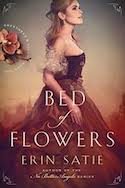
Bed of Flowers by Erin Satie (Little Phrase: historical m/f):
I am abashed it has taken me this long to read something by Erin Satie — but lord was it worth the wait. This Victorian romance is a whole world in miniature: a moral-minded port town recovering from a devastating fire, an impoverished beauty newly engaged to the handsomest man in the neighborhood, and a misanthropic baron who sleeps in the greenhouse where his rare and delicate orchids grow. Everything is a delicate balance of old resentments, hidden agendas, and smouldering pain — how could there not be a scandal brewing?
This kind of thing generally follows an established pattern in historical romance: first, the heroine flouts polite convention in ways a modern reader will find sympathetic. Usually by having sexual desires or intelligence or wanting meaningful independence, that kind of thing. The resulting outcry becomes a litmus test whereby we judge the other characters: those who condemn are Bad and therefore Ignorable, and those who support the heroine despite the stain on her reputation are Good, and therefore Worthy. It’s rare for a character depicted as loving to end up on the Bad side of this equation.
This book asks a more difficult question: what if being good came with real, painful consequences? What if doing the right thing cost you your family — even if they still claimed to love you?
Bonny, our heroine, makes her fatal choices as we watch. Our hero Lord Loel’s moments of decision happened in the past, and are revealed in conversation as he and Bonny work out what they mean to one another. Both characters put saving a life above family advancement, and both suffer for it. Real suffering, not merely the oh no who will invite us over for tea now? kind of mild social consequences modern romance so frequently presents as disaster. Here things are far more serious: financial ruin, abusive language, mob violence, and the subtler pain of refusal of services (market stalls won’t sell to Lord Loel, for instance, which is no small burden in a small town).
At one point a wealthy London socialite — whose wealth insulates her from a lot of the moral quandaries other characters are forced into — explains that with scandals, “We are more forgiving of our friends than our foes.” This book lays bare the uncomfortable truth that the scandal trope’s moral test is usually merely a sop to the reader’s modern sensibility. Bed of Flowers shows how even a loving, thoughtful family — a beloved sister, a pair of parents whose own marriage is solid and supportive — can choose to shun a daughter who has erred in the eyes of the world. There is no reconciliation at the end to erase all the pain. But this refusal to satisfy with an easy out makes the romance far more meaningful — it has weight to it, because something was given up on its behalf. It feels like the start of something genuinely new. The next book in the series has a biracial novelist heroine, and you can bet I’m already pretty excited about it.
He was handsome, too, but in a feral way. All his features were sharp: his cheekbones were sharp, his chin was sharp. Even his nose sloped down to a sharp point. He looked like a man who, if he tried to give a lady a kiss, would cut her instead.

Cherish Me by Farrah Rochon (Wandering Road Press: contemporary m/f):
Marriage in trouble books disprove the idea that romance narratives are purely courtship-centered stories that end when the protagonists say their vows. As we saw with Emma Barry and Genevieve Turner’s A Midnight Feast, you’ve got to set up problems that feel like real obstacles, then knock them down in a way that feels like substantive progress. It’s about as hard to do this in fiction as it is in real life. This book is one of the strongest examples of the form I’ve ever read. I believed in these characters wholeheartedly, even when they were struggling to believe in themselves.
Rochon sets this up elegantly by taking the time to give the reader a full family portrait through the eyes of our hero and heroine — because of course this isn’t just a marriage with two people: it’s a family, with children and siblings and cousins and everyone’s hopes and disappointments and pressures inherent. The detail builds in layers, scene by scene, each small problem piling up until they make a mountain: hero Harrison’s concerns about a pending legal case, heroine Willow’s worry about her son’s pre-diabetes, their daughter’s teenage angst, the recent loss of Harrison’s mother, all viewed through the lens of a relationship that has suddenly, mysteriously ceased to be the source of joy and support that it once was. It’s a lot, and in the roughest moments it just feels like nobody has enough time to deal with everything that’s happening. This is all very everyday drama, but in Rochon’s capable hands it’s irresistibly compelling. Touches of humor soften the angst, and cameos from past series heroes and heroines offer tantalizing glimpses of earlier stories: a Vegas elopement, a playboy settling down with a comic-book artist.
This book is not entirely escapist, I think, but it is a testament to the necessity of escapism. Harrison and Willow can’t work on the problems between them until they’re removed from their usual haunts and habits. We first get to know them in the midst of their ordinary lives — then we watch as an anniversary trip to Italy helps them blossom into fuller, better versions of themselves. (Rochon is a dedicated traveler and her descriptions of the sights are one of the book’s great pleasures.) Deeply grounded, poignantly felt, and spiritually generous, this is one of those romances that feels like more than entertainment. It feels like you’re watching two people learn how to be better, happier human beings, and sharing in their mutual joy.
What she wouldn’t give to click her heels three times and return to the relationship she’d shared with Harrison for the nearly two decades they’d been together. You’re in Rome, not Oz.
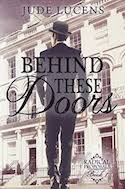
Behind These Doors by Jude Lucens (Greenwose Books: historical m/bi m):
At the start of this book we have an Edwardian-era upper-crust poly trio in a long-established relationship, and one lonely gossip journalist with class consciousness issues. By the end of this book we know a whole ensemble of people whose search for personal happiness and political agendas we’ve had to factor in: members of parliament, militant suffragettes, queer men and women, bigoted family members, snobby newspaper editors, former streetwalkers and their families, valets, footmen, seamstresses doing piece-work, cooks, Boer War veterans, people of color, and disabled characters of both the upper and lower classes. It was incredibly transporting, a very persuasive snapshot of Edwardian London.
That's not all — there’s a great many other things this book does exceptionally well. Aubrey Fanshawe, our bisexual aristocrat with a tendency toward self-deprecation, is adorable and clumsy and utterly charming. Lucien Saxby, an army survivor turned gossip journalist painfully aware of the gap between his working-class roots and the nobs he writes about, is fascinating as someone who both desperately wants to care for someone and desperately wants not to be depended upon as a servant. The last thing he needs is to get entangled with a whole passel of aristocrats — so of course that’s where he ends up. Poly romances are always most interesting to me when they use polyamory not for cheap drama, but to show the process of constant negotiation and communication required to sustain a web of relationships so complex and vulnerable. This story reminds me of the poly characters of Solace Ames in the way small shifts in one person’s thinking can add huge amounts of tension to a relationship. Everyone has the best of intentions toward themselves and others — well, except for the bigoted relatives — but there’s still so much pain and conflict and real risk involved in telling someone how you feel about them, and learning where you stand in return. It’s the kind of charged story where every exchange matters: two characters argue over where to store a pair of sapphire cufflinks after they’re removed and you know it’s a stand-in for an argument over Who They Are and How They View the World. Recommended if you’re in the mood for Merchant Ivory-style pining and costumes, but without the crushing tragedy.
Swaying with the carriage, Aubrey stared at him in silence. Stark white lamplight glared through the windows, then faded into darkness, over and again. White shirt and pale face gleamed between the black coat and tall top hat, then disappeared into shadow: perfect symmetry revealed and then snatched away in regular, tantalizing rhythm.

Pride and Passion by Carla Buchanan (self-published: historical m/f):
The Decades series, with one black-centered historical per decade of the 20th century, has been an absolute godsend for people like me who love seeing romance authors branch out into less well-traveled historical eras. Carla Buchanan’s entry for the 1950s shows the budding love between a Korean War veteran and his friend’s widow, with the Civil Rights Movement as informing context. While heroine Constance navigates the shifting, unsteady pathways of mingled public and private grief, hero Nathaniel struggles with the emotional legacy of an abusive childhood. The questions are vital and universal: how do you move on from devastating loss when it’s all anyone can see when they look at you? How do you find purpose and joy in a world with so much tragedy built in?
I was pleased and charmed at the start of the book, and the more I read the more profoundly I was moved. There’s a quiet depth to this book that soothes the troubled soul. The characters are layered and self-doubting but the prose is frank and clear as crystal, which makes the moments of highest drama land with a resonant weight I can only describe as Shakespearean. At several points I actually gasped aloud. The book has a longer timeframe than many romances — entire years occasionally pass between chapters — but that expansiveness suits the story beautifully. Nathan’s carefully controlled strength pairs nicely with Connie’s fierce tenderness, and it’s easy to see why they fall so hard and so fast for one another. Easy to see what keeps them apart so long, too. Of all this month’s romances, this is the one that is most openly ambivalent about the nature of a small town: it’s home for Connie, and becomes home for Nathaniel, but it’s clear that the comfortable bubble to be found there can be stifling as well as protective. Perlshaw, Georgia is a safe place to heal, but there comes a time in every healing when bandages should be stripped away and the world must be explored and enjoyed and confronted once again.
You see, Constance knew she had to grieve. She knew she had to grieve, but she also knew she had to live as well. And because grieving felt so much like joining Al in death, life was what she chose even though no one else chose that for her.
This Month’s Historical With Double the Heroines
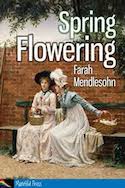
Spring Flowering by Farah Mendlesohn (Manifold Press: historical f/f)
Lately I’ve been craving a good f/f historical and it’s been surprisingly hard to find. So hard, in fact, that I started writing one. All I wanted was an Avon-style Regency with two heroines — why was this such an impossible quest? Finally, someone recommended Spring Flowering to me, and I’m so grateful they did. This is absolutely a romance reader’s romance — delicate and subtle and complex, playing with tropes and expectations and story rhythms like a virtuoso at an antique ivory keyboard. It’s some of the best Austen I’ve seen outside of Austen. This is also definitely an older style of romance: the story is told all from one heroine’s perspective, with part of the challenge for the reader being to puzzle out the real love story hidden in plain sight. Someone turns cold to our heroine for no reason — but of course there’s secretly a reason! Someone blushes at odd moments and her speech seems laden with double meanings — but of course the experienced reader can guess why! Ann, our pastor’s daughter heroine, has been knocked off-course by first her father’s death and now a move to the manufacturing town of Birmingham, impeccably rendered: we discover her as she rediscovers herself, going from wounded and hesitant to strong and self-principled. The ending is a beautiful, quiet triumph, and the more I think about it the happier I feel. To say too much about this book is to risk marring the reading of it, so I will simply leave you with one of the best and swooniest quotes, as one character grants Ann a lock of her hair:
“Do you remember the fairy tales were were told as children, and the one where the giant kept his heart in the ring in his nose? My heart is in this curl, Ann. Do not lose it.”
Kissing Books: Ef-slash-ef = Pride
Every month, Olivia Waite pulls back the covers, revealing the very best in new, and classic, romance. We're extending a hand to you. Won't you take it? And if you're still not sated, there's always the archives.
It is embarrassingly easy to not realize you’re bisexual until age thirty-five.
You start by growing nervous as a tween because you haven’t had a crush on anyone, and all or most of your friends have. In my middle school Having A Crush was an accepted route to Being Interesting And Grown-Up, at least for the length of a slumber party, so it was stressful to be the only one not gushing over Tiger Beat heartthrobs with bowlcuts and multiple layers of shirt. Was there something wrong with me? Was I one of those lesbians people were just beginning to talk about where kids like me could hear? (This was a few years before Ellen.) How did I know who I was until I knew who I loved? When I finally did develop feelings for a boy — hyperbolic, helpless, dreamy feelings that were plenty easy to identify — I stamped the label straight on myself with some relief and considered the matter closed.
For twenty years. While I dated men and fell in love with men and married a man. That’s what you do when you’re a straight woman, right? Our wedding was on Pride Weekend, in the heart of Seattle’s queerest neighborhood, with six bridesmaids in different dresses wearing literally all the colors of the rainbow. Looking back, I’m a little embarrassed at how heavy-handed that foreshadowing turned out to be.
The insistence on being born this way or I always knew that inflects a lot of gay rights discourse has not been entirely helpful when it comes to the erasure of bisexuality. The questions whispered by that small voice in the back of my head could be so easily ignored. Sure, I tried to be an ally, and voted accordingly on every anti-discrimination and civil rights issue I could. Sure, I was occasionally poleaxed by how beautiful women could be. Sure, I’d occasionally think about kissing one — but that was just because our culture uses images of women when it wants to communicate about sex, right? So you learn to think of women as sexy because it’s a constant, neverending message, yeah? It’s not like it means anything. And I definitely liked men — some of them quite a lot! — so clearly I was really and truly straight. Or maybe I was doing it for the attention: secretly, silently swooning over the occasional woman without doing anything or telling anyone…for the attention. Sure, that makes sense.
And then, at age thirty-three, I decided it was time to diversify my reading and picked up my first f/f romance. Cathy Pegau’s Rulebreaker is a sci-fi heist story with a bisexual con artist heroine named Liv, who knows better than to fall in love with her mark, but does it anyway. I’m not at all surprised I loved it: it’s just my kind of catnip.
What did surprise me: it felt like coming home. Liv knows she’s bi but has never dated a woman, and her uncertainty about this new side of herself felt like a mirror I was looking into. The book is unusual in that it puts both m/f and f/f sex on the page — something a vocal subset of readers of queer romance object to, but which was helpful for me because it showed that Liv didn’t have to disavow her attraction to men to explore her attraction to women. It wasn’t that her history with men had been false, and this new side was The One Real Truth; it was about finding an additional piece of the puzzle. Gaining something, not losing something.
I’m not here to say that reading f/f romance made me queer — but it sure didn’t hurt.
I read every one I could find for the next three months. Sci-fi, fantasy, contemporary — good ones, really good ones, and ones that were only so-so. I started asking myself some rather pointed questions about tamped-down moments and experiences in my past. And then a couple years later Mr. Waite and I were watching Brooklyn 99 with gorgeous badass detective Rosa Diaz and the scales tipped. I recall being in the kitchen getting popcorn when Mr. Waite called out, “Hey Olivia, Rosa’s wearing a shoulder harness in this one.”
“Oh my gosh, really?” I sprinted in, trailing popcorn, the mini-dachshund bounding after to devour the fallen. And then I stopped, and turned to Mr. Waite with a furrowed brow. “These aren’t really platonic feelings to be having, are they?”
“No,” he said, laughing sweetly. “They’re not.”
Since then Stephanie Beatriz, the actress who plays Rosa Diaz, came out as bisexual. Then Rosa was revealed as bi in a milestone episode and got a girlfriend. This still feels eerie and magical, like when someone offers you a gift you may have wished for but never told anyone about. Several authors whose work I’d long loved came out as queer, as trans, as asexual. A lot of lighter TV shows practically exploded with bisexual characters. I learned I wasn’t the only one who took three or more decades to parse things out. It’s a dazzling feeling, after having been keeping a secret for so long, even from yourself, to be suddenly surrounded by mirrors.
It’s not all glitter and sparkles, of course — mirrors can have sharp edges, and spotlights aren’t always safe. We know who’s in the White House. I came out officially the day after the election because I wanted people to know where I stood, and with whom. It was an impulsive decision, but it was the right one, even though I’m still very much in processing mode. I may be for thirty more years, who knows? Every time I talk about it — even in passing, or in low-key pieces like this one — it feels like sliding one foot oh so carefully out past the edge of the cliff.
It may make me a bit breathless, but it’s a hell of a view.
Recent Romances:
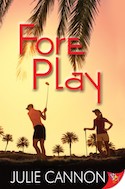
Fore Play by Julie Cannon (Bold Strokes Books: contemporary f/f):
Romance author Gerri Russell once stated: “If your hero’s a firefighter, your heroine better be an arsonist.” (Any author with an arsonist heroine should pitch me immediately.) And it’s certainly one way to build a romance: one character’s wealthy and the other’s broke, one character’s grumpy and cynical and the other’s a sunny beacon of pure golden optimism. But simple difference is not the same thing as a meaningful contrast: there needs to be some connective material in the middle, or else it’s just a mismatch. You might as well try to drink whiskey from a pint glass (not recommended).
This book tried to do something really interesting: treat an ex-con heroine’s experience seriously without softening the facts of it even a little bit. Peyton’s part of this book is a gritty, blue-collar tale about people who’ve been hard done by and who have to make imperfect choices to protect the ones they care about. This could have made for a really unique, brave romance. She killed a man who needed killing, served hard time, and now works as a golf pro/caddy/beverage server at the club her brother runs. Unfortunately, she’s paired with a heroine who seems to have been pulled from another book entirely — Leigh is a female CEO right out of the escapist, glamorous realm of Harlequin Presents. She drives an imported car, wears designer clothing, and does adrenaline-fueled sports on the weekend (motorcross) to work off the stress of the corporate world. Leigh is determined to become a better golfer to impress her wealthy colleagues and boss. Peyton is DIY-installing secret video cameras in her apartment to film the abusive midnight visits of her parole officer, who likes to trash her apartment and cop a predatory feel.
These two have absolutely nothing in common except that they really want to fuck each other. And they don’t even do that until nearly seventy percent of the way through the book! And then it’s just sex — no bonding, no sharing, no establishing of any kind of partnership outside nudity and bedsheets. It feels like the author is trying to corral them into a relationship, and the characters are digging in their heels. The only reason I finished the book was to see how long our heroines could hold out against authorial pressure. Some romance novels, like some relationships, are just not meant to be.
Leigh’s heart was pounding, and surely Peyton could feel it. Peyton stiffened, then relaxed against her, then quickly stepped away.

The Princess Deception by Nell Stark (Bold Strokes Books: contemporary f/f):
Nell Stark’s Princess Affair series of lesbian royalty romances is pure luxury escapist pleasure reading, straight up, no chaser. This latest volume is a contemporary retelling of Twelfth Night that involves a World Cup bid, a pro soccer player-turned-journalist, and a Belgian princess impersonating her twin brother while he recovers from an overdose. It’s as high-concept as it comes, but grounded in some beautifully potent feelings. Duke’s loss of her professional soccer career due to an injury is still raw and poignant, and it puts her in the right place to appreciate Viola’s grief and anger about her brother’s newly revealed addiction. This is the kind of connective tissue that was missing from Fore Play — the sense of a shared struggle, or at least shared understanding of parallel struggles. Both heroines are reeling, in that dizzy headspace where bad ideas seem like great ideas. Impersonating your twin brother is the only way to win the World Cup bid! Flirting with that princess you’ve discovered in disguise is a great way to boost your journalism career! Things go predictably to hell in all the best ways and it’s great, smart, angsty fun for the reader. Themes of exposure, revelation, coming out, and disguise intertwine to keep things feeling complex without overwhelming. The slender mystery subplot and beautifully rendered, rare locations (Amsterdam! Prague!) are the frosting on the cupcake. A+ travel reading to lose yourself in on a long flight or a lazy beach.
”Some memories have a shelf life,” she finally said. “An expiration date, beyond which they aren’t useful.”
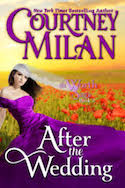
After the Wedding by Courtney Milan (self-published: historical m/f):
Speaking of cross-class romance and characters in disguise … Courtney Milan’s latest Worth Saga book is a glorious, achy, writhe-on-the-couch-making-wordless-squeaks-of-mingled-agony-and-delight heartbreaker of a romance between an earl’s daughter-turned-serving maid and a half-black porcelainware designer whose uncle is a politically ambitious bishop. We start on page one with a shotgun wedding and things get increasingly fraught from there — it has all the intrigue you miss from the old crazysauce days of greats like Bertrice Small and Laura Kinsale, plus a pragmatic view toward queer lives in the 19th century (Camilla is bisexual, and one particularly memorable secondary character is delightfully frank about her lesbianism). The series’ first book Once Upon a Marquess had a heroine with an atrocious temper, and this one has Camilla, the loneliest, thirstiest, most love-starved heroine since possibly Jane Eyre herownself. But where Jane is cautious and stoic and principled, Camilla is flirtatious, impulsive, and embarrassingly hopeful in spite of everything the world has done to break her down. I loved her, and the on-page chemistry between her and Adrian — who is too open, too giving, and too painfully willing to offer kindness even to those who hurt him — is a deep well of conflict as well as comfort.
One early moment from our hero and heroine’s first meeting shows how complex romance can really be for longtime readers: “Funny, how much more striking that contrast of crisp linen was with his brown skin than it would have been on a white man. He made everybody else seem utterly pallid by comparison.” One of the most well-worn tropes in romance is describing the two skin tones of hero and heroine when they’re in bed together: gold against pearl, or olive against porcelain. I must have read some variation on this no fewer than five hundred times. The hero in these scenes is almost always white — it’s not about him actually being a character of color, but of him being temporarily racialized for a cheap erotic charge based on his difference from the heroine. Milan’s phrasing here preserves the charge — the appealing aesthetic shock of deep brown skin against bright white linen — but her phrasing connects the hero and heroine rather than differentiating them. “He made everybody else seem utterly pallid” shows that already Camilla is drawn to Adrian not because he is different from her, but because he is different from the duller, pettier, crueler people she’s known in her difficult life. It’s unobtrusive to new romance readers, but a gem for longtime genre lovers. As with the first book, this one ends with a bit of a twist to set up the next in the series — I can’t wait to see where we’re going.
What luck, that they had married at gunpoint, she had perhaps hoped he would say. God, it sounded stupid even admitting it in her head.
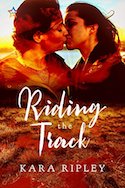
Riding the Track by Kara Ripley (NineStar Press: contemporary f/f):
I loved this book — until I loathed this book.
There are a few things you don’t do in romance. You do not kill the dog. You do not have one character cheat on the other (whether polyamory or scene play counts as cheating is a constant debate topic). And you do not, you absolutely do not have the story end with the characters not together. Whether they’re just trying it out (Happy For Now) or in it to win it (Happily Ever After), you have to end the book with your h/h (or h/h/h+, for you ménage readers) as a joined unit.
This book puts on riding boots and stomps that rule into the muck. I have rarely been so angry and disappointed to hit the end of a story. I read it three times to make sure, but it’s crystal clear: our narrator-heroine goes back to the States, and the hot Australian lesbian cowgirl stays in the Outback.
It didn’t have to be like this.
Reader, I did my due diligence: this is a book I found in the Romance category on NetGalley, from a familiar romance publisher. It has a clinch cover, for the love of Garwood. The writing is superb: snarky, informal, self-deprecating, and keenly observed. Took the author less than two pages to win me over completely. Even learning that the book was a short novella rather than a full-length novel didn’t bother me. Life moves pretty fast; novellas are a great way to get in a full story without a lot of time investment. No length complaints here, if the story feels fleshed-out.
This one did. Until the very last page. Our heroines — cynical heartbroken American Clara, and earnest Australian cowgirl Evie — are finally hooking up, after three days of riding and flirting along the Oodnadatta Track. The descriptions of the landscape, the sharp banter, our narrator’s internal self-scolding, the mischievous heifer she names Little Mo-Mo…it was all so good. I had a set of blissful notes all typed up ready for review. All I was waiting for was the hint of hope for the future, that little chime to let me know I could let go of all the tension I’d accumulated as a reader. The book wound me up, and wound me up, and wound me up — and then it split the heroines up because the vacation was over.
The most unsatisfying part of reading ebooks is not the fact that they don’t smell like paper and ink: it’s the fact that you can’t hurl them across the room when they’ve betrayed you.
This book is a bait-and-switch, plain and simple. The reason I’m putting this book in this column, even though it is clearly not a romance by the only definition that matters, is because I don’t want anyone else to get burned the way I have been.
Tell your friends. Spread the word. Save them from betrayal.
The land kept going, a great sleeping serpent of ochre rock, sand, and dust.
This Month’s Vampire Romance But Not Like That
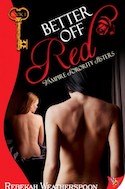
Better off Red by Rebekah Weatherspoon (Bold Strokes Bookes: paranormal f/f):
Before there was Dracula, there was Carmilla, a lesbian vampire serial. Later lesbian vampires became a whole Thing in horror cinema and pulp fiction, where the sinful, evil temptations of queer sex and female power mingled to terrify and titillate audiences assumed to be universally straight and male. Weatherspoon’s Vampire Sorority Sisters series (does what it says on the tin!) is definitely having fun with this tradition: the vampire heroine is named Camila, there’s a lot of juicy group sex just for the lush, smutty fun of it, and the plot touches on themes of power, control, violence, and living a life in the shadows. But this series is definitely pitched at queer women, by a queer woman, and it shows; the conflict comes from strong personal relationships rather than predatory hunter-and-hunted patterns, consent is actively debated, and the third book in the series recently won the Lambda for LGBTQ Erotica. It’s more Gothic than gory, and if you’re looking for something that puts a modern twist on that classic governess-in-peril mood, this is a great place to start.
Were amazingly good looks reason enough to trust your blood lusting captor?
Kissing Books: Harmony between romance and pop music
Every month, Olivia Waite pulls back the covers, revealing the very best in new, and classic, romance. We're extending a hand to you. Won't you take it? And if you're still not sated, there's always the archives.
Seattle likes to make up for the long, grey winters by exploding as soon as the weather warms. People prise open the pollen-mortared windows of their homes and their cars, and concert series bloom at every waterfront, winery, and from top to bottom over our city’s hills.
Everywhere, music spills out.
A lot of those songs are love songs. And you’ll notice a lot of the same reactions to love songs—especially femme-y, upbeat, feel-good pop songs—that you see critics sling against romance. Predictable. Saccharine. Unreal. Trivial. Pop music is coded feminine the same way rock is coded masculine, and cultural heft is parceled out accordingly. Ryan Adams covers the entirety of Taylor Swift’s 1989 and critics exclaim that his knockoff is more creative and sincere and important than her original. Back in 2012, Carly Rae Jepsen’s “Call Me Maybe” was lighting up the summer and a writer in the LA Weekly with this tautology: “I asked my youngest sister about it. She said it was excellent, which alone proves that it’s not.” That summer I started having flashbacks to the era when Toni Basil’s “Mickey” was everywhere and widely reviled as the World’s Most Annoying Earworm.
You’ll notice how many of these famously annoying songs involve femme-looking people singing frankly about their agency in sex and love and romance. Taylor Swift is notorious for, well, lots of things, but particularly for putting history with her exes into her lyrics—in fact, she wrote a hit song inviting the listener to be one of the future exes she’ll write hit songs about. “Call Me Maybe” is about a girl giving her number to a boy not because he asked, but because she wants to give it to him. And listening to “Mickey” as an adult is mildly unsettling, since the lyrics are definitely about how much the singer wants to bang the title dude and I definitely remember bopping along with that song with all the other ten-year-olds at summer camp.
To this list we could add so many other examples: the Spice Girls, TLC, Hanson, Madonna, Katy Perry, Meghan Trainor, pre-tattoo Justin Bieber, Britney Spears, and Mariah Carey, just to name a few. Hell, even the early Beatles were mocked on account of their primarily female fanbase and girl-group hit covers—until male critics rewrote history after the fact to make them Official Preordained Geniuses of Rock. I haven’t peeked to see if contemporary reviewers slagged on the Supremes, Dusty Springfield, and Martha and the Vandellas, but I wouldn’t be at all surprised to find they had. What Susan Douglas wrote in 1994’s Where the Girls Are is nearly as true today: “Girl group music has been denied its rightful place in history by a host of male music critics who’ve either ignored it or trashed it.” Stop me when this starts to sound like a certain literary genre we all know and love.
The more I look at the parallels between romance and pop songs, the more I feel this particular strain of vitriol is like an immune reaction: it froths up whenever the system — our dude-centric, white-focused, heteronormative system — can’t resolve the tension between a work as an expression of a feeling and a work as a commercial product for sale. How can you create something that evokes a real part of yourself and then turn around and sell it for money? This might explain why this rhetoric of annoyance centers so much around work by women and girls. Women’s labor is like women’s love: it’s supposed to be given, not purchased. We don’t get anxious about male musicians asking for money because we assume men’s work deserves recompense. But when a young woman offers up a piece about her love life, and then expects us to pay her, the culture clutches its pearls.
One of our books this month features a 1920s black couple whose romance unfolds through jazz numbers, studio sessions, and song lyrics. Miles and Leigh worry about sales and hits, about competing with other bands at other clubs. But they also worry about getting the words just right—making them say something true, something real. It’s both work and a miracle at once, inseparable. And doesn’t that sound just like true love to you?
Recent Romances:

Love’s Serenade by Sheryl Lister (self-published: historical m/f):
Let’s cut right to the first, irresistible hook: He steals her sheet music!
Smooth-talking piano player Miles Cooper convinced good-girl church singer Leigh to run away with him to the big city—then snuck out of the boardinghouse while she slept and took her sheet music with him. It’s so much worse than just breaking the girl’s heart. I could cheerfully have murdered the man for this, and I couldn’t wait to see how the author could possibly redeem him.
Years later (but mere paragraphs in book time) Miles comes back, all soulful eyes, begging for a second chance.
So Leigh—by now a successful speakeasy singer—punches him. Right hook to the jaw, no hesitation. He laughs, admits he deserved it, and promptly hands her the sheet music back.
Reader, I was delighted. Just like that, we’re on an even playing field again. Miles and Leigh are cautious, cagey types—except when they’re together, when they just can’t seem to hold back. This book is as bold and direct as red lipstick, the prose light and clean as an old and well-worn song. I wish the emotional arc wasn’t interrupted in the middle by what felt like an unnecessary conflict from the heroine’s past. But the sense of place and time is gorgeous, and I’m an easy mark for a Harlem-set historical with a cameo by Zora Neale Hurston. This book is number four in the Decades series, which features one African-American historical romance from every decade from 1900 until 2010—so if you’re looking for stories from lesser-seen historical eras then this is definitely something you’re going to want to look into.
The next song started, and Leigh froze. She’d recognize that piano style anywhere. It can’t be. Her heart started pounding. She whipped her head around and her gaze collided with the one man she thought she’d never see again.
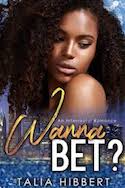
Wanna Bet by Talia Hibbert (self-published: m/f contemporary):
This is one of those rare romances that feels…comprehensive. The romance is not just one episode in the character’s life, but the key to the meaning of the whole. The book has to jump around a bit in time to accomplish this, which means the pacing is somewhat measured, but the time is very well spent. We’ve gotten to know heroine Jasmine well enough that by the time hero Rahul shows up, we can fill in her reactions to their meeting while we’re learning his. And then perspective switches, and we’re filling in Rahul’s thoughts while Jasmine narrates. Normally you only get that kind of layered double-reading pleasure quite late in the romance; having it turn up so early and so often is a real delight.
That’s not the only pleasure Talia Hibbert has to offer. Lyrical prose, electric dialogue, and I had to stop every chapter and remind myself to breathe because this book is pining with a capital P. Jasmine is sharp, dazzling, and fierce; she’s also fragile, cagey, and too proud to ask for what she wants most. Rahul is outwardly rock-steady but secretly a live wire of lust and overanalysis and unspoken hope. I have seen too many Bollywood movies for that name not to conjure visions of Shahrukh Khan, which gives an extra-fun kick to the pining and to the (many, gorgeous) sex scenes. Normally in a romance I feel more pulled toward one of the protagonists (the hero here, the heroine there): this book is one of the glorious times I get to fall headlong in love with both characters. I laughed. I cried. I damn well cheered. And then, when I was good and caught, this book took all the charm and the poetry and the yearning and shaped it into a knife to slice my heart into pieces—then fused it back together with seams of glittering gold, because you shouldn’t forget where the breaks were. It’s the faults that make something loveable. In sum: one of the greatest friends-to-lovers romances I’ve read in many years.The days passed slowly, all at once. Summer dripped over the city like spilled honey. Jasmine found herself disturbingly and unnaturally happy, and it was all Rahul’s fault.

On-Air Passion by Lindsay Evans (Harlequin Kimani: contemporary m/f):
It’s a damn shame Harlequin is shutting down their Kimani line (romances focused on black and African-American characters) just at the point when the demand for inclusive romance is greater and more vocal than ever. A ton of the category romances (the genre term for short romances published on a monthly basis by Harlequin, Silhouette, Mills and Boon, and others) I’ve read in the past few years have been Kimanis. I’ve talked about romance novels being like champagne, but categories are more like a rosé: they’re pleasing, approachable, and best consumed in the same year they’re made.
This gem from Lindsay Evans has everything a category should: tight conflict, snappy prose, and character chemistry hot enough to burn the letters right off the page. Retired pro basketball player-turned-radio host Ahmed Clark thinks love is an illusion that distracts people from working toward meaningful change (for once it’s the hero with the activist’s social conscience!). Elle Marshall believes love gives humans hope, and has come on the show to promote her Atlanta business setting up memorable dates for couples. It’s hate at first sight, but the studio forces them to go on a date to milk the publicity, and of course the friction is mostly fueled by unacknowledged lust. Of course we know how it’s gonna end—we always know how it’s gonna end—but what keeps it from being predictable is the way Lindsay Evans knows how to zing a reader just when she gets comfortable. Touches of humor, wry observations, and beautifully comic descriptions add layers while the plot hurtles through the ups and downs: for instance, this early description of station owner Clive Ramirez, who “loved what he did for a living, fairly treated the people who worked for him, and loved drama like a teenage girl. But everybody had to have a hobby.”
Every emotion in this one is dialed up to eleven, every mistake is compounded, every feeling is wrung out of the characters. It’s a juicy, tart-sweet roller coaster of a read. Not every note lands—I could have done with much more of a grovel from our hero—but that feels sort of separate from the way this book is so good at rewarding a reader’s time and attention. It was like I’d been invited into a marvelous party: even the annoying bits are fun to talk about the morning after.
”Did you just say all those terrible things to that girl and then let her walk away?”
"Why were you so mean to her?”
“Are you super-paranoid?”
“What did she do to you?”
“Did you sleep with her and then basically just curse her out on the radio?”
“Ahmed, you’re messing up, man.”

The Viking Queen’s Men by Holley Trent (self-published: paranormal m/f/m)
One of the reasons I love paranormal romance is the way authors are glad to head straight to Bonkersville by the fastest train. This gem from a few years back is a steamy series-starter ménage about a race of psychic matriarchal Vikings in the southwest, the telepathic branch of whom live in an isolated McMansion compound and the empathic branch of whom pose as a biker gang around a pub called the Longship. There are ancestral ghosts giving advice and sex that unlocks magic powers and finally, finally someone writing fated mates as plot complications and not mere excuses for in-book stalking and jealousy.
It’s all completely extra and I ate it up with a spoon.
Our heroine Tess is a former foster kid, a jailbird, and a stone-cold badass. Her voice is hard-bitten and bluntly funny and so lonely you ache in glorious sympathy. I wanted to hug her, then hand her a whiskey and tell her to kick back, then fight any of her enemies who dared to show their face. It makes total sense that our two heroes, smooth corporate type Harvey and ax-wielding biker Oliver, feel similarly: Harvey grew up in the same foster system as Tess, and Oliver has been having dreams of her for several years running. Now that she’s the crowned queen of the Afótama (read: psychic Vikings) she has to work out what her specific psychic talents are, solve the mystery of who kidnapped her away as a child, and negotiate an emotional and sexual balance with two dudes who don’t realize right away that they aren’t rivals and that she intends to keep them both. Hey, her dead many-times-great-grandma Viking thinks it’s a splendid idea, so why not? The whole tower of cards would collapse into a mess in a moment if it weren’t grounded with a live wire of an earnest, irresistible yearning to belong. Which is to say: yes, the psychic Viking ménage book made me cry. Book one ends on a bit of a cliffhanger, but if you like Shelly Laurenston’s shifters (boy, do I!), this series is going to be right up your alley.
"For fuck’s sake." She needed to get her head out of the real world. They weren’t going to resolve their dilemma like reasonable people, because they were Vikings.
This Month’s Aerospace Engineer/Astronaut Heroine Who Can Have it All
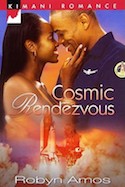
Cosmic Rendezvous by Robyn Amos (Harlequin Kimani: contemporary m/f):
Unlike governesses, cowboys, or BDSM sex club proprietors, astronaut heroes and heroines are not common enough to count as their own romance subgenre. I still read every one I can find (like this small sampler) because of how they dramatize one of the big tensions of romance: Staying versus Leaving. Space is big! It’s dangerous! It’s distant! It’s the farthest Away a human could possibly get! Space is the opposite of home. A lot of non-romance astronaut stories revolve around this idea as well: Gravity, Interstellar, and Apollo 13. So in order to Stay—since any HEA depends upon the protagonists Not Leaving—the astronaut hero or heroine has to forgo going into space. Which is a big deal, because they’ve worked all their life to get into space, and also because space travel is so strongly associated with positives like nobility/knowledge/adventure. An astronaut hero or heroine always has to find a reason to knowingly, willingly choose domesticity. It is a sacrifice.
Unless you’re Shelly London, the heroine of Cosmic Rendezvouz.
Shelly is an aerospace engineer who has designed a new kind of capsule. She dreams of being the one to fly it into space, so she’s applied to the astronaut program, only to be turned down over and over (spoiler: because her overprotective Senator mother keeps leaning on the officials, it’s awful, I loved it). Our hero Lincoln is a hotshot test pilot and astronaut golden boy: he made a famously daring emergency shuttle landing that landed him on the cover of Time magazine. So the tension in this romance is not just that Shelly finds Lincoln inconveniently attractive: it’s that he breezily, effortlessly embodies everything she’s fighting to achieve. It’s frustrating as hell.
And because I’ve read quite a lot of romance, and a lot of astronaut romance, I fully expected there to be some reason why Shelly would never achieve her dream. Astronauts have to resist the temptation of space, and a lot of romance heroines have to learn that Career is Less Important Than Living Life, or whatever. I braced myself for the coming disappointment.
Wrong again! After a suspense plot involving sabotage—the less said about this the better—Shelly becomes an astronaut. A great astronaut. With her own solo picture on the cover of Time and everything. Because of course the Staying versus Leaving dynamic presumes one partner has no choice about staying. That game was rigged and I never noticed.
But Shelly is given the choice. She chooses space because she wants it. She chooses Lincoln because she wants him, too. This book is about a heroine—a black heroine—coming to realize that she doesn’t have to sacrifice any part of herself in order to be happy.
And that’s the kind of book I’ll never get tired of.
Kissing Books: the coded dress
Every month, Olivia Waite pulls back the covers, revealing the very best in new, and classic, romance. We're extending a hand to you. Won't you take it? And if you're still not sated, there's always the archives.
This month I intended to write something frothy about clothing in romance. About the linen and muslin and silk of historicals, the wool suits and high heels of contemporaries, the uniforms of sports romances, the dragon-scarred leathers of fantasy romance, or the nano-regulated synthetic fabrics of the future in SFR (sci-fi romance, for those in the know). But every time I reached into the froth I found a chunk of solid substance underneath that brought me up short.
Consider the dress code.
Fashion, we tell our youth, is a frivolous matter. It marks you as shallow and materialistic (if you’re read as female) and potentially queer (if you’re read as male). It is classed as neither a science nor an art; at best it’s a hobby, harmless but ultimately unimportant.
And we will ban you from school if you do it wrong.
Even the definition of “wrong” depends on so many different factors: geography, audience, time of day, social group, gender, race, religion, body shape, ability. Anyone who has ever overdressed for a party knows how nebulous the rules are, and yet how painful it is when you fail to follow them. Fashion in fiction is even more fraught, because it’s never an accident: it’s chosen (by the author, if not always by the characters), so it can only add meaning. The billionaire’s meticulously tailored suit advertises his power and wealth. The debutante’s pristine gloves are there to be slowly undone, one pearl button at a time.
But this meaning is as slippery as the rules: take, for instance, a red dress. The shy heroine could wear it to show her newly found confidence, which the best friend-turned-lover hero has been helping her build up — or a brash no-nonsense heroine could wear it because she knows she looks awesome and she wants to show the enemy-but-not-for-long hero what he’s missing, the jerk. If the Other Woman is wearing a red dress, it could show she’s sexually aggressive — or it could be because it’s an expensive couture number that flaunts her social status and how faux-perfect she is for our wealthy hero (unlike our poor but authentic heroine). There’s even a famous historical romance where it’s the hero wearing the red dress (Anna Cowan’s Untamed). Clothing motifs, it turns out, are endlessly fluid and adaptable, even when they’re using the same general pattern. I could probably write a fifty-page dissertation just on gloves in historical romance, without ever having to look beyond the books in my personal library. And that’s not even going into the fact that my library is very Western-centric (I’m working on it!) and there’s heaps more possible interpretations when setting romances in non-Western cultural traditions.
Because clothing is never just about fabric, or even just about fabric and bodies. The overall look of a garment depends on the shape and color of the body wearing it, yes — but it also depends on the eye of the beholder, to a degree we don’t always acknowledge openly (unless we’re yelling rebuttals at Project Runway judges because seriously, are we even looking at the same pieces sometimes???). Fashion is a bit like a book, in that sense: one person puts it together, and another person looks at it, and the artistry happens in the space where the building and the looking connect. Fashion is more than just a medium: it’s a language, capable of everything from bawdy limericks to epic tragedies to ephemeral, mutable slang.
This month’s books have a seamstress in Belle Époque Paris, a fat fashionista in modern-day Manila, a runaway Regency bride whose escape ruins more than her gown, a nonbinary Regency heroine who gives up gowns entirely, and a midcentury model for a haute couture house. For some characters, clothing is a business; for others, a vital medium for self-expression and identity. It may be fun (Lady Crystallia’s lavish frocks, Martha’s chic officewear, Robin Selby’s piratical lace cuffs), but it’s never, ever frivolous.
Recent Romances:

The Prince and the Dressmaker by Jen Wang (First Second Books: historical YA nonbinary/f graphic novel):
When my print copy of this lovely book arrived in the mail, it caught Mr. Waite’s eye. He picked it up, flipped to the back, gasped audibly, and slammed the book shut again. “You are going to love this,” he said fervently.
I told this story to a friend who’d given the book five stars. She said: “I know exactly what he was looking at. And yes, you’re going to love it.”
Reader, they were right. I knew the page as soon as I reached it. And heaven help me, but I clapped a hand over my mouth and sobbed aloud in such pure delight that I’m crying a bit right now even thinking about it.
When I reached the end, I went right back to the beginning and read it a second time straight through. It’s that good.
I am now ravenous for other people to read this book. Part of me wants to stand outside on the lawn a la Lloyd Dobbler, but instead of that boombox I’d be holding up a blown-up image of one early moment from page 50 to 51. Partly it’s because this story hits so many of my personal YES PLEASE buttons — seamstress heroine, arranged marriages, historical Paris, fashion as art, queer identity, characters in disguise — but also because it’s just such a beautiful, detailed, and kind piece of work that it feels like a gift Jen Wang has made for all of us. Keeping it to myself feels positively selfish.
Our heroine Frances is a gifted young seamstress working too hard for a thankless boss in Belle Époque Paris. One shocking dress for a prickly client gets her fired — but it also gets her noticed by Prince Sebastian of Brussels. Sebastian’s parents are seeking a princess to betroth him to, but Sebastian would much rather be putting on a red wig and a stunning gown and dazzling Paris as Lady Crystallia, everyone’s favorite fashion trendsetter. The two become partners in couture, best friends, and maybe something more — but political marriages, commercial opportunities, and the constricting nature of secret identities threaten the bond between them.
It may be the happiest happy ending I have read in some time. Plus a rich and sophisticated color palette, dazzling gowns, lovely organic inky brushstrokes, and a bonus feature at the end on the artist’s process that I found absolutely fascinating.
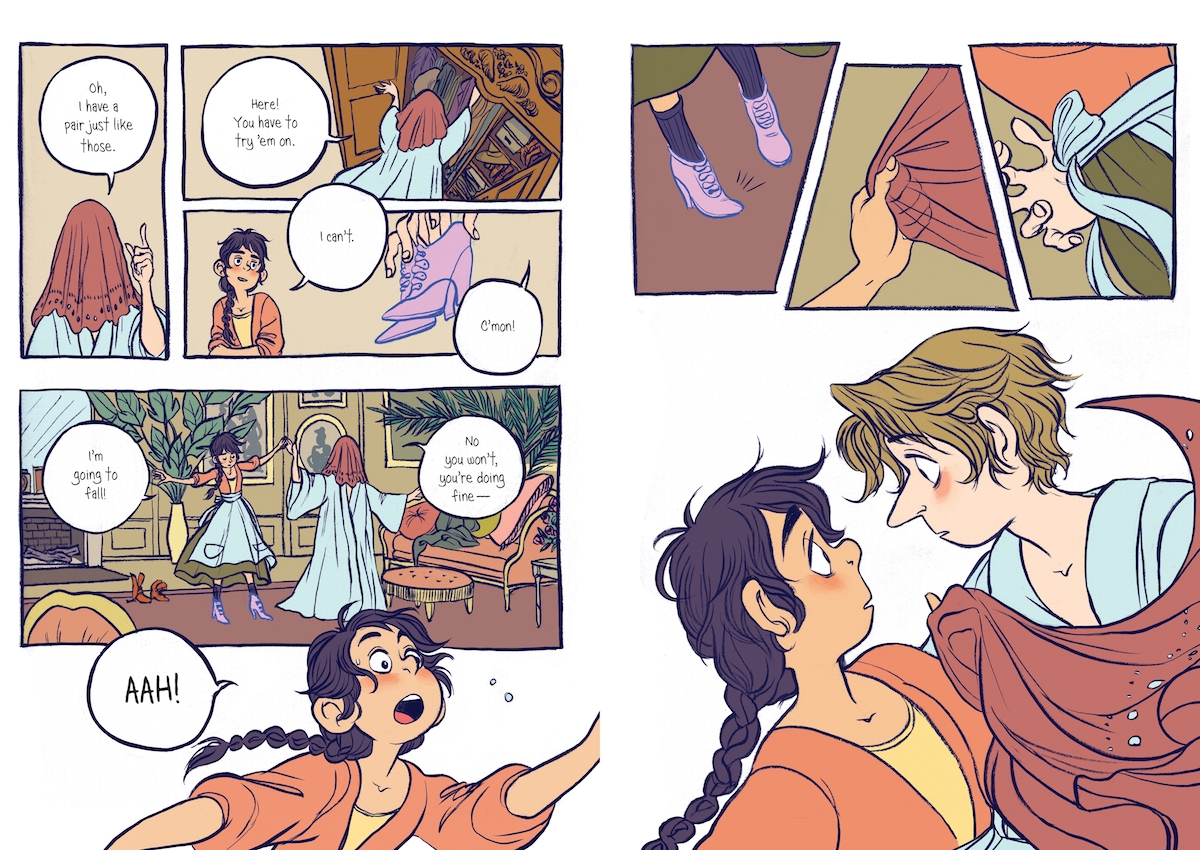
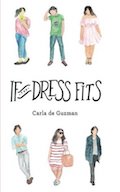
If the Dress Fits by Carla de Guzman (Midnight Books: contemporary m/f):
It’s a good thing I read this book in digital form, because if I’d been reading it in print there’d be drool stains on every page. Romance novels and food often go hand in hand (check out reviewer Elisabeth Lane’s marvelous Cooking Up Romance, for instance) but this book takes it to new heights.
And cheese hopia and tarragon tea aren’t the only things to yearn for in the pages of this Philippines-set romantic comedy. Our hero Max is a tall, shy, bookish veterinarian who’s so achingly in love with our narrator heroine from the beginning that at times I had to put the book down just to catch my breath. I love a good unrequited plotline, and this one is particularly stunning. Heroine Martha, meanwhile, is distracted from recognizing Max’s feelings (and her own, aaaaaa) by her demanding family and her self-consciousness about her size and her helpless crush on the gorgeous Enzo, her former theater friend — who just happens to be newly engaged to her perfect, petite cousin. And of course they want Martha to be the maid of honor! And do all the party planning!
This story really knows how to twist the drama knife without going over the line into excruciating, and if Martha is a little frustrating at times, well, so is Emma Woodhouse. This is also a book with a fat heroine that’s realistic about shame and microaggressions without making her weight into The Entire Issue of her life. Martha doesn’t have to learn to love herself — but she does have to learn to tell people that she loves her shape, and to imagine that other people might love it too. It’s the kind of book where everyone is perfectly imperfect, which I found delightful even though I wanted to shake every character at least once when they were being stubborn or scared or short-sighted.
Don’t read when hungry. You have been warned.
”Because I loved you,” I said to him. The words spilled out of my mouth before I could stop them, like the beads on a necklace that had snapped. They scattered everywhere, and it was impossible to catch them all now.
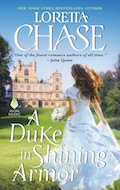
A Duke in Shining Armor by Loretta Chase (Avon: historical m/f):
The beginning of this book is a masterpiece in how to start at the latest possible point in a story and let the characters’ actions reveal who they are.
We begin at the wedding. The groom, the Duke of Ashmont, is drunk and growing belligerent. The bride, Lady Olympia Hightower, also drunk, was supposed to walk down the aisle half an hour ago. The groom sends his best friend, the Duke of Ripley, to investigate — he sees the bride slipping out the back window, and hies off in pursuit. But Ripley never did like to follow the rules, so before long instead of dragging the desperate woman back to the altar he’s aiding and abetting her escape. As the chase extends, that first question — just what is our bride running from? — becomes much less important than the second one: just what does our bride really want?
Like de Guzman’s book it’s all very High Comedy, a Regency It Happened One Night. There are falls into mud puddles, a rescued pup, accidentally seeing each other in the bath, sudden thunderstorms soaking people to the skin, and so on. This lightness masks a surprisingly powerful center, though: Ripley’s fall into love in particular is beautifully done, and the sex scenes verge on poetry (good poetry, I should clarify). Oh, and Ripley is a romance reader: he loves a good pulpy story full of feelings, whereas bespectacled, antiquarian Olympia devises her own library organization systems and cares more for original Gutenberg incunabulae than for novels. After a long stretch where I felt Chase’s books were phoning it in, this book shows up with all the chime and energy of a live brass band.
He was a man, and not a virtuous one.
And so, when he should have said, No, wait, and then added something sensible and correct...he didn’t.
Instead, he walked straight into trouble, the way he always did. He walked the few steps to Doing the Wrong Thing. Then she was in his arms, soft and willing and learning far too quickly how to make him delirious.
And now.
Yes, she said.
Yes, of course. What other choice was there?
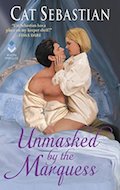
Unmasked by the Marquess by Cat Sebastian (Avon Books: historical m/nonbinary):
Three months ago I talked about cross-dressing heroines and Suzanne Enoch’s Lady Rogue. Kit Brantley had been raised as a boy but ends up living as a woman: in Cat Sebastian’s newest, heroine Robin Selby had adopted her late lover’s identity for practical reasons (to protect the man’s sister, who’d been left destitute by the will) but finds that dressing in breeches and waistcoats feels right in a way that gowns and chemises never have. What follows is a long exploration of the difference between what it means to do what’s proper and what it means to do what’s right. It’s a resounding step towards inclusivity for a much-loved but often-dicey romance trope.
Let’s follow Robin’s example and be practical to start: I’ve seen the heroine’s gender described elsewhere as nonbinary, and doing that in a Regency setting definitely presents some challenges. For instance: pronouns. Robin uses she/her for her internal monologue but definitely identifies with gentlemanly things when it comes to manners and mode of dress. One content note: hero Alistair does more than once refer to Robin as a ‘deceiver’ for wearing waistcoats, and pitches a truly epic fit when he first learns of the name-swap. He does not, importantly, have to ‘get over’ the essential fact of Robin’s gender; he’s into both men and women and reasonably comfortable with that. But it was a scene I worried might hit some people more sharply than others, so I wanted to note it here.
Now the subjective stuff: this book is a pleasure that cuts deep. It’s a slow-motion stained-glass heartbreak, all sparkling color and velvet shadow and sharp edges slicing you without mercy. Cat Sebastian definitely draws her couples as strong contrasts, and here Robin is sunshine and springtime, while Alistair is all brooding stodginess and stern propriety. Up to a point, of course. Robin’s charm masks a yawning fear that she has no real identity — no family, no status, and most painfully no name — and this makes her prone to extreme self-sacrifice. It’s easy to give up everything when you feel like none of it really belongs to you. And Alistair’s tendency to go full supervillain to protect his loved ones clearly brings him more devious pleasure than it should: he flings money at problems, wields his privileges like weapons, and at one point actually threatens an antagonist while sitting in a library chair and stroking a cat. He’s been working all his life to be the opposite of his spendthrift, drink-sodden, orgy-loving, bastard-fathering father. Watching him learn to let his human heart show is satisfying; watching Robin learn to really feel as carefree as she pretends is painfully sweet. I devoured the whole thing in a single afternoon and was then good and useless for the next three days. If you need something to give you a book hangover like you’re Bertie Wooster after a bender, this is the book for you.
Alistair walked directly to the stables and was in his traveling chaise within a quarter of an hour. By the time he realized he was still holding the kitten it was too late to turn back.
This Month’s Vintage Harlequin Heroine

Under the Stars of Paris by Mary Burchell (Harlequin Romance: contemporary m/f):
A good category romance has all the effortless, exquisite clarity of a fine diamond: everything that doesn’t sparkle is ruthlessly polished away until only the light is left. This is the oldest romance I have reviewed so far, but even though it was first published in 1954 it fizzes like the cork was just popped. Heroine Anthea is freshly heartbroken and semi-destitute in mid-century Paris; she stumbles into a hair salon to avoid an awkward encounter and lands herself a job as a mannequin (read: model) for the best couture house in France. She steps onto the runway in a dazzling wedding gown — only to see her caddish ex-fiancé there in the front row, with his new bride-to-be! The stakes are personal but they feel infinitely meaningful; this is the kind of book where a spill of Merlot is as good as a murder. Like most categories of the old school, it’s told entirely from the heroine’s point of view, so that we are not even certain of who the real hero is until very nearly the end of the book. (We can be reasonably sure it’s not the caddish ex-fiancé.) It’s all a delightful confection, full of lustrous fabrics, seething jealousies, and shimmering tears.
Also, this book helped fight Nazis.
Okay technically not this book — but its author Ida Cook (writing as Mary Burchell) used the funds from her romance career in the 1930s to fund trips to Germany for herself and her sister. They went ostensibly to see some of the great opera performances of the age. In reality, they were smuggling valuables out of the country to help Jewish refugees, in direct defiance of Nazi law. Britain only allowed immigration for those who had either employment or sufficient funds to support themselves, but Jewish emigrants weren’t permitted to take possessions or funds out of Germany. It was a terrible bind. The Cook sisters would arrive at the border in plain clothing, and leave bedecked in jewels and furs, which they’d return to the owners once reunited in Britain. If any border guards asked why they were so kitted out, they played the eccentric spinsters and said they had untrustworthy relatives at home, so they always traveled with all their jewelry. This worked at least a dozen times, and after the war the sisters were named Righteous Gentiles.
“You are what you do,” Ida is quoted as saying. We should all have such clarity of purpose.
Kissing Books: Don't fuck Nazis
Every month, Olivia Waite pulls back the covers, revealing the very best in new, and classic, romance. We're extending a hand to you. Won't you take it? And if you're still not sated, there's always the archives.
Romance’s greatest strength can also be its greatest weakness.
Romance’s purpose is to map in detail the intimate geography of the human heart. The genre invites us to peer deeply into a hero and/or heroine’s secret world — even when the characters are familiar types (the spunky ingenue, the troubled aristocrat) every romance heavily prioritizes the interiority of its protagonists, in all their messy, muddled glory.
This becomes a weakness when an author forgets to also think about their characters as participants in systems. About power, both personal and political. About money and status and violence and community.
The best romances, obviously, deal with both. Persuasion is a delicate second-chance romance about two people who feel things deeply but privately; it is also an extended meditation on the question of precisely how much weight we should give others’ opinions when steering the course of our lives. Alyssa Cole’s A Hope Divided shows us two brave souls sharing secrets in the attic of a single house; it also touches on Civil War politics, Stoic philosophy, interracial family dynamics, and the ethics of war and resistance.
But then there are the other romances. Stories where an author seems to let herself get too dazzled by the intimacy she’s building between her characters, to the point where she forgets about external systems of power and privilege — including her own — and goes off-track into a dense forest full of thorns and brambles and howling wolves.
This is where you get the Nazi heroes.
I mean, fuck, let’s be clear: this is the best-case scenario for why we see this particular shade of awful — the kind where the hero’s “not really one of them” even though he’s very highly placed within a brutal, fascist regime. Because the author somehow fails to appreciate the difference between a bad boy and a bad man. As with the infamous Nazi inspirational romance from two years ago — yeah, you heard me — this new book is a failure of empathy on a colossal level: redeeming its Nazi-turned-Stasi hero (WTF WTF WTF) requires you to gloss over violence inflicted on every other inhabitant of this fictional world. NOT TO MENTION real-life readers, for some of whom this experience is not fictional.
This hero’s HEA is only (barely) imaginable if you limit your gaze to one made-up couple and never, ever, ever look up.
I do not want to get sidetracked here. Nazi romances are definitely A Problem, but for the purposes of this column they are not The Only Problem. They are the most flagrant symptoms of a broader malady that’s frustrated me for some time. Blistering critique of a single bad book is vital, but so is trying to figure out why one specific type of bad book keeps showing up and crapping in our coffee.
It’s impossible not to see a kinship between the above books and many romances that less immediately advertise their terribleness: books where the heroes sexually assault the heroines (but is forgiven when he grovels later), books that gloss over domestic violence and abusive behavior (he just wants what’s best for her, and she doesn’t know what she wants really), books that attempt to grapple with racism by centering a white character’s feelings about it (ditto homophobia and transphobia), books where the hero’s a straight-up kidnapper or murderer and the text expects us to believe this is NBD because he just feels so bad about it later, you guys.
All these books have the same flaw: they expect us to focus completely on the inner feelings of the specific hero — it’s nearly always the hero who gets a license to be terrible — and ignore emotional or physical harm done to anyone else. It asks us to sympathize with the powerful because deep down, aren’t they the real victims?
Reviewer Jennifer Porter recently wrote an incisive thread about what she termed the Problematic Ever After — HEAs that she couldn’t believe in, for reasons varying from irredeemable jerkishness to a severe, sustained imbalance in the concluding relationship. She states that while she can’t believe in these books, she likes that they force her to think. Romance readership is full of supposedly frivolous comment threads about popular characters (like this one) that are actually lengthy and nuanced conversations about forgiveness, redemption, ethics, and trust. (Extremely Chidi voice.) We talk about consent (both enthusiastic and dubious), and realism, and hope, and regret, and have very complex, mostly respectful debates about rape fantasies and survivorship and tokenism and representation. All the time. You know, for fun.
And then another “edgy romance” comes along to claim it’s the hot fascists who most deserve empathy. Or slaveowners. Or stalkers. That this is somehow a daring and iconoclastic position, instead of the simple fetishization of power. And when many of us voice our horror at this amoral position, we’re told we’re stifling creativity or free expression. The truth is, romance’s warm empathic glow becomes a weaponized laser when it’s too narrowly focused. It’s an ethical error people keep choosing to make, and almost always for the amoral (white, straight, male, cis, able-bodied) hero’s benefit.
We believe in people, it seems — but we believe in some people more than others.
Am I saying you shouldn’t write romance with fascists as heroes? Yes I fucking am. What’s wrong with you?
But more importantly, I’m telling you — telling all us authors — to really stop and think about not just what you’re writing, but what you’re publishing. What are you spending time and thought and marketing money on? What is taking up real-world or digital shelf space?
Romance is never a neutral genre. When you designate someone as a hero or heroine in a romance, you are making an ethical claim. This is what distinguishes it from porn — yes, even those super-kinky erotic romances where every scene’s an endless orgasmfest have an ethical framework built in. Porn is about someone being turned on. Romance is about who people turn into.
What choices is your book asking us to support on its characters’ behalf?
Again, it’s about systems. Right now in this country we are seeing a surge in anti-Semitism and anti-Muslim rhetoric. We see white supremacy openly tied to the violent power of the state. Our neighbors are being deported, our children are being shot in appalling numbers, and our government hastens to cut medical coverage, especially for disabled Americans who depend on it the most. Flint still doesn’t have clean water, Puerto Rico doesn’t have electricity, and indigenous women are going missing and being murdered at frightening rates.
To look at all this, then to decide that now is the time your self-pubbed fascist hero could really drum up some buzz and rake in the royalties — this is a selfish, selfish choice at best. At worst, it’s outright malicious.
I’m not putting limits on art. Authors, write whatever messy morality you feel like — so long as you’re only poisoning your own sandbox. But when it comes time to publish it, promote it, and profit from something this questionable, you should expect a more rigorous critique.
It’s not about what you’re writing. It’s about what you’re taking money for. That’s what shows us whose side you’re really on.
Recent Romances:
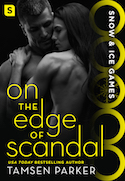
On the Edge of Scandal and Fire on the Ice by Tamsen Parker (Swerve, contemporary m/f and f/f):
Tamsen Parker has the canniest timing in all of romance, because just as social media was exploding about the Olympics—and especially the super-duper platonic friends who just kiss each other on the neck and curl passionately around one another to romantic anthems gold-medal magic of Tessa Virtue and Scott Moir—she released not one, but two books in her Snow and Ice Games series. On the Edge of Scandal features a hockey coach struggling with chronic pain and his star player struggling with a douchebag boyfriend. (One of these troubles is more easily eliminated than the other.) Coach/player romances aren’t everyone’s cup of tea (especially after the recent Nassar trial) and this book has to navigate carefully to make it through the minefield of squick. Like the mentor/mentee relationship in the previous Seduction on the Slopes (m/m, and hilarious), this is accomplished in no small part by what I’ve come to call Parker’s Chill Feminist Bro Hero Voice: Ash’s inner narration is self-deprecating, casually curse-filled, and humorous—a somewhat hapless but never heartless masculinity that values protectiveness over possessiveness. More than any other author, her heroes feel like dudes you could be friends with in real life. This one didn’t quite stick the landing, but it was still a solid read.
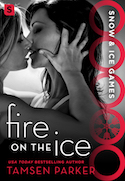
Fire on the Ice, on the other hand, is like taking a bite of what you thought was a caper and learning it’s a pepper, one of the absurdly hot monster kind, and it got where it was today by beating up all the lesser peppers until it absorbed all the capsaicin the entire pepper universe could produce. Which is to say: it’s flaming hot, and agonizing, and definitely an experience you want to talk about with others. Short-track speedskater Blaze Bellamy is a fire-haired, libidinous bruiser who lives to be in the spotlight. Figure skater Maisey Harper is known as the Canadian Ice Princess: cold and aloof and outwardly prim. Inwardly and in-bed-wardly she’s bossy and creative and strong and more than a match for the other woman. The two have hooked up before, so it’s not surprising that the sex is quick to get really, really filthy (in the best way)—but this is a romance, so even amazing sex isn’t what’s going to get us to the end. No, this is the story about two people getting their feelings all tangled up; it’s about fear and vulnerability and hope and betrayal. My only objection is that it felt like there were one or two scenes missing—say, a moment where Blaze overhears a voicemail from Maisey’s parents and confronts how emotionally cruel they’ve been to her, or a moment where Maisey meets someone, anyone else in Blaze’s life. (Blaze doesn’t appear to have friends on the page, which is an odd thing now I come to think of it.) Sometimes the end of a romance feels like less like a conclusion and more like the beginning of a new book, one which the characters are starting to write together. This is definitely one of those.
I’m not going to make her sorry for giving up control for a while. Never make someone sorry for something you’d like to do again.

Queen of leflaria by Effie Calvin (NineStar Press: fantasy f/f):
I have a terrible weakness for a scoundrel with heart of gold, and most especially scoundrelly princesses in lesbian fantasy novels. This particular book gets off to a slow start (so many fantasy god names, and we only just got here!) but the pace picks up as soon as Crown Princess Adale of Ieflaria stomps grumpily onto the page with a hangover and grass stains on her silver gown. Adale is being pressured to marry Esofi, princess of Rhodia, who was betrothed to Adale’s older brother until the crown prince’s recent death. Esofi brings an entourage of battlemages to help with Ieflaria’s current dragon problem, and her arrival naturally stirs up long-simmering political tensions and conspiracies. Adale has nothing against Esofi (whose blonde, plump prettiness appeals to her) but believes herself completely incapable of being the kind of queen her country needs. Her late brother’s shadow looms large and brings on a torrent of endearing self-doubt.
Gentle, devout Esofi, meanwhile, may look like “a fat little rosebud,” but that’s only until she gets angry enough to send a bolt of raw magic through your face with her bare hands. Because she’s a badass dragonslayer. Who is very aware of her responsibilities to her adopted people, even though she yearns to be loved for who she is and not just how useful she can be.
Reader, I loved them both so much by the end.
The book admittedly is not without flaws—the prose is at times painfully direct, which makes it skew toward YA even though it’s marketed as adult—but what it does well is so rare and to be treasured that I have zero qualms recommending it. I almost put it aside in the early chapters, and I shudder at the near-miss, because by the halfway point I couldn’t put it down. Remember last month’s Old Skool story with dragons that I felt was almost something special? This new one is the real deal: a queer-femme-centric, trans-inclusive, lushly realized fantasy romance with nonbinary forms of aristocratic and military address, political intrigue, dragons, political intrigue among dragons, and manipulative gods. And a stupidly gorgeous cover. Do not miss this one.
“What about your parents?” asked Adale.
Esofi swallowed visibly. “My father is a good man,” she said at last. “Our people love him for his patience and understanding.”
“And your mother?”
“Oh, they love her too,” said Esofi in a brittle tone. “Everyone loves her.”
“I am sorry,” whispered Adale.

Dance with Me by Alexis Daria (SMP Swerve: contemporary m/f):
In the first book of this dynamic series we saw dance reality show judge Dimitri and star professional dancer Natasha (both secondary characters) hooking up, and arguing, and hooking up some more. We thought they were just dicking around. We thought it was only physical. But oh, my friends, we were wrong.
Dimitri’s crazy about Natasha. Has been from the moment they met. He’s tried to play things casual until he’s sure of how she feels, which is a dumb but classic move that usually leaves a hero looking arrogant and unfeeling. And Natasha? Has no idea how he feels. She wants Dimitri desperately—can’t stay away from him—but she imagines herself as alone and unloveable so thoroughly that it blinds her to any other possibility for her future.
The emotional suspense this generates is exquisite. This is the kind of romance where the characters’ yearning becomes an ache in the reader’s gut, where you occasionally have to put the book down to yell incoherent things at the wall because there are too many feelings to stay locked silently inside your body.
Both Dimitri and Natasha are driven, talented, ambitious, and hard-working. They’re both immigrants, and have parallel but not identical struggles around how they’ve dealt with that experience. Family, creativity, friendship, when to ask for help and when you need to stand up and get things done on your own—this book has a lot going on, but it never feels like too much. It has real-life complications and nuance but is never muddy: there’s no one easy answer to a serious problem, but there are a lot of ways to figure out new solutions and do a little bit better than you did before. This book believes hope is a process, a muscle you can develop with practice, and that’s something we all need at this moment in time.
I enjoyed the first book, but this one? I fell utterly in love. Head over heels. And doesn’t it lift your heart when an author’s second book is even better than their first? I can’t wait to see where this author goes next. I’m along for anything she’s got planned.
Hope. That was it. That was the thing fluttering in her chest like a bird trying to fight free from a cage.”
This Month’s Psychically Gifted Historical Heroine Finding Love and Solving Murders in a Cross-Genre Smorgasboard

Second Sight by Amanda Quick (Jove Books, historical paranormal m/f):
It can be hard, sometimes, for readers who like their genres all to happen at once. You can find mystery, and romance, and mystery romances (more commonly known as romantic suspense); you can find fantasy, and romance, and fantasy romances, and romances with fantasy elements (or paranormal romances—don’t get me started on the distinctions between these subgenres or we’ll be here all day). Less common is to find one book or series that blends all these elements together. Especially in a historical setting, which is my absolute favorite. So it’s no wonder I got hooked badly by Amanda Quick’s Arcane Society series, where psychically talented Victorians hunt killers and thieves and megalomaniacal alchemists through the gaslit alleys of London. These books can be a bit like Mercedes Lackey’s books—unsubtle wish fulfillment tales, where you can see all the gears at work while you read—but it’s so much fun watching everything come together that the lack of subtlety matters less than that ultimate reader question: What’s going to happen next?
Second Sight, the first book, is still my favorite of the series on account of the heroine, Venetia. She’s a professional photographer in an era when the process is new and the chemicals volatile so poisonings and explosions are common accidents. She can also see auras, which is one reason her photographs always appear to capture the essence of their subjects. She is hired by rich eccentric Gabriel Jones to photograph the art collection at his country manor—and while she’s there, she decides to let him seduce her because she’s attracted to him and has never had the chance to be seduced before. Turns out, sex is fun! But they don’t get to go for a second round because thieves begin attacking and Gabriel hustles Venetia out a secret passage to safety. Later, Venetia reads about Gabriel’s death that night, and mourns the loss of someone so intelligent, kind, and hot. (She could tell a lot of this from his aura, you see, even though they’d only just met.)
So she borrows his last name.
It’s a sound business decision: an unmarried young woman would have a much harder time setting up a photography studio than a widow, so Venetia Milton becomes Mrs. Venetia Jones, whose late, lamented husband died tragically and left her the money to start her business. Her photos become an instant fad among the aristocracy, who are eager to purchase portraits in this mysterious new medium.
And then Gabriel Jones shows up, very much alive, and very interested to know why Venetia is going about town posing as his widow. Also, the thieves who interrupted that first night are still out there, they’ve graduated to murder, and they have their sights set on Venetia.
This is where the book really starts to have fun. There are aristocrats whose external beauty does not mask the terrible sins in their aura. There are adorable scenes with Venetia’s matchmaking family, who decide Gabriel is Just The Thing She Needs. There are murders by shadowy figures in fog-laced streets, pursued by Gabriel’s psychic tracking gifts, and a fantastic scene where Venetia dons an impeccably tailored men’s suit and takes Gabriel to the drag kings’ club for a fun night out. It’s a book that throws in everything but the kitchen sink, but it stays anchored in the emotional connection between two strong, dazzling characters. Great for chill winter days, when it feels like the world will never be green again.
He was the man she had been waiting for, the lover who was destined to ruin her. But first she wanted to photograph him.
Kissing Books: taking it on the ego
Every month, Olivia Waite pulls back the covers, revealing the very best in new, and classic, romance. We're extending a hand to you. Won't you take it? And if you're still not sated, there's always the archives.
My favorite alpha heroes in romance are the fragile ones.
They don’t seem fragile, at first. Consider Alec Kincaid from the RITA-award winning classic romance The Bride. He’s a big, burly Scotsman, the much-feared laird of his clan, who kills enemies easily and without a second thought. He’s manipulative and self-centered and emotionally closed-off after the mysterious death of his first wife. He is the most important man in his world, and he’s not afraid to throw his weight around and give orders to absolutely anyone short of his king.
In short, he is a giant ego-balloon, and the bigger he swells the more fun it is to buckle in and wait for the inevitable pin to find him.
Because of course Alec’s self-inflation has to be punctured. Anyone who’s read more than, say, three romances can see it coming from chapter two. He’s going to be matched with a tiny, too-pretty, naively optimistic virgin with violet eyes named Jaime, and this insignificant non-entity — with no physical strength, legal power, or wish to do harm — is going to turn him entirely inside out. She’s going to disobey him, undermine his authority, and fearlessly demand what she needs. She’s going to convince him she’s right to want to help people, to be kind, to trust others. She’s going to make him question everything about himself, and — here’s the kicker — this big, tough, weathered warrior is going to be grateful for all the changes. Because a romance hero may be strong at the start of the book — but it’s the events and transformations of the plot that turn him into a hero.
As much as we talk about alpha males in romance, ego-balloons are not only carried by musclebound alpha heroes. Elizabeth Bennet in Pride and Prejudice famously has her own self-regard deflated a bit before the happy ending. Shelly Laurenston’s shifter heroines tend to be as sexually frank, egotistic, and casually violent as the heroes. (That’s a compliment, by the way: those books are fun.) And there’s a whole strain of romantic comedies where the hapless city girl in too-high heels has to learn humility from a hard-working country boy in work boots. General patriarchal pressures often apply: there are too many toxically masculine heroes who aren’t de-bro-ified enough, and far too many haughty (or simply human) heroines whose abject embarrassment we’re supposed to wallow in. The lines are all highly subjective: one reader’s too far is another’s not far enough for what they did/said.
I started thinking about egos and punctures while reading Alyssa Cole’s upcoming A Princess in Theory (reviewed below). Our hero Thabiso is a handsome, educated, wealthy prince from the South African nation of Thesolo; he’s been raised with all privileges and the weight of decision on his broad, young shoulders. It has not, shall we say, left him struggling with the burden of self-doubt. Heroine Ledi has mistaken him for the new waiter she was supposed to train, and to get close to her, Thabiso plays along: “He was feeling rather pleased with himself. Not only was he an excellent negotiator and a shrewd businessman, but having completed the tasks assigned him, he was well on his way to becoming a master waiter, too.”
This is the ball being tossed in the air.
And then the racket comes around and whack: ten minutes later, our master waiter is dumping fish into the lap of a VIP, setting fire to the fondue station, and getting unceremoniously fired by our heroine.
It’s all about the expectations. Romances live and die on the alchemical reaction of reader expectations combining and combusting with the reality of the text. We expect a happy ending — but what has to happen first? We expect a hero to be, well, heroic — but what if instead he is, as the old Princess Bride blurb goes, a son of a bitch? Of course there are plenty of alpha heroes whose alpha-ness isn’t challenged because it’s the foundation of the fantasy (dukes, billionaires, vampire Viking angels), and while I understand the escape those books offer I find myself much more gratified by books where the alpha’s overweening ego is the set-up to an eventual well-earned punchline. It’s more dynamic, for one thing; it’s what Nisi Shawl points to when she talks about narrative tension: “the gap between ‘what is’ and ‘what must be.’” What is: the hero’s self-image. What must be: his transformation.
The ultimate result is something that has long been deeply uncool to talk about with respect to literature: a moral. When overbearing alphas change their tune, when egos get bruised and recover, there’s always a moral lesson in it. Sometimes it’s as simple as: Love matters. Sometimes it’s dark and complex and nuanced with, ha, over twoscore shades of grey. But very nearly all romance has some element to the plot that’s trying to tell you how to be a better person: sexually, emotionally, or among the people in your community. It’s why it’s not terribly far-fetched for Jennifer Weiner to argue in the New York Times that romance novels fill in a lot of gaps left by sex ed curricula that are either abstinence-centric, queerphobic, or both, or that limit the conversation around sexuality to mere biological terms while ignoring issues of consent, desire, and self-expression. There is a lot about sex that is more about words and thoughts than it is about body parts, and romance is the literature we’ve developed to grapple with that.
This month the egos are out in full force and they’re all — well, mostly all — cruising for a bruising. We have a self-involved vampire who is quite literally heartless; a brash dance student-turned-professional choreographer who has no problem telling his former dance teacher exactly what she can do with his now-grown self; the charmingly self-important African prince mentioned above; a frontier mail-order bride who’s frighteningly handy with a rifle; and a mercenary warrior heroine whose stubborn pride is mighty enough to change the destiny of her world.
Recent Romances:

Curses, Foiled Again by Sera Trevor (Ninestar Press: paranormal m/m):
Trends or no trends, a good vampire novel is never out of style. This offbeat gem is less Interview with the Vampire and more What We Do in the Shadows, with that blend of the comic and the horrific that’s so hard to get right and so delicious when done well. Felix is a vampire living in LA whose preternatural strength and thirst for human blood are balanced out by his wistfulness, impulsive sincerity, and the inescapable fact that he’s dumb as a bag of hammers (a side effect of the vampire condition). Watching him occasionally try to be cunning is adorable: think a Goth Jason Mendoza from The Good Place. He becomes annoyingly fixated on a witch named John, who is living under a truly frightening, isolating curse, and in the way of all romance they slowly annoy one another more and more intimately. There are some truly horrific moments in the course of the plot — as well as actual consideration of the predatory nature of vampiric feeding, which is not the lightest of reading — so best keep this book for a moment when you’re in the mood to shiver a little. But if you’re a horror romance fan (I see you! I know it’s hard to find your catnip!) then you’re going to want to give this one a try.
He paused for a minute, trying to put together all of the feelings inside of him, so many of them buried. He felt like an archaeologist, uncovering his own soul piece by piece.”

On Pointe by Shelly Ellis (self-published: contemporary m/f):
One way to quickly establish a heroine’s character is to show us who she is not. Here we meet Bina, a dance teacher at a DC studio, meeting her ex for coffee for the first time since she walked in and caught him cheating. She’s been lonely since the breakup, and she’s worried she won’t be able to resist him if he begs her to take him back. But that’s not why Carl wanted to talk. No, Carl has started his own architectural firm — in a partnership with the woman he was cheating with — and they have a big client who wants to buy Bina’s dance studio, tear it down, and built fancy-ass condos in the rapidly gentrifying neighborhood. And when Bina raises her voice in outrage at the callousness of this, Carl tells her not to be such an angry black woman.
What does our heroine do then? Bina dumps a full iced macchiato over his head and walks away, as coffee drips into the fine wool of her ex’s expensive suit.
Reader, by this point I was completely on her side.
And this was before we see how kind she is to her dance students, how much she loves her difficult mother, how hard she works to keep the studio from sliding into collapse. Meanwhile her former student, Maurice (Mo), now grown and hot as hell, has been hired to teach a hip-hop class in hopes of bringing in a new crop of students. Sparks fly, desires are denied, risks are taken, and romance blossoms. This is the set-up book for a three-novella series, so it ends with a bit of a cliffhanger and a Happy For Now rather than Ever After, but it’s written with such rare verve and energy that I’d have been hungry for more at any length.
We have to wait until April for book two — it’s gonna be a long eight weeks.
He eased through the doorway and his chest brushed her shoulder. It was like plucking a tuning fork. He could still feel the residual vibrations of their touch even as he stood in the center of the empty room and looked at the mirrored walls and white ceilings.
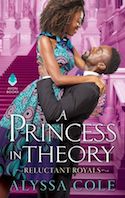
A Princess in Theory by Alyssa Cole (Avon Books: contemporary m/f):
Unlike vampire novels, Cinderella stories never, ever go out of style in romance, and this one is an absolute treasure of a Cinderella tale. We’ve covered our princely hero Thabiso above, so let’s talk about the heroine, Naledi Smith née Ajoua. She’s studying to be an epidemiologist and is super-geeky and smart, so when she starts receiving emails announcing she’s the long-lost princess of Thesolo and they just need to confirm her personal details to proceed, she hits the delete key quicker than a lab rat gunning for a sugar hit. She’s not only cagey about probable scams, either: a former foster kid who got bounced from family to family after her parents’ death, Ledi works hard to keep everyone at arm’s length because she doesn’t believe she’s the kind of person people can love in the long term. She is wary, witty, profoundly moral, and prone to silent, heartfelt cursing when beset by fools and fuckboys.
I absolutely adored her. I love when historical authors write contemporaries, because the world-building muscles honed in historical romance really shine when applied to modern settings. For instance, Ledi tends to look at the world through science metaphors: viruses, lab experiments, evolution, bacilli, bacteria. (One of my notes from later in the book: “Gonorrhea! So romantic!” Not sarcastic. It’s a truly touching moment referencing STIs. Romance Author Achievement Unlocked!) We’re also treated to a realistically diverse and lively New York with Latinx neighbors, Pan-African nonprofits, polyglot citizens, and subway dance performances. Plus a bit of a mystery subplot about a new disease cropping up in Thesolo’s mountain villages. I read until I could not keep my eyes open, slept a bit, woke up at four a.m., decided that was enough sleep to get by on, and finished the last ten chapters as the sun came up.
Then I read the teaser for book two, because it was right there and I still wanted more. And have you seen that cover? Romancelandia is due for a serious epidemic of dress envy as this series continues.

Tempest by Beverly Jenkins (Avon Books: m/f historical):
In Devil’s Cub by Georgette Heyer, straitlaced accidental abductee Mary Challoner shoots the Marquis of Vidal when he menaces her aboard his yacht. In Loretta Chase’s Lord of Scoundrels, seduced bluestocking Jessica Trent shoots the Marquess of Dain when he refuses to marry her to save her reputation. And now in Tempest Beverly Jenkins, First of Her Name, Slayer of Words, has given us Regan Carmichael, who shoots down three outlaws as they try to hijack her stagecoach — or rather, two outlaws and one doctor, who turns out to be the man she’s traveled across the country to wed.
Our heroine apologizes promptly to the doctor. She wastes no time worrying about the outlaws.
Regan is that rarest of creatures: a power fantasy heroine. She can shoot, drive a mail coach, and muck out animal stalls. She can bake, and cook, and help a shy, traumatized stepdaughter heal from a legacy of grief and abuse. She’s independently wealthy enough to stand up to all the petty-minded penny-pinchers in town who try and look down on her for being unconventional — and she has a sapphire satin dress with matching corset and garters that will blow a bridegroom’s hat clean off his head. She’ll know just what to do with that bridegroom when she gets him in bed, too, and she’ll never apologize for having loved someone before meeting the hero.
Does she sound too perfect? Implausible, or invulnerable? It doesn’t read that way. It reads like liberation — like you have a champion there on the page, a vision of strength and hope and heart who cannot help but fight to make the world a better place. When the grieving widowed doctor, who vowed never to forget his first wife, takes about three days to realize he’s halfway to falling in love with his new bride, the reader can only smile in sympathy and say: yeah, buddy, same.
“So you’ll accept my needs in the marriage bed without complaint?”
“As long as you extend me the same courtesy.”
”Good women don’t have needs.”
She scoffed, “And you call yourself a doctor.”
This Month’s High Fantasy Warrior Heroine, Plus The Dragons of Dubious Consent
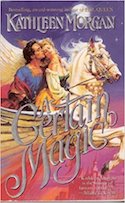
A Certain Magic by Kathleen Morgan
There will always be a part of me that wants a psychic dragon or magical horse I can ride around on while it tells me how brave and special and loved I am. I picked up A Certain Magic because the front cover promised winged horses and the back cover promised dragons. It has been a long bummer of a winter and I thought something fuschia-tinted would be just the thing.
We did indeed get dragons — an adorable, clumsy, loveable baby psychic dragon named Padborn and a big, sinister bastard named Dragon Father — but instead of winged horses, there was a lot of weird sorcerer sexual politics. Readers looking for something at the precise midpoint between Anne McCaffrey and Laura Kinsale will thrive on the whackadoodle nature of the story; readers looking either for gritty realistic fantasy or for consistent magical systems are straight out of luck.
While this book certainly had its rough edges (’twas rampant with Ye Olde Faux Medieval Dialogue), the real meaty mindfuckery is in the what gender and magic mix. Let me sum up as succinctly as I can:
Sorcerers are men who can augment their powers by having sex with women, consensually or otherwise. This can kill the woman. Galienes are women who are magically bonded to dragons. They also unlock their powers through sex (presumably with men, though this is never explicitly stated) and this sex hurts absolutely nobody. Hero Galen is a sorcerer who has sworn off sex after killing the woman he loved (pro tip: don’t take your evil twin’s word that this is actually what happened). Heroine Alena is a mercenary who tracks Galen down to get him to help defeat his twin, who’s been draining local women one by one. Alena is also a galiene, though she doesn’t know it, and she unwittingly bonds with baby dragon Padborn. Again, who would turn down a psychic baby dragon? But this bonding doesn’t unlock her full powers — so Padborn and Dragon Father work together to magically compel Alena and Galen to have Really Good And Surprisingly Graphic Magical Sex. While the dragons watch. Ayla and Jondalar vibes, anyone? Now Galen has his powers back but refuses to use them, and Alena has a bunch of mysterious new magic she can’t actually use herself. They argue a lot about the proper uses of force in self-defense and to stop evil, which is by far the most interesting part of the book.
The weirdest thing about all this sex magic is how not-tawdry it feels. I mean, yeah, dragon voyeurism and enforced desire and gender essentialism and all that baggage — but there’s a New Age-y kind of rudimentary sex-positivity in here that’s quaintly appealing. Alena is not a virigin and it’s not a thing: nobody even brings it up. Masturbation is a perfectly natural urge. Jealousy is toxic, sexual manipulation frowned upon (even the dragons get scolded for this), and rape is objectively evil and will turn the land into a grim, corrupt wilderness (which could explain Westeros — hey-oh!). Love and physical love are not precisely the same thing, but they are connected, and both are not only forces for good but things that actually save the world at the novel’s end. Galen, a pacifist who only barely learns to swing a sword in self-defense, takes over his brother’s castle and begins healing the land’s political and emotional damage, while Alena keeps her dragon, rebuilds the castle’s defenses, trains her own personal army, and explicitly says the only thing she’s keeping from the list of Proper Wife Traits is banging her husband like a drum. My teenage self would have adored this book; my grown-up self can see all the flaws, but feels a little wistful at the incredible story that almost, maybe, could have been if the author had done just a few things differently.
Kissing Books: series-ously speaking...
New Column! Every month, Olivia Waite pulls back the covers, revealing the very best in new, and classic, romance. We're extending a hand to you. Won't you take it?
This month’s books are heavy on new and continuing series, so it’s a good time to look at how series work in romance.
Romance series, like mystery series, tend to be chains of standalone episodes. While the Fifty Shades phenomenon has made single-couple trilogies briefly A Thing (and in my humble opinion, A Super Boring Thing), more commonly each romance in a series will show one specific happy ending per book—meaning the reader who’s missed the first one or two can still jump in with book three and have a reasonably good time. As distinct from a lot of fantasy and sci-fi series, where plot and character tend to accumulate as a series grows in length; much as I love Ann Leckie’s Imperial Radch books, I would never recommend a reader leap right into book three without reading the first two volumes.
This structure also means that savvy romance readers will start the series on the watch for heroes and heroines of future books. Hence the term sequelbait, referring to a secondary character who will probably (or hopefully) get their own complete romance in volumes to come. Best friends, siblings, ex-lovers, and occasionally even the villain can nab the romantic spotlight, as we saw with last month’s Mary Balogh. Occasionally this goes very wrong, as when Gena Showalter announced that the popular couple she’d been teasing for eleven books would not actually end up together, leaving readers feeling manipulated, betrayed, and exploited for cash. Occasionally, though, authors can use those same expectations to set up a grand and glorious punch to the heart. I’ll never forget the delicious shock Zoe Archer pulled off in her underrated Hellraisers trilogy: four dissolute aristocrats in Georgian London sell their souls to the Devil, fall in love, have a moral awakening, and fight to break the contract. Four heroes, but only three books, because she flat-out killed off one of the sequelbait—for very solid story reasons, so that after the initial surprise there was only the rush of satisfaction and Ah, yes, should have seen that coming. It was a bold and brilliant move, and it still leaves me breathless to think about.
The great thing about sequelbait is it suggests that, in theory, anyone can be a heroine. Side characters are not less important overall, they are merely less central from a limited perspective. Everyone has the potential for a happily ever after. In practice, however, sequelbait is often identified because the markers of romance hero- and heroine-dom can be very narrowly defined: young, cis, white, thin, able-bodied, and straight. It’s not changing as fast as many of us could wish. Whole sections of romance refuse to allow queer characters at all (looking at you, inspirational romance). Romantic suspense author Suzanne Brockmann has received much vocal praise for including gay romance arcs in her popular Troubleshooters series; she has also received plenty of critique from queer romance authors and readers pointing out that she includes those arcs as secondary novellas and subplots, supplemental stories rather than full standalone books alongside the straight couples. Meanwhile a known chunk of m/m readers will flat-out refuse to read anything with m/f sex on the page at all, with suppressive results on the number of bisexual characters in romance, even from queer-friendly publishers.
The series whose books we see below are pushing back against much of this. Alisha Rai’s Wrong to Need You, second in her beautifully soapy Forbidden Hearts trilogy, features a bi heroine in a matter-of-factly diverse town. Tamsen Parker’s Snow and Ice Games series promises both an m/m and f/f couple in future books; the first one is a lively adrenaline rush perfect for winter reading. Cat Sebastian begins a new m/m historical series, Seducing the Sedgwicks, with a gorgeous, thoughtful take on a high-concept premise, and a vicar hero whose sexuality is never at odds with his faith, only with society’s denial of it.
Happy reading!
Recent Romances:
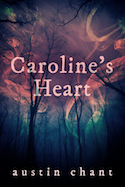
Caroline’s Heart by Austin Chant (self-published: trans m/trans f Western fantasy)
Fantasy romance, like all fantasy, lives and dies on how deeply the reader can sink into the made-up world—and oh, how easy it was to tumble into this one. All the weight and swelter of a hot Texas summer (plus magic!) grabs you on page one and never lets go. Hero Roy is wry and weathered and loveable as only a soft-spoken cowboy can be. He says ma’am a lot, which I know will appeal to plenty of readers. As a trans man, Roy’s learned to keep himself to himself and stay far away from trouble, so of course he ends up risking his life to save a pretty trans witch in the middle of a saloon brawl. Cecily, our witch, makes magical prosthetics (hands, spines, etc.); she is lonely but prickly and her great ambition is to bring back her girlfriend back from the dead. Roy’s cure requires her to give up a precious object she’d been hoping to use for the resurrection spell, and the rest of the novella is about the achingly sweet progression of two heartsore people coming to care deeply for one another. It’s a lovely and rare piece of work, not least because of the beauty of the love scenes, which with two trans characters come with more risk and vulnerability built in from the start, making the rewards feel that much sweeter. This is a shout it from the rooftops kind of recommendation. Do not miss this one.
The human body is a complexity of anchors and pulleys, but Cecily has devoted herself to understanding it, tailoring the tension and slack of each spell-thread until the prosthetic leg can bend and stretch gracefully.
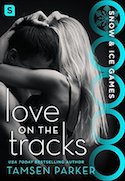
Love on the Tracks by Tamsen Parker (Macmillan: contemporary m/f):
Tamsen Parker’s first book was an erotic romance with an Orthodox Jewish heroine—so you know she’s an author who’s always up for a high-concept challenge. Love on the Tracks, first in the Snow and Ice Games series, features a boy-band star singer and a gold-medal hopeful in women’s luge: their cute publicity photo-op goes viral and they start fake-dating to milk the momentum. And then: real feelings! Complicated by the intense and neverending pressure to perform, the ambitious career drive, the lack of time and privacy for anything like a social life, and the machinations of a meddling manager and an obsessively overprotective father. Plus the real risk of death in competition for our heroine. This book has a great many pleasures: the adrenaline rush of high-stakes competition, the peek at pop songcraft, the fact that heroine Rowan is the hard-bodied, cut, muscular one and hero Zane is the one most often described as pretty. Zane is also the emotionally tuned one—he’s an expert at riding out the ups and downs of his bandmates’ moods—while Rowan is cagey about feelings but completely physically uninhibited. It’s a fun mix: the banter is gentler and less antagonistic than The Cutting Edge (my sports romance all-time high-water mark) but there’s still plenty of drama to keep the pages turning. Sweet and sensual as good hot chocolate, with a lovely bright peppermint spike.
What she’s doing, a simple but pretty harmony, hits something in my soul. Like a cold glass of lemonade on a hot summer day, it shouldn’t be remarkable—how many glasses of lemonade have you had in a lifetime?—but there’s something about it that will remain with me for the rest of my life.
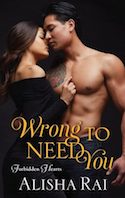
Wrong to Need You by Alisha Rai (Avon: contemporary m/f):
While I believe the definitive review of this phenomenal book has already been written, allow me to add a little something to the conversation: BJIFDSJBKDSBJKADVBJAVBJKAVKBJ!!!
… Alright, let me add a bit more. Christmas night I arrived home from a day full of dinner with good friends and excited puppies and some exhaustingly painful family drama. I felt achey and chilled, and a tenderness in the throat warned I was coming down with the vicious flu that’s been going around. Bed was a siren song. All I wanted was to read a chapter or two of something distracting while the cold sheets warmed up.
You see where this is going. Sore throat, exhaustion, even the soporific warmth of the mini-dachshund snuggling up against me like a living hot-water bottle—all these fell away under the spell of a true page-turner. I did not stop reading until that last chapter was finished. If the third book had been available, I’d have kept right on reading. Sadia’s desperate struggle to do her best as a mother, as a boss, as a widow—Jackson’s careful self-protection and paralyzing shyness, the dangerous shards of old pain too long carried—the electric spark and sizzle of the love scenes—the atmosphere of old secrets dusted off and new chances taken up—it’s the finest, sweetest melodrama we’ve seen in a very long time.
Nights like this are what I read romance for. Books like this are why I read Alisha Rai.
Her wardrobe had slowly evolved to clothes she could wash and wear and could be easily mixed and matched. It was more efficient, and she had tried to become as efficient as humanly possible. She wielded lists and journals and pens the way other people might wield swords.

It Takes Two to Tumble by Cat Sebastian (Avon Impulse: m/m historical):
A queer Regency Sound of Music—you’re either already in or already pulling the emergency escape handle. Me, I can never get enough stern, brooding sea captains in my fiction (Wentworth, Ahab), and when you add in the promise of an adorable vicar hero I am sold. Of course, stern Captain Phillip Dacre has a vulnerable side, and the playful vicar Ben Sedgwick secretly craves order and comfort and stability. It’s not a new recipe, but it sings in the hands of an artist. This book gets off to a somewhat rickety start, but only until the reader realizes that this book has one of the most disorderly worlds a romance has seen in a long while. Landscapes shift with a thought, servants and children and gentlemen are dragons and devils and princes, the hands of the clock speed and slow in mischievous, irregular ways. It’s all officially metaphorical, of course—except that it’s everywhere between the eye and the story, a lens that keeps shifting like a kaleidoscope with the characters’ mood and memories. The literary term is pathetic fallacy—and we even have a Romantic poet character around to blame it on—but analysis aside it really feels as if there is something quicksilver and alive at the heart of this book that refuses to be pinned down to commonplace realism.
Peace, Ben knew, was a series of small things, each insignificant but together making landmarks for a life.
This Month’s Cross-Dressing Heroine

Lady Rogue by Suzanne Enoch:
One of the more fascinating tropes in historical romance is the heroine in breeches, or cross-dressing heroine. (Cross-dressing heroes, while not unknown, are much rarer.) It’s very much in the Shakespearean comic tradition—women dressed as boys, trading witty banter, falling in love with men while knowing that male attire prevents the romance from ever being acknowledged. Done poorly, this trope can shore up harmful gender essentialist stereotypes: the ‘she couldn’t hide her essential female nature’ kind of book. Done well, it can be playful, subversive, even edgy—trans-adjacent, if not precisely trans-inclusive. And of all the cross-dressing heroines I’ve read, Suzanne Enoch’s Kit Brantley remains my favorite.
Kit (née Christine) is the child of a down-and-out nobleman turned smuggler for the French: she’s been raised as a con artist, a pickpocket, a thief, and has dressed and lived as a boy for the past ten years. She’s scrappy as hell. Her father deposits her with the Earl of Everton ostensibly to keep her safely in London during Napoleon’s sudden return to power, but really Kit’s job is to find out which meddling peer has been messing up their smuggling operations. Naturally, it’s the earl himself; naturally, he and Kit fall in love.
This trope often has the hero spend long chapters agonizing over his attraction and fretting, as Mindy Hung put it for the Toast, “am I a gay?”. This book plays no such games. Everton figures out Kit’s disguise on page 15, a day after they meet, and the truth makes him and Kit co-conspirators in a delightful, mischievous way. Kit gets a new exquisitely tailored masculine wardrobe—to her great delight—makes fast friends with Everton’s cronies, and generally swans about charming Society and making all the girls swoon over how handsome she is. Everton’s mistress figures out the truth and jealously begins blackmailing the earl, a threat which will ring familiar to anyone who knows how someone’s transness can be attacked in real life by bigots and the unscrupulous. In between blackmail, familial betrayal, and international espionage Kit begins exploring what it would mean to live openly as a woman: it’s something part of her yearns for, even though it is unfamiliar, uncomfortable, and downright frustrating. She makes a beautiful woman—of course she does—but while Christine Brantley is a more socially acceptable identity, the book takes care not to erase or invalidate Kit’s self as Kit. A few lies are told to make Society happier with the transition, but it’s Kit who charms Everton, breeches and all.
He watched as she strolled off in the direction of the punch bowl. The fact that she knew no one in the room, and almost nothing about the blue-blooded society she found herself in, presumably had no effect on her. Apparently Kit Brantley was afraid of nothing. And though that, too, brought into question her reasons for seeking him out, he couldn’t help the smile that touched his lips. She was afraid of nothing, that was, other than whether her cravat was de trop.
Kissing Books: historically speaking
New Column! Every month, Olivia Waite pulls back the covers, revealing the very best in new, and classic, romance. We're extending a hand to you. Won't you take it?
So now comes the end of this year of years, where the days have piled up like stones, each new one adding a fresh ounce of dread to the heap. I’m always thinking about time in the winter — thanks to my favorite piece of time-travel fiction, A Christmas Carol — but 2017 has played an extra merry hell with my sense of the daily ebb and flow. So I’m peering at time with double-surly eyebrows this December.
Historical romance is the most obvious place to start talking about how romance novels engage with the concept of time, because being set in the past is their defining feature. You recognize a historical romance because shows you Then rather than Now. And it’s usually at least a hundred years in the past — despite treasured examples like the Fly Me to the Moon series and ’s excellent Tang Dynasty books and this disco romance, by far the bulk of historical romance falls in the long 19th century. There are more than a few overlapping theories about why this happened, keeps happening, and will presumably keep happening for some time to come.
For one, the obvious influence of 19th-century genre originators: Jane Austen and Jane Eyre are both still wildly popular and much imitated. People tend to overlook the fact that Jane Austen was depicting her contemporaries but Brontë set Jane Eyre thirty years in the past. Georgette Heyer came along in the early decades of the twentieth century to finish establishing the Regency romance, and by the twenty-first century the genre’s borders had been widened to encompass the Victorian era. (Possibly because of long family-based series with multiple generations? Bertrice Small and Stephanie Laurens come immediately to mind.) Romance authors often start writing to be part of a conversation — they respond to a book that moved them, or correct a book they think could or should have gone differently. So the setting, once established, gets reinforced by later writers. At some interesting point whole sections of this woven net of texts began to drift away from historical reality and became a shared imaginary world (probably around the time Heyer started inventing her own Regency slang to catch plagiarists).
The existence of this shared world means an author can choose to blithely set aside the realities of 19th-century populations (many fewer dukes, many more black and brown and queer people) and handwave matters of plumbing and dentistry and STI rates. The Regency becomes a sort of fairy tale in historical dress — what readers refer to somewhat scornfully as “wallpaper historicals” (see Eloisa James’ A Kiss at Midnight for a particularly obvious example). Let’s be clear that choosing to leave chamberpots unmentioned in 1820s London is a much more forgiveable omission than leaving black or brown folks out of 1820s London. It’s not the fault of any individual book (or duke), exactly, but the overall pattern is distressing. More understandably, there is the attractive public pomp and performance of aristocratic marriage, which is currently flooding my timeline with engagement photos and delighted anticipation for a new princess bride. Whether you’re royal and titled or merely landed gentry, aristocratic marriage is about preserving property against the passage of time: the whole point is to pass the manor house and its wealth down to your heirs, unaltered.
American-set historicals, it seems to me, especially lately, engage with the past very differently. The chronological borders here are expanding, too — edging back into Hamilton territory and forward into the hedonism of the Roaring Twenties — but most are still set during the latter half of the 1800s. Particularly around the Civil War and the colonization of the American West (origins in Laura Ingalls Wilder, Margaret Mitchell, Kathleen Woodiwiss, and, according to this persuasive essay series, Indian captivity narratives). If the majority of British-set historicals keep historical events at a polite distance, American-set historicals use the past very deliberately as a mirror turned back toward the present. (Admittedly, this is at least partly due to my own reader bias as an American.) America in the 19th century was a work in progress in a way England was not and had not been for centuries. The characters aren’t merely heading West, they’re heading here, toward the future; they are creating the towns that will become the cities where the reader presently lives. Southern romances don’t just describe the battles of the Civil War: they are still fighting it — on the one side you have the plantation romances starring white slaveowners that began with Kathleen Woodiwiss and Margaret Mitchell but continue to be published and even unnecessarily, hurtfully reissued; on the other hand you have Alyssa Cole’s Loyal League and Beverly Jenkins’ black heroes and heroines of the Underground Railroad. Are there really readers who can enjoy both equally without some gold-metal mental gymnastics? I remain skeptical.
Which is not to say the American-set historical romance does not have its own particular problems of idealization and erasure. You’ll find plenty of mentions of Native and half-Native American characters in romance over the years, but barely a handful of those have been written by Native authors. And we are currently living through a time where the failures of bootstrapism and capitalism and the wholesale plunder of natural resources are staring us all right in the face — so mining towns and lumber camps and railroad expansion have lost their luster of progress.
And of course, because romance is a multi-headed hydra, all of these generalizations have exceptions. Below I gush about the newest Alyssa Cole, which reaches far back beyond its American setting and into Stoic philosophy; I also review an India-set book with a laboring-class hero that manages to critique the capitalism of the East India Company while avoiding exotifying racist clichés and exploitation of suffering.
See you again in the brand new year. May you give this old one the send-off it deserves.
Recent Romances:
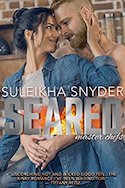
Seared by Suleikha Snyder (self-published: contemporary m/f):
For a moment you couldn’t swing a dead duke around in the romance genre without hitting a stepbrother romance. Some followed in the illustrious footsteps of Clueless, others were more Say It Isn’t So. (Remember Chris Klein?) The mini-trend has passed, as they always do, but thankfully not before Suleikha Snyder got her hands on it. Hotter and more playful than her Bollywood romances, this book walks right up to the comfort line, stops long enough to wink at you, then sashays boldly forward into WTF territory. Whether that’s fantastic or far too much is going to depend entirely on the reader. Naya and Lachlan’s parents married when she was sixteen and he was twenty-one; the youngsters had an instant connection but (importantly for this reader’s comfort) did nothing physical about it. Now a decade has passed, Lachlan’s vicious, controlling father is dead and can’t stand in their way anymore: she’s an international soap opera writer, he’s a billionaire celebrity chef, and they’re both kinky as all get-out. They do it. A lot. Improbable amounts of sex. This book has heard of realism and wants nothing to do with it — every encounter is intense, mind-melting, over-the-top, and damn near perfect. Naya is a submissive but not at all a docile one, and Lock is definitely a dom who needs bossing around every now and again. The arguments are heated. The chemistry is palpable. And the food puns are exquisite.
But his eyes were unchanged, and his mouth still fought smiles like a knockout was imminent.
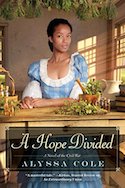
A Hope Divided by Alyssa Cole (Kensington: historical m/f)
Some romances let you escape. This romance will set you free.
Ewan McCall is a Union army interrogator, currently held in a Confederate prison. Marlie Lynch is a free black woman, the unacknowledged daughter of a wealthy white slave owner, who with her white sister brings food to the prisoners (and smuggles information in and out, of course). What begins with small notes scrawled in the margins of ancient philosophy texts flowers into one of the most gorgeous epistolary romances I’ve ever read: Ewan is injured escaping from prison, and Marlie hides him in the Lynch’s attic where she makes healing tonics and salves. They are only feet apart, but the necessity of silence forces them to write to one another rather than converse. This part could have gone on for another thousand pages and I would have treasured every word.
Ewan has leaned on Stoicism to get him through an abusive childhood, but his philosophy of resisting desire is slowly, irresistibly undermined by Marlie’s brilliance and beauty. For her part, Marlie has been betrayed in large and small ways by everyone she ever trusted, and guards her heart with a fierce and furious pride. There is a whole living world inside this book; it feels less like something I read and more like something I inhabited, or devoured, or dreamed. I paused briefly in chapter two to read through Epictetus’ Enchiridion so I could fully appreciate the way the book engaged with his particular strain of Stoic thought — and this was completely the right call, because this romance looks around, rolls up its sleeves, and begins taking the whole world apart. What it means to be a good person, what it means to love someone, what you can and cannot control, how to deal with a personal and political history built on pain and loss — Ewan and Marlie set all these questions to boil, distilling them down to their essences in search of a life pointed toward truth and goodness. And love, though the word only hovers lightly over the text, letting the sheer devotion and bravery of the characters do all the heavy lifting. It is an astonishing, glorious read from which I may never recover.
She should be quiet and unassuming, given the secret she held two flights of stairs away, but apparently her rebellious side had begun to bloom, like a nightshade that unfurls when shrouded in darkness.
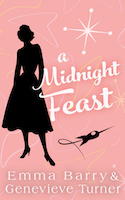
A Midnight Feast by Emma Barry and Genevieve Turner (self-published: historical m/f)
If you’ve read the other books in the Fly Me to the Moon series — midcentury space race historicals set in a fictionalized NASA, and they’re great — you’ll know Margie Dunsford runs everything socially for the astronaut wives. You’ll also know she and her husband Mitch have only the tattered shadows of passion left for one another. This longish novella, just shy of a full novel, stretches backward and forward in time to show us the Dunsford marriage as it rises, falls, and ultimately rises again. Marriage-in-trouble romances are hard to get right because they have to be more inwardly focused than other romance types: wondering if a partner is The One requires much less introspection than trying to decode What Went Wrong, how much blame falls to either side, and whether anything real can be salvaged. This book is a deep dive into the way two people can grow apart without realizing it, and watching Margie and Mitch as they make and unmake a lifetime’s worth of mistakes is both acutely painful and wonderfully rewarding. All this against a 1960s background of Jell-O molds, cocktails, and crinolines. It’s not the heart-smashing masterpiece that Earth Bound was, but it’s a damn fine book.
It had been like playing a part — but he knew all about that. These days he glided through life. He said the lines and did the work until he couldn’t separate the pretense from reality. Maybe that was the secret: there wasn’t any other, better reality. This was it.
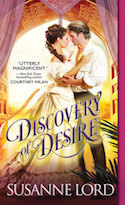
Discovery of Desire by Susanne Lord (Sourcebooks: m/f historical)
The steps for reading this book are as follows. One: Oooh, what a pretty cover! Two: Is that a blurb from Courtney Milan? Three: turn to first page. Four: fall headlong in love with the giant, lumbering diamond-in-the-rough hero and the petite, managing, steely heroine. Seth Mayhew spent years hunting orchids in the jungles of Brazil: now he has come to Bombay to search for his missing sister. His translator meets him at the wharf — but Seth is not the only person he’s waiting for. Turns out the translator has gotten himself engaged to a venture girl (mail-order bride) from England, a poised and pretty problem-solver named Wilhelmina Adams. Minnie, as Seth almost immediately begins calling her, has made the journey with her sister, another venture girl whose fiancé just so happens to be a botanist on the same crew as Seth’s missing sister. There are so few coincidences in romance.
The sense of place here is phenomenal, a tropical port city so vividly rendered that you can all but feel the humid sweat on the back of your neck. The characters, too, are vivid and engaging — Seth’s easy if unpolished charm (as a younger man his sister named him the Worst Flirt in the Midlands) makes for a lovely contrast to Minnie’s formality and directness. The last third of the story returns to London for a bit more angst than was probably required, but this small flaw is more than made up for by the fact that we get a suspenseful orchid auction scene at the climax where all our hero’s hopes for love and happiness rest on one question: how much will these unbelievably rich obsessives pay for their pretty, useless plants?
All these charms aside, this book is an excellent example of how to confront the evils of racism and colonialism while still staying firmly in your lane as a white author. We don’t need a fetishizing setpiece of Brown People Suffering to show how cruel the men of the East India Company are — instead we see how much indifference they wield against our white-but-laboring-class hero and are explicitly invited to extrapolate outward to India and the whole British empire. The Company men’s sense of entitlement is palpable and terrifying, and Seth’s role as an explorer/gatherer for the company lets him reveal how deeply greedy they are as a group: “They take away everything. Anything they can take, they’ll take.” It’s a narrow view onto a vast, complex issue, but it deftly avoids many of the exotifying pitfalls we’ve grimly come to expect from so many India-set historicals. Later scenes of working poverty in London’s lower-class neighborhoods bring this book surprisingly close to a critique of capitalism.
There wasn’t a wrinkle on her skirts or a wayward crease in its folds. And that straight spine was all the sight he had of her — she didn’t fidget and she didn’t turn. Composed, capable, orderly-like. He’d drive a woman like that to Bedlam. But he fell a little bit in love with her anyway.
This Month’s Scrooge of a Heroine

A Christmas Bride by Mary Balogh (Dell: m/f historical):
Like many writers, I often imagine plot as a physical shape: an arc that rises and falls, a set of points in a constellation, a circle coming back around to its starting point. We talk of enemies-to-lovers or marriage of convenience tropes as though they are ready-made vessels waiting to be filled. As though what we pour in there — which is to say, the fluid stuff of character — does not affect the nature of that shape.
If you fill a champagne flute with hemlock, can you still call it a champagne flute?
Plot-wise, A Christmas Bride has the sweet shape of a classic Christmas Regency: Mr. Edgar Downes is a wealthy self-made man whose father is insisting he take a genteel bride before Christmas. He has his pick of docile, well-behaved prospects, but becomes entangled with a woman who is both irresistible and totally unsuitable as a marriage prospect. An unplanned pregnancy compels them to wed, emotions develop and are revealed, a happy ending arrives just when it seems least likely. It’s a shape designed to sparkle, whether you fill it with cheap cider or the most subtle and exquisite blanc de noirs. I’m an experienced reader: I came looking for sparkles. I anticipated a saucy bluestocking or blushing wallflower would prick Edgar’s ego and disturb his comfort. Hell, so do the secondary characters, fresh from their own recent and fertile romances: “The combination of a wedding an an imminent Christmas was enough, it seemed, to transport everyone to great heights of delirious joy.”
Expectation is shattered when we meet the Lady Helena Stapleton, a well-traveled widow of thirty-six. She shows up late to the ball in a red satin gown and a mocking smile, bangs our hero like a drum, and sends him home with nary a cuddle. Her attitude toward her surprise pregnancy is less secret baby and more get this facehugger off of me. She is bitter, brilliant, cynical, sharp-tongued, and, of course, emotionally scarred. Many of the reviews you’ll find mention disliking the heroine — and some of the things she’s done really are terrible. Helena is not a nice person; in fact, she’s the villain in an earlier Balogh book. She is clear-eyed enough to see the shape of the holiday romance crystallizing around her, but stubborn as she is she has to be dragged toward her happy ending under constant cursing protest. She does not want to be dragooned into happiness. She would rather be left alone.
Her presence changes the nature of her story, even though all the plot points came along in the usual order. I’d expected Edgar to be the one transformed by love and seasonal sentiment; instead, we end up with the grand battle of Hemlock Helena Versus the Redemptive Coziness of Christmas: “The great myth lifted ones spirits only to dash them afterward even lower than they had been before. She had feared it this year and sworn to resist it.” She has not been poured into the story like an afterthought — the proper metaphor here is not the champagne in the glass. The image we are looking for is chemistry: we have mixed two elements, and the mixture was beautifully volatile.
Kissing Books: the other "f" word
Every month, Olivia Waite pulls back the covers, revealing the very best in new, and classic, romance. We're extending a hand to you. Won't you take it? You can also peruse the Kissing Books historical archive.
People will tell you romance is anti-feminist. Others will tell you that romance is definitely, strongly feminist. The weird part is: thanks to the genre’s vast and complicated history, both are sort of right. Paradoxes: such fun.
Academic studies of romance during feminism’s second wave argued that the genre upheld the patriarchy by providing glossy ideals of heterosexual marriage to keep the ladies in line. Fictional happy endings were a panacea, a way of soothing the symptoms without actually curing the disease. This theory would seem to explain the existence of wilder, crueler heroes who are often out-and-out rapists: it is generally taken as given that these were more common in early genre romances like The Flame and the Flower, but the culturally inescapable specter of Christian Grey suggests that time here is a flat and sexually aggressive circle. I’ve definitely read books published in the last few years that seem to take great delight in building up the hero’s strength while tearing down the heroine at every turn, and pretending that this was all kinds of feminist and empowering. These anti-heroes are tamed by love – more or less – or else their heroines learn the virtues of resilience and capitulation to forces larger than themselves. The happily ever after here is that the heroine is permitted to survive.
I loathe reading it, but I can’t pretend those books aren’t part of the genre.
Even foundational romances with strong feminist subtexts can be read in less than revolutionary ways. Pride and Prejudice, genre romance’s ur-mother, is clear on the fundamental helplessness of women’s position in the Regency aristocracy but stops short of fomenting outright rebellion; Elizabeth does not overturn the laws of entailment that prevent her and her sisters from inheriting — she only succeeds in winning the Least Worst Dude so her financial future is assured. It is a personal success but not a regime change.
And then there are the other romances, the subversive, outspoken, definitively feminist ones, which author Courtney Milan recently pointed out have just as lengthy a history within the genre. Persuasion, with its adamant defense of women’s fidelity and rejection of male-penned opinions to the contrary. Romance serials in black-owned American newspapers in the 1920s, resisting the oppressive weight of Jim Crow laws and redlining. (Beverly Jenkins once gave a great RWA keynote about the history of black American romance and guess what? You can watch right here.) Queer romance in all its particular flavors, each with its particular history that sometimes leans into and other times away from mainstream New York-published romance. These books have a long lineage — but it is true that they are often harder to find, suppressed or neglected for reasons that you can guess at but which are far too depressing to list here. I believe these stories have been and are always being written; whether or not they’ve been published in significant numbers is the crux of the matter.
In fact, the more types of romance I read, the more it becomes clear that romance has multiple histories rather than one great shared trunk of origin — historical romance has developed in ways very different from the contemporary, to give one broad example, and this only gets more complicated when you start cross-sectioning for variations in race and class and sexuality and geographic background. Romances depend on either reinforcing or playing against cultural norms of courtship etiquette, so when you move from North America to Niger to the Philippines the novels you find show a lot of variation. Which is great! I love seeing how flexible the genre is, how many millions of ways there are to interpret the One Rule (“a happy ending”). Sometimes I get twitterpated thinking about the great subgenres that haven’t even been invented yet. The future is just full of amazing books!
Ultimately, I am less interested in answering the question Is romance feminist? than I am in asking which romances are feminist, and in what ways, and then wondering where I can get my hands on a copy. The short question is a trap, a bad-faith debate that pretends it can magically produce an Approved Authoritative Opinion On What All These Ladies Are Up To. In short, it’s lazy. The second question, though, requires you to engage with a book on its own terms, and bring your personal thoughts and feelings to bear, and then ask about systems of access (is it available in audio book or with text-to-speech? Are there geographic restrictions on the sale? Was this self-published because some Big Five editor told the author they already had “one of those books” on their list this year?) I’ll leap to defend the genre from slander (as we’ve seen) but my main subject is and always will be the specifics of the text. What does this book do well, what does it reinvent, what does it offer and what does it take away?
This month’s books are all about confronting history, both capital-H-History and our characters’ personal pasts. Sometimes the past is a problem. Other times, it’s only our view of the past that needs to change.
Recent Romances:

Her Hometown Girl by Lorelei Brown (Riptide Publishing: contemporary f/f):
This is a gorgeous heartbreaker of a book. Cai is a tattoo artist in a California coastal town: long dark hair, tall and edgy, plenty of ink. Adorable, curly-haired, fragile Tansy shows up in her shop in a wedding dress – she’s just caught her fiancée banging the caterer’s (male) assistant, has called off the wedding, and is getting an impulsive lace garter tattooed around her upper calf. The two can’t help but fall into bed – they’re both so needy in different ways, even if they know they’re both struggling to heal – and the sex is playfully kinky and absolutely luscious. That said, much of this book deals with the aftermath of Tansy’s prior relationship, which was intensely abusive, and I will make it clear there’s an on-page rape early in the book. Normally this would send me running for the hills; here, it’s that rare case where the assault is absolutely vital to the story. It makes clear that Tansy’s ex-fiancée was worse than just your stock romance Evil Ex. It makes her struggles to assert herself again so much more meaningful. It really raises the stakes for the kink, since Cai doesn’t know the full extent of what Tansy is struggling with until much later (though she’s figured out the emotional abuse long before). This is a book that knows love doesn’t fix trauma, but recognizes that love is necessary for healing. My only complaint is that the final resolution felt a bit rushed – I’d have liked to have seen more of Cai’s thoughts at the end.
She leans forward another bit and takes a lock of my hair between her fingers. I hate that’s I can’t feel it. I want nerves in my hair so I don’t miss any bit of this woman.
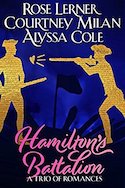
Hamilton’s Battalion by Rose Lerner, Courtney Milan, and Alyssa Cole (self-published: historical m/f, m/m, and f/f)
There are times when superlatives fail and leave only the swear words to carry the point, so believe me when I tell you: this book is so fucking good. I lost count of the times I laughed; I lost count of the times I cried. I went in with the highest possible expectations and I was still completely poleaxed by how vivid the characters were, how brightly the dialogue sparkled, how every page had a line that sliced right through the heart and made me catch my breath. Three of the strongest voices in historical romance poured heart and soul into these stories and it damn well shows.
But it fed my brain as well as my heart, so here are some less sweary thoughts. Every smash hit sparks a flurry of related material, and Lin-Manuel Miranda’s Hamilton is no exception. In addition to all the official secondary material and fan-created works, there are already multiple novels now out depicting Eliza and Alexander’s romance. It’s hard not to feel these inevitably white retellings seriously miss the point: they mistake the subject of the play for the message. Hamilton’s Battalion is a true counterpoint, because like the musical it uses the past not as a changeless artifact, but as a means of reimagining our present and future. These romances are a fierce act of unerasing—Jewish history, queer history, black American history are front and center—and the book does its best to banish the toxic dread that’s kept so many of us frozen in the endless months of this year.
"Andromeda was impulsive, but not wasteful, and something in the way the woman had looked at her screamed loneliness, which was the ultimate waste."
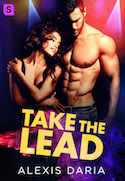
Take the Lead by Alexis Daria (SMP Swerve: contemporary m/f)
Repeat readers will have noticed by now that I love a good high-concept contemporary, and it’s hard to get more high-concept than "lumberjack reality star goes on dancing reality show, falls for pro dancer partner." Fans of The Cutting Edge will want to check out this book for the same hot-spark/long-fuse, opposites-attract, stellar-bickering, manly-man-finds-feminine-art-form-is-actually-super-demanding-and-rewarding kind of catnip. Both Stone and Gina are dealing with some serious family baggage, in addition to the pressures of fame and performance and all the messiness of show business. I was rolling right along, eating up the narrative tension between real and scripted drama, when these words from our hero brought me to a screeching halt: “In the split second that followed, Stone decided not to tell her.” Imagine biting into a huge chocolate chip cookie and finding out those chunks are actually black licorice: the bitter flavor colors everything that follows after. This is a known problem in romance: everyone’s standards for dumpworthy fuck-ups are different, so occasionally you run into a story where no amount of groveling can redeem a character emotionally for you as a reader. (Groveling in romance is very much a technical term.) Gina is a beautifully sympathetic heroine who deserves to have all her dreams come true and I am still just livid that Stone jeopardized that to save himself from being emotionally inconvenienced. Jerk. Though he does do a really gratifying grovel. Whatever. I don’t care. (She said, hitting pre-order on book two.)
Then Gina smiled, and the tension eased. Sometimes he thought her smile was the only real thing in his world.
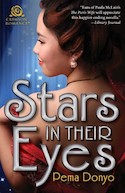
Stars in Their Eyes by Pema Donyo (Crimson Romance: historical m/f)
Romances set in Lost Generation Paris are hopefully growing less rare, because it’s a severely underused setting for glittery, bittersweet, rain-drenched love stories. This swift and slender read is a second-chance romance between an aspiring novelist and a Chinese-American silent-film actress, very light on the sex and heavy on the anguished pining. The prose has the kind of straightforward clarity I usually associate with inspirational or young adult romances—but every now and again those plain sentences resolve into a metaphor so lovely you find yourself breathless: Their breaths fogged together, emitting human smoke into the night air. My god, you could just die. We see more of Gertrude Stein and Alice Toklas than we do of Iris’ family back in LA—though Alice’s cameo is pitch-perfect, and I vastly appreciate the way the hero is in awe of Gertrude as a literary genius and a mentor. It’s not a flawless book; there are a few too many petulant dialogues for my taste, and the plot is a bit simple. But ever since I finished it, I have been unable to stop thinking about rain on the Seine, and a lamplight shining, while a Louis Armstrong song plays in the background. If you have access to a windowseat and a stiff cocktail in a jazz club sometime this winter, this book will match both to perfection.
Iris swung their arms together as they walked, casting a “V” shadow against the sidewalk that reminded him of a bird in flight.
This month’s Medieval Scottish Heroine Made of Pure Honed Steel:

Ransom by Julie Garwood (Pocket Books: Scottish historical m/f)
Julie Garwood was writing scrappy northern girls watching their father get betrayed and beheaded long before George R. R. Martin made the big time. Like Arya Stark, Ransom’s heroine Gillian is profoundly scarred and transformed by having witnessed the brutal slaughter of her family and the wreck of her ancestral home; unlike Arya, Gillian does not close herself off emotionally as a result of the trauma. She may not be an assassin but she is loyal, compassionate, thoughtful, and, oh yes, a stone-cold badass. Completely unafraid of physical pain. Oh, these stab wounds on my arm? The ones that are inflamed and infected? They might slow us down on our cross-country escape, so please do cauterize them with Burny Medieval Mystery Potion, and then we’ll be on our way. Yes, do hold down my arm for the treatment, that’s very helpful, thank you. Pardon me while I go scream a little outside to relieve my feelings, and then we can mount right up and head home. While all the big, tough, musclehead Highland warriors stare at her in awe and fear. At one point the villain strikes her in the face, knocking her to the stone floor; Gillian looks up at him, smiles, and the villain has a panic attack from pure existential terror. She isn’t at all superhuman—she suffers fear and impatience and self-doubt and exhaustion—but beneath all that curling hair is a stubborn streak of pure evil that’s a delight to behold. All the best Garwood heroines are a little evil (my favorite, petite violet-eyed Jamie from The Bride, once punches a horse in the face when it tries to bite her) but Gillian is terrifying enough to fit in any grimdark medieval-set fantasy you could name. Especially since Romancelandia’s Scotland is only slightly less of a made-up world than Westeros—less eager to torture its heroines, of course, but still violent, grimy, and rife with betrayal.
Hesitantly, she placed her hand in his and looked up at him. Embarrassed to see that he was still glowering at her, she smiled sweetly and whispered, “If you do not stop glaring at me, I swear I will kick you soundly. Then you will have something to frown about.”
Upcoming conventions and conferences
Read with Pride Northwest, November 4:
Fans of LGBTQ romance (ahem! points at self) will be thrilled to know there’s a full free day of events planned at the Central Library. Attending authors include James Brock, Austin Chant, Christine Danse, Seattle Review of Books’ own Nisi Shawl, and Rebekah Weatherspoon. The event opens with a two-hour block for NaNoWriMo writing, then splits into panels for sharing book recommendations, craft tips, and a panel on writing queer romance as a political act in troubled times. There’s also a book fair on the fourth floor, and you can bet I’ll be heading straight there with a full month’s book budget in my eager little hands.
Kissing Books: She works hard for it, honey
New Column! Every month, Olivia Waite pulls back the covers, revealing the very best in new, and classic, romance. We're extending a hand to you. Won't you take it?
There is a type of romance that revels in workless wealth and luxury (see: most dukes and so many category romances set in the Greek islands). There’s another kind that makes the performance of labor central to the plot and the romantic arc. And in this second type, obviously, romance heroes and heroines never have incidental jobs.
Part of this is just fiction’s general conceit. Everything in a novel means something, or else you’d leave it out. And a romance might not always show that high-powered CEO setting the agenda for the board meeting, or give you pages of the governess heroine planning Young Lady Plot Moppet’s curriculum. But even the most sketched-in career is going to have narrative heft, because in a work-based romance novel what someone does tells you who they are. Labor is character, and character is destiny.
That super-rich CEO is going to have some of those sharp edges ground down. The governess heroine is absolutely going to repair some deep-seated rift in her employer’s household – solving the mystery of his first wife’s disappearance, or bridging an emotional gulf between a parent and a child. Cupcake bakers, Navy SEALS, lawyers, journalists, librarians, police and fire services, professional athletes, tattoo artists, publicists, and astronauts: these jobs have cultural and therefore narrative capital. Speculative subgenres are not exempt either with their space pirates, monster hunters, witches, and psychics.
The fantasy in these romances is not just a fulfilling sexual relationship. The fantasy is that the work you do matters, and will have a meaningful positive impact on the world. Your dreams of success are not trivial. They are not selfish. It might take sacrifice, but you’re hard-working and determined. You’ll eventually come up with the great marketing idea that will turn your failing seaside hotel into the latest trendy vacation spot, while the cutthroat but distractingly hot real estate developer will stop trying to pressure you to sell and will instead turn his energy to rehabilitating the town’s waterfront boardwalk, creating jobs for all those nosy local folks who gossiped about the two of you every time you had a big public spat outside the ice cream shop. You weren’t thinking about saving the world, or leading the revolution. For most of the book, you might have been barely scraping by. But by the end, you will be invaluable to your corner of society. You will be loved, yes, but also you will be known. Your efforts and talents will be recognized. You will mean something.
Recent Romances:

Royally Yours by Everly James (self-published: f/f contemporary)
Cute lesbian princess romance where they meet in an urban farming co-op. Which may not be quite what it appears (where is all that tuition money going?). It’s one of those books that throws a bit of everything into the mix – melodrama, mystery, misunderstandings – so it’s lucky that the prose is as airy and delicate as candyfloss. Princess Melody of Madrana is trying to escape the rigid rules of her tyrannical royal mother. Farm-raised Ellie loves art, gardening, and growing things but loves New York City more than the small upstate town she grew up in. Hints of real trouble cut the sweetness somewhat, and the author has a gift for cozy descriptions that make you wish all these places and people were real so you could go visit. The plot is a bit of a meander, but otherwise this is an fun, fluffy confection to keep handy for getting through flu season and stressful family dinners.
Melody pasted on a smile. She had an idea brewing that made her fingers tingle. It had fallen so neatly into her head that it was like a book toppling from the highest shelf. But she couldn’t let on that she had a plan.
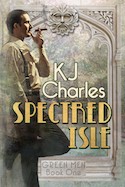
Spectred Isle by KJ Charles (self-published: m/m historical fantasy)
If you’re a fan of historical fantasy, I can tell you this story’s tone is the exact midpoint between Jonathan Strange and Sorcerer to the Crown. If you aren’t a fan of historical fantasy, this is a marvelous place to start. Ex-WWI soldier and archaeologist Saul Lazenby is disgraced in the eyes of his government and disowned by his family. The only person who’ll hire him is a crackpot amateur occultist with a head full of magical nonsense, who drags him around London looking for odd legends and implausible incidents. At least it’s a living – until actual magical things start happening, and actual magician Randolph Glyde starts turning up in all the wrong places, looking cynical and sinful. Randolph is from a long line of English magicians, guardians of the old ways and servants of the country – not the government, but the land itself, which grants Green Men like Randolph significant powers and arcane responsibilities. One of which is to keep bumbling neophytes like Saul from meddling in magics they do not understand. Naturally he has to take an interest in the man. Surely it’s nothing to do with Saul’s haunted eyes or perfect top lip. Watching two guarded men trade arch Lost Generation banter while edging closer and closer to romance is deeply satisfying; the book’s wry, anguished, darkly witty prose will make it perfect for the coming rains of autumn.
“If only more of his work involved sinewy, sunburned, sensitive men, rather than people who lacked the common decency to die properly.”
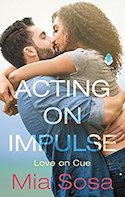
Acting on Impulse by Mia Sosa (HarperCollins: contemporary m/f)
This romance turns on the thematic tension between acting-meaning-performance and acting-meaning-doing. Carter Stone is sick of being typecast as the forgettable lead in television romcoms; he wants a serious part, one that will earn him respect and A-list status. Tori Alvarez is a physical trainer who hopes to start her own studio with a workout program accessible to bodies of all shapes, abilities, and income levels. She’s also reeling from a very public breakup with a very ambitious jerk, who played up their relationship in the media but constantly nitpicked her in private. Whipping rising star Carter into shape for a meaty role in a high-profile film would be great for business, but she doesn’t want her personal life anywhere near the limelight. Both are guarded in distinctly different ways: Tori is prickly and suspicious, while Carter uses affable charm as a defensive mechanism to keep people distracted from his real vulnerabilities. The book is an emotional roller coaster – tender wounds are poked at, families cause drama, careers take hits and recover – but the thing about roller coasters is the good ones have to have a lot of carefully laid out, sturdy structure underneath. What I’m trying to say is that the book feels both effortless and intricate, in the way of truly great genre offerings (Die Hard, Jurassic Park, Clueless) and I have very giddy expectations for the next in the series.
I make my living convincing audiences that love at first sight exists. Turns out I’m a shitty actor because there’s not much pretending involved. It happens. Because I’m pretty sure I’m experiencing it right now.
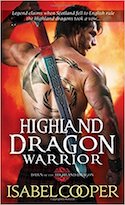
Highland Dragon Warrior by Isabel Cooper (Sourcebooks: historical fantasy m/f).
Isabel Cooper’s romances have a Lovecraftian edge – most notably her glorious debut No Proper Lady, a time-traveling tentacle-monster miracle best described as “Terminator 2 meets My Fair Lady.” Even without the tentacles, there’s always the sense that something sinister is muttering about blood in the shadows. This new book kicks off a medieval prequel series to Cooper’s Victorian-set Highland Dragon shifter books, which now that I write it out sounds like the most Peak Romance thing you can make without having to send a check to Colin Firth. The year is 1304 and our Scottish dragons are fighting hard in a doomed rebellion to cast off their recent conquest by the English king. By the time Jewish alchemist heroine Sophia is explaining to semi-immortal dragon shifter hero Cathal why the deer he just killed is not kosher, I was in love. This is a tender, slow-burn romance in a dark and eldritch world – more Gothic than grimdark, thankfully. The magic is delightfully medieval: herblore, sympathetic influences, planetary alignments, dream worlds. The plot is a trifle too straightforward but the richness of the atmosphere and the gentle power of the romance more than makes up for it. Bonus points for a big, burly, warrior hero who is also kind, careful of his strength, unsure of his leadership skills, and unshakeable in his belief in the heroine’s intellect.
“You swim in time,” she said with no bitterness and only a trace of envy. “We…we ration it and if we don’t count each drop, that’s only because we can’t.”
This month’s Heroine Who Is Definitely Going To Break That Vow Of Chastity
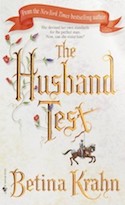
The Husband Test by Betina Krahn
Medieval-set romance novels can flirt more directly with fairy tales than most other subgenres. Betina Krahn’s lively and charming story about know-it-all novice nun Eloise and a blustery earl named Peril certainly has a lot of Grimm-approved elements: a curse that needs breaking, a realm in decline, a witch in the woods, an evil villain, plenty of daring rescues. But one moment in particular illustrates the way romance can subvert these much-repeated tropes even as it feeds on them. Eloise is an unruly, hands-on novice whose constant attempts to “improve” the convent have the abbess at her wits’ end. To get a little peace of mind, she contrives to send Eloise as a “husband judge” to the Earl of Whitmore, whose estate is in rough shape and in need of a “bride of virtue” to break a spurned woman’s curse. Eloise will judge the earl’s fitness as a marital prospect, and the abbess will then send him a bride from one of the high-born maidens the convent educates and protects. Eloise and Peril take an instant dislike to one another – but gradually, as they work to improve the estate and the lives of its tenants, they come to recognize the other’s value. Eloise sends a letter approving the earl’s character, and the abbess sends back a small wooden box with the message: “The earl’s bride is here.” Eloise opens it to find a mirror within – meaning, of course, that she is to marry the earl. It’s a classic riddle-solution, and any fairy tale version of this story would have ended right here.
In The Husband Test, this moment comes precisely at the halfway mark. Instead of being relieved and delighted – Eloise and Peril have already made out a couple times, and they’re clearly irresistibly into one another – our heroine is horrified. She’s spent her whole life among the nuns, expected to take her final vows at the end of this mission, and now they’re telling her she’s unfit. That they don’t want her. She is being cast out by the only family she’s ever known, and it is shattering. We know she’ll come to love her husband, and we know she’ll overcome the curse and end up beloved and blissful in her new role as lady of the manor. But that’s half a book away: right now we must witness Eloise mourn for the dream she’s cherished for a lifetime. Nisi Shawl in a recent column said that stories find their driving tension in “the gap between ‘What is’ and ‘What must be’” – and The Husband Test certainly thrives in that space.
Upcoming conventions and conferences
Emerald City Writers’ Conference: October 12–14: I have a deep, abiding affection for the Emerald City Writers’ Conference: it was my first conference as a baby romance writer, and I’ve served on the committee a few times in past years. The conference is organized by the Greater Seattle chapter of the Romance Writers of America and while the workshops have a strong romance bent, the craft and techniques being taught are by no means limited to romance writers. I’m particularly excited about this year’s list of research-track workshops (“Poisoning – Accidentally or On Purpose”) but I know I’ll end up somewhere unexpected and useful. This con has a national reputation for being friendly, welcoming, and valuable for writers at all levels; it is geared toward professional writers but opens free to the public at 6 p.m. on Saturday night for the Passport to Romance Reader Appreciation Event (spoiler: I’m one of the authors attending!), which is essentially a cocktail party for readers and authors alike. And we romance folks love a good cocktail party.
Further out on the calendar:
- Read With Pride Northwest: November 4 - 5
- JaneFest 2017: November 4
Kissing Books: the sunrise of your enemy
New column! Every month, Olivia Waite pulls back the covers, revealing the very best in new and classic romance. We’re extending a hand to you. Won’t you take it?
This month’s books show that in Romancelandia, enemies and villains are not precisely the same thing.
An enemy is a useful cog in any genre’s story machine. Opposing goals spark conflict, lead to arguments and struggles, and the straightforward kind of who’s gonna win this drama that so many books and movies and reality shows thrive on. Romance has featured volatile enemies ever since Beatrice and Benedick first traded insults, or since Elizabeth Bennet first told Mr. Darcy he could take his proposal and shove it somewhere thoroughly ungenteel (I paraphrase).
Darcy and Benedick, though, are not our story villains. That role goes to Don John (I love the blank and bitter Keanu Reeves portrayal. Fight me) and Wickham, that charm-vomiting lech. Villains are also useful to the plot – but villains are static, unpleasant, morally repulsive. Unredeemable.
Enemies, though, can be turned into lovers.
There’s a whole romance subgenre for this, called, with laudable clarity, enemies-to-lovers. In other words there is a whole species of book that exists to turn someone you hate into someone you love. Outsider views of mainstream romance often imagine both hero and heroine as idealized archetypes – the too-oft-expressed fear that frumpy housewives will catch Unrealistic Expectations from all those fuschia Fabio hunks assumes that romance heroes are always kind, protective, and sexually generous. On the page, though, romance heroes/heroines are frequently assholes. They scorn. They undermine. They loathe with the fire of a thousand suns.
And then…they learn. They change. They begin to defend each other, in private first and then in public. An enemy might make a mistake, or follow a bad principle, or operate under a misunderstanding – but they will repent this, and eventually find some way to atone. Love and respect blossom in the unlikeliest of places. When done well it feels like a sunrise breaking over the horizon of the heart.
So here’s to the enemies, the nemeses, the soon-to-be-cherished foes. They show us that hatred can be set aside. That opposition and conflict are not the same thing as evil.
They give us hope for one another. It’s what romance does best.
Recent romances

Sidebar by Carsen Taite (Bold Strokes Books: contemporary f/f.)
There was so much to like about this book. Judge Camille Avery is new to the federal bench and looking to make an impression. Her new clerk West Fallon would rather be saving the world but couldn’t break a promise to her mentor to serve the court system for one year. The heroines sparkle both alone and when together – which makes it a complete mystery why the book spends so much time keeping them separated. They honestly spent more time avoiding each other than they did falling in love, which makes the big Grand Gesture at the end ring terribly hollow. That said, this is a stellar example of what romance readers call competence porn, where part of the pleasure is watching the protagonists actually perform their fancy, exciting, difficult jobs.
Other girls dreamed of being president someday, but in her dreams she’d been wearing a black robe and seated beside eight other justices at the highest court in the land. This was just the first step, and she was determined to tread carefully.
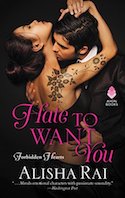
Hate to Want You by Alisha Rai (Avon Books: contemporary m/f)
Every so often an already strong author pulls out the stops and presents the world with a masterpiece. Jeannie Lin’s The Jade Temptress, for instance, or Earth Bound by Emma Barry and Genevieve Turner. And now Alisha Rai, because this is hands-down the best romance I’ve read all year. Sharp, sexy, funny, and achingly real, it’s the first in a trilogy of romances between two once-close, now-feuding families, the Kanes and the Chandlers, where the weight of secrets is almost Gothic. Everybody has something to hide; everybody has something to lose. Nicholas Chandler is an executive for the grocery chain his family used to co-own with the Kanes – before a fatal crash, a shady business deal, and a suspicious fire shattered the relationship. Nico is a dutiful son, a loving grandson, and a protective older brother 364 days out of the year. That last day belongs to Olivia Kane, his high school love whom he’s never gotten over. Now a successful tattoo artist moving from city to city, Livvy texts him one day a year for the furtive, desperate sex they can’t seem to stop having. But now Livvy’s back to care for her ailing mother, and with a town full of gossips watching, she and Nico will have to try to keep their distance and keep the walls up between their wounded hearts. You can guess how well that works. It’s glorious.
“You’re so damn stubborn, Livs.” “A stubborn marshmallow?” “All marshmallows are stubborn. Nothing that soft could hold its shape unless it was stubborn as hell.”
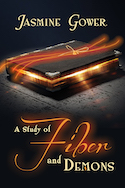
A Study of Fiber and Demons by Jasmine Gower (Less Than Three Press: fantasy m/m/f)
Academic infighting at a magical university: my absolute favorite thing in any genre. Fantasy romance often has more scope for moral flexibility, less shiningly heroic heroes, and this book takes full advantage of that liberty. Disgraced academic Alim is petty and bitter and more than a little shady – he’s also intelligent and ambitious and lonely, which together nicely temper his obvious faults. The romance is slow to start, but who cares when the bickering is so much fun? This is definitely one of the least optimistic romances I’ve read in some time – people are treacherous and self-serving, academia is corrupt at every level – but watching three uniquely terrible people come to care for each other and decide to be slightly less terrible is surprisingly satisfying. Plus squid-demons and an underwater city. It breaks my heart a little that the title and cover are not more representative of this book’s wit and charm.
“Now don’t be like that,” Alim said, but he didn’t push Liam’s hand away. “You’re my nemesis. What would people say?”
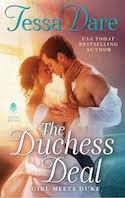
The Duchess Deal by Tessa Dare (historical m/f, Avon Books)
A Regency romp is like a glass of champagne: all sparkle and fizz. You can’t live on it, but the best ones make you wish that you could. This book strings a series of implausible events together with snappy dialogue and dazzling chemistry. There are anachronisms, but to trot them out for pedantry’s sake would be like criticizing the Marx Brothers for unrealistic set design. This is a Technicolor romance version of Beauty and the Beast and Cinderella smashed together, with a dash of Batman thrown in for shits and giggles. And there are giggles, thanks to Dare’s genius for delightful turns of phrase. The wit makes familiar character types seem new again: the misanthropic, wealthy ducal hero with a scarred face, the open-hearted seamstress heroine with a spine of steel, snarky butlers, plucky urchins. A feel-good, laugh-out-loud confection for when you’re harried and heartsore.
“Do not harbor any illusions that my scars transformed me into a jaded, ill-tempered wretch. I was always – and shall remain – a jaded, ill-tempered wretch.” “Were you always this long-winded, too?”
This Month’s Romance Believes Black Lives Have Always Mattered
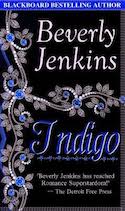
Indigo by Beverly Jenkins
To read a Beverly Jenkins historical is to see the veil drawn aside and a light shone down onto the past. The celebrated Queen of black American historical romance, she focuses on black heroes and heroines – most in the 19th century, though she also writes contemporaries – who are the architects of their destiny and staunch advocates for their race. Indigo is the story of Hester, a formerly enslaved heroine, and Galen, a wealthy black Creole hero, born free: both work for the Underground Railroad and fight against the shuddering cruelties of the chattel slavery system in 1856 Michigan. It’s common to say that historical romance’s appeal lies in its escapism – but it’s important to ask just who is escaping, and from what. Fantasies of vast aristocratic wealth and social power can exclude readers when those fantasies depend on the subjugation of entire groups of people, as shown in Tyrese L. Colman’s great recent essay on reading Jane Eyre while black. Beverly Jenkins is focused on a whole other kind of escape, both literally and figuratively. She offers readers visions of black community and shared purpose during a time when whitewashed historical narratives would have us believe all black folk lived in bondage, poverty, and fear. She gives respect, tenderness, and love to people who were too often met with violence, derision, and dehumanization. Her stories ring with rich details – Indigo is based on the true story of a free black man who sold himself back into slavery to be with the woman he loved; the book features a cameo by John Brown and shows characters supporting the Free Produce Movement. The question of whether slavery will end by law or by bloodshed looms large. All this plus heart-stopping adventure, swoony sex, and intrigue. Some classics grow rickety with the passage of time: this one only feels more and more vital as the weird time of 2017 weirds on.
Upcoming Conventions and Conferences
The second ever Historical Romance Retreat has a stellar lineup: Julia Quinn, Eloisa James, Elizabeth Essex, Jade Lee, and Delilah Marvelle, among others. Spokane’s Davenport Hotel is a uniquely charming venue and a perfect backdrop for expert historical garb – you’ve never seen anything quite like a ballroom full of historical romance fans dressed to the nines. In addition to author meet-and-greets and some truly tempting presentations (History of Medicinal Herbs! The Women of Pugilism! A tasting lecture on the history of port!), the schedule features a movie night, a Regency gambling night, a book fair, the Grand Ball, and an intriguing little calendar item called Absinthe and Abigails. The whole luxurious thing takes place September 27 - October 1.
Further out on the calendar
- The Emerald City Writers’ Conference: October 13 - 15
- Put Your Heart in a Book Conference: October 13 - 15
- Read With Pride Northwest: November 4 - 5
- JaneFest 2017: November 4
Kissing Books: Romance novels are important because people are important
New column! Every month, Olivia Waite pulls back the covers, revealing the very best in new and classic romance. We're extending a hand to you. Won't you take it?
Every first Thursday, this column will showcase four new romance releases and one revered classic or foundational influence from years past. All five books will end with a Happily Ever After, or at least a Happy For Now. (HEA and HFN for short — and now you’re in the know.) Many of these romances will be historicals; many will be LGBTQ; many will have a paranormal or SFF setting. Sometimes we’ll have all those things in one book, because I like all those things and romance is generous and full of gifts. Some books will be sugar-sweet with a single delicate kiss at the end; others will be hot enough that just cracking the cover will set off all the smoke alarms in a three-block radius.
No children will be imperilled, no women assaulted simply for shock value. The dogs will always live.
It’s no exaggeration to say I’ve loved this genre all my life. I stole my first romance novel from my mom’s shelf at the age of five – a kinky space opera romp by Johanna Lindsey. Imagine Jupiter Ascending starring Slave Leia and Conan the Barbarian, and you’ll have the general idea. Mom, appalled, took the book away when I was only halfway through. It took me ten pre-internet years to find another copy and get to that happy ending, but I did it. Romance readers: we’re unstoppable.
And I kept going. I read Julie Garwood in high school, Julia Quinn in college, and Jeannie Lin in grad school. I sold my first romance manuscript a year after graduating, watched my publisher go down in flames five years later, and started self-publishing my backlist in between writing longread analyses of individual books. You know, for fun. I have more romances on my shelves than I can possibly ever read, and more ideas for romance novels than I can ever write.
A mystery is at heart about justice, just as a science fiction story is about envisioning the future and fantasy is about imagining worlds profoundly different than the one we inhabit. Romance is the only genre whose formula is specifically and exclusively about people: the characters are strangers at the beginning and lovers at the end.
Romance novels are important because people are important.
And romance novels are at the center of a lot of people’s lives. Last week, on the farther coast, two thousand romance authors and industry professionals gathered for the Romance Writers of America’s annual national conference. This is not a fan event, but a professional one. Authors bought old friends rounds at the bar and swapped marketing tips with editors and self-publishers. They are mostly women, and along with all the craft and business workshops, they talked about feminism, about race and systemic bias in publishing, about disability and queerness and gender and religion. They have a great deal to say about women’s place in history, in literary culture, in the modern world and in the future.
Romance novels are good fun, and romance novels are big business. It’s a fascinating tangle of passion and money and meaning, and I’m so happy to be here to talk about it.
Recent romances:
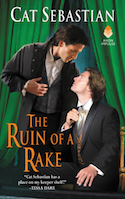
The Ruin of a Rake by Cat Sebastian (Avon Impulse: m/m historical)
Lord Courtenay is appallingly gorgeous, shockingly lewd, and socially outcast. Julian Medlock is upright, prim, and polished within an inch of his life. Each man openly loathes what the other stands for — so it’s a good thing for the romance that they’re both such frauds. This is a story about peeling back layers, about the walls people put up to defend their too-squishy hearts, about taking risks and making mistakes and trying again. Also the best example of sex-scenes-as-character-twist I’ve seen recently. If you like discovering the nurturing side of a Byronic hero, or watching a priggish accountant-type verbally cut someone to ribbons in his lover’s defense, this is your book.
Julian felt about Courtenay’s looks the way radicals thought about money: that it was deeply unfair and problematic for one person to possess such a disproportionate share.

Rogue Desire anthology by Adriana Anders, Dakota Gray, Amy Jo Cousins, Emma Barry, Stacy Agdern, Jane Lee Blair, Ainsley Booth, and Tamsen Parker (self-published: contemporary, various heat levels).
If you’re looking for escapist fluff you won’t find it here — the tone of this resistance-themed anthology is unsubtle, raw, anxious, and fierce by turns. Future historians and critics of romance fiction will make much of the way a certain orange malevolence lurks unnamed in the subtext. At times this book, so viscerally of-the-moment, poked too hard at wounds that are still raw and tender. At other times, though, the sublime gleams through. High points include Jane Lee Blair’s true-hearted pastor hero who cusses with sailor fluency, and Tamsen Parker’s sharp-sweet final story featuring a Jewish heroine whose working title was, no joke, “Hate-Pegging Conservative Josh Lyman.” Anthologies are always useful for testing out new-to-you authors, whether you like your books heavy on the sizzle (Dakota Gray) or populated by policy nerds (Emma Barry, who provided the advance copy. She knows my weaknesses far too well).
There was no excuse not to hold on with both hands when you found love. They’d work the rest out. First, though, they had to get through the sedition.
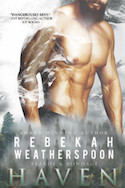
Haven by Rebekah Weatherspoon (self-published: erotic contemporary).
Rebekah Weatherspoon writes some of the best sex scenes around (and now has the Lambda Award to prove it). Her latest is the story of a smart-mouthed Manhattan fashion buyer and a surly, bearded tree of a mountain man: bonded by a shocking tragedy, they try to work out their tangled emotions through dark, beautifully nasty sex. It’s a terrible idea and everyone knows it, including our hero and heroine. This is BDSM romance for the advanced set, by an absolute mistress of the genre — the sex is certainly kinky, but the real danger is in the feelings. This couple’s story is like watching an avalanche in slow-motion: grand, strangely beautiful, and terrifying. I have read more extreme scenarios (Tiffany Reisz, anyone?) but never had my heart in my mouth quite this much. Readers in search of what slinks in the shadowy corners of the heart (and associated organs) will find this memorable and satisfying; those in search of less-intense fare should check out the candy-coated Sugar Baby novella trilogy or the juicy, queer-centric, pulpy fun of the Vampire Sorority Sisters series. (Rebekah created WOCinRomance to promote books written by women of color; I am both a Patreon supporter and a member of the monthly book club.)
“Push back turning you on?” she says as she slips on her bra. “A little bit.” “I mean, I can make today a living hell for you, you just say the word, Master Shep.”
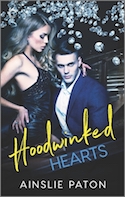
Hoodwinked Hearts by Ainslie Paton (Carina Press: contemporary)
Everything in this heist romance is dialed up to eleven. Imagine a thousand Leverage fanfics piled up high, covered in glitter and set on fire. Hero Cleve Jones is a master burglar and lifelong conman. Heroine Aria Harp is the one person he’s never lied to: his mentor’s rebellious daughter, a shaved-headed, scorpion-tattooed identity thief (!) with a mile-high chip on her shoulder. The story is brief and fiery and rough as a striking match. The prose is hyperbolic and luxurious with occasional sharp shocks of electric truth. At one point there is an extended theft-and-fart-joke scene that does for flatulence what Wodehouse does for hangovers. Ainslie Paton may well be allergic to literary restraint, but let’s not offer to cure her until she’s written a few more books.
Cleve didn’t duck. He said the words Aria warned him not to say, “I love you,” then he stood there like a stone monument to men too smart to know better, so she swung at him and connected with his jaw.
This month’s harlot heroine with a heart of gold
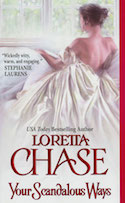
Your Scandalous Ways by Loretta Chase
This was the first Loretta Chase I read and it upended all my thoughts on what heroines could be/do in a Regency romance.
Even if she’s embroiled in some light scandal, the typical Regency heroine is virginal, earnest, and morally above reproach. Francesca Bonnard is none of those things. Not since her titled husband broke her heart, ruined her name, and divorced her by act of Parliament. Now Francesca is a notorious courtesan in Venice, seducing the crowned heads of the Continent and wearing spectacular jewelry and low-cut gowns to the opera five nights a week. Her first POV line is a showstopper: “Penises. Everywhere.”
Due to the scandal of divorce, Francesca is an exile, and she pines for the glitter and social whirl of London lost. It’s as though she’s grieving the loss of the romance-novel story of her first marriage — the ballrooms, the aristocratic suitor, the dazzling courtship. Francesca is an ex-heroine as much as she is an ex-wife.
Nevertheless, at the novel’s end, Francesca is once again wedded, wealthy, titled, and planning parties for the height of the Season. She is, after all, still the heroine of this romance novel. The text never punishes her for her sins or forces her into a humiliating repentance: instead, everything that British society holds against her (manipulating callow young royals, seducing the hot jewel thief next door, refusing to let men boss her around) helps her get to this second, better HEA. She may be a fallen women, but she’s neither broken nor weak.
It’s downright inspiring.